 Powering Nepal: 5 Decades of ADB–Nepal Partnership in the Energy SectorAmong the projects transforming Nepal's energy sector in terms of energy sufficiency and regional cooperation is the SASEC Power System Expansion Project, which is the largest energy project implemented by ADB in Nepal. The project will construct transmission lines that could evacuate up to 2 gigawatts (GW) of electricity from the Kali Gandaki and Marsyangdi river basins. It will also develop infrastructure to facilitate exports of at least 1.2 GW of power to India and scale up on- and off-grid renewable energy supply in Nepal. Another project, the SASEC Power Transmission and Distribution System Strengthening Project, will strengthen transmission substations to support electricity exports and upgrade medium-voltage and low-voltage distribution networks to provide quality and reliable electricity supply to 850,000 new and existing customers in Madhesh Province. Author: Asian Development Bank Year: 2024 Download Tags: Renewable Energy, Nepal, ADB, SASEC, India Asian Economic Integration Report 2024This report looks at how economic factors affect the movement of goods, people, and services across borders. As regional economies work to improve economic cooperation, initiatives such as the South Asia Subregional Economic Cooperation (SASEC) strive to improve cross-border trade and connectivity through such projects as the SASEC Chittagong–Cox’s Bazar Railway Project in Bangladesh and the SASEC Highway Enhancement Project in Nepal, and the Visakhapatnam–Chennai Industrial Corridor Development Program in India. Author: Asian Development Bank Year: 2024 Download Tags: SASEC, Transport, Economic Corridor Development, Bangladesh, India, ADB South Asia Development Update April 2024: Jobs for ResilienceGDP in South Asia is estimated to grow at 6.0% in fiscal year (FY) 2024 and 6.1% in FY2025, backed by strong growth in India and the rest of South Asia, outperforming other emerging market and developing economies. In Bangladesh, GDP growth is projected at 5.6% in FY2023-2024 and 5.7% in FY2024-2025; while Bhutan growth is projected at 4.9% FY2023-2024 and 5.7% in FY2024-2025. Robust growth is projected for India at 7.5% in FY2023-2024 and 6.6% in FY2024-2025. Growth will be on an upward trajectory for Maldives at 4.7% in FY2024 and 5.2% in FY2025; for Nepal at 3.3% in FY2023-2024 and 4.6% in FY2024-2025; and for Sri Lanka at 2.2% in FY2024 and FY2.5 in 2025. Author: World Bank Year: 2024 Download Tags: South Asia, GDP 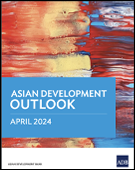 Asian Development Outlook (ADO) April 2024Robust growth is forecast for South Asia in fiscal year (FY) 2024, driven by strong gains in investments, consumption, and the electronics and services sectors. Gross domestic product (GDP) is estimated at 6.3% in FY2024 and 6.6% in FY2025 in South Asia. In Bangladesh, GDP growth is projected at 6.1% in FY2024 behind the growth of traditional low-end garments. Bhutan's projected GDP is at 4.4% given major developments in the country's hydropower sector. In India, GDP is forecast at 7.0% in FY2024, after a strong momentum in manufacturing and services in FY2023 and with exports expected to pick up in FY2025 with the rise in global growth. Growth in Maldives is estimated at 5.4% in FY2024 supported by tourism and construction. Nepal is estimated to grow at 3.6% backed by hydroelectric production and domestic demand. Amid recovery efforts in Sri Lanka, modest growth at 1.9% is forecast for the country in FY2024. In Southeast Asia, Myanmar’s GDP is projected to remain low at 1.2%. Author: Asian Development Bank Year: 2024 Download Tags: South Asia, ADB, Hydropower, Tourism, Bangladesh, Bhutan, India, Maldives, Myanmar, Nepal, Sri Lanka Financing Transport Connectivity in the BIMSTEC RegionFinancing Transport Connectivity in the BIMSTEC Region looks at how to finance an overhaul of transport infrastructure in the Bay of Bengal Initiative for Multi-Sectoral Technical and Economic Cooperation (BIMSTEC) subregion. The report identifies institutional gaps in the BiMSTEC regional institutions compared with regional institutions in the European Commission, Association of Southeast Asian Nations, and the South Asia Subregional Economic Cooperation (SASEC) partnership. Author: Asian Development Bank Year: 2023 Download Tags: ADB, South Asia, Transport, Regional Cooperation Open for Business: How Maldives Overcame the COVID-19 CrisisThe economy of Maldives, being reliant on tourism, went into recession due to border closures and travel restrictions during the coronavirus (COVID-19) pandemic. The pandemic called attention to the need for Maldives to diversify its economy to reduce short-term macroeconomic volatility. In addition, Maldives stands to benefit from setting up regional maritime connectivity for strengthening food trade with other South Asian countries. Author: Abdulla Ali, Elisabetta Gentile, Macrina Mallari, Thiam Hee Ng Year: 2023 Download Tags: ADB, Tourism, COVID-19, Maldives Energy Trade in South AsiaCountries are shifting to using green energy sources to meet their energy needs and cut emissions. While South Asia may have ample renewable energy and hydropower resources, demand exceeds local supply, and the countries have had to rely heavily on imports. To help improve energy security in the region, South Asian countries have signed bilateral and multilateral agreements to trade energy, including India-Nepal hydropower projects and the India-Bhutan hydroelectric joint venture. Author: CUTS International Year: 2023 Download Tags: Energy, Trade, South Asia, Hydropower, Bhutan, India, Nepal World Investment Report 2023 This report monitors global and regional foreign direct investment trends and national and international investment policy developments. Across South Asia in 2022, FDI inflows rose by 4.4% to $58 billion while FDI outflows rose by 1.1% to $16 billion. South Asia posted the largest increase in greenfield projects, with announced greenfield projects in India more than doubling in 2022. Author: United Nations Conference on Trade and Development Year: 2023 Download Tags: UNCTAD, Trade, South Asia Strengthening Regional Cooperation for Seamless and Sustainable ConnectivityLeast developed countries, landlocked developing countries, and small island developing states in Asia and the Pacific have been working to promote seamless transport to facilitate trade. Bangladesh, for example, has completed construction of the new Akhaura (Bangladesh) to Agartala (India) railway link, and has begun operations of Oxygen Express train carrying liquid medical oxygen as well as regular freight services between Haldibari in India and Chilahati in Bangladesh. Across South Asia, countries have also been rolling out an Electronic Cargo Tracking System under the United Nations Economic and Social Commission for Asia and the Pacific to make cargo movement more seamless. Author: United Nations Economic and Social Commission for Asia and the Pacific Year: 2023 Download Tags: Trade, South Asia, UNESCAP, Regional Cooperation, Sustainable Development Goals, Railway, Bangladesh, India Connecting to Compete 2023: Trade Logistics in the Global EconomyConnecting to Compete presents the findings from the latest data from the 2023 Logistics Performance Index (LPI) and its six component indicators: Customs, infrastructure, international shipments, logistics competence, tracking and tracing, and timeliness. The seventh edition, which now covers 139 countries, is released following unprecedented disruptions in supply chains amid the global coronavirus (COVID-19) pandemic. Author: World Bank Year: 2023 Download Tags: WB, Trade, Logistics, South Asia  Expanding Opportunities: Toward Inclusive GrowthGDP in South Asia is estimated to grow at 5.6% in fiscal year FY2023 and 5.9% in FY2024, backed by the recovery in services and lower commodity prices. GDP growth in Bangladesh will decelerate to 5.2% in FY2022-2023 due to global economic uncertainty, before recovering to 6.2% in FY2024. In Bhutan, GDP is projected to expand at 4.5% in FY2022-2023 as the further reopening of borders support growth in industry and services. GDP growth in India will moderate to 6.3% in FY2023-2024 following slower growth in consumption. Maldives is seeing a return to the tourism sector's pre-pandemic levels with GDP growth projections in FY2023 at 6.6%. Growth in Nepal will slow to 4.1% in FY2023 following import restrictions, before rising to 4.9% in FY2024. In Sri Lanka, amid fiscal and external imbalances, GDP growth is estimated at -4.3% in FY2023 and 1.2% FY2024. In Southeast Asia, the Myanmar Economic Monitor projects Myanmar's economic recovery accelerating to 3% in the year to September 2023 following growth in industry and services. Author: World Bank Year: 2023 Download Tags: WB, Bangladesh, Bhutan, Sri Lanka, Services, India, Maldives, Myanmar, Nepal Basic Statistics 2023Basic Statistics presents data on development indicators tracking progress toward the Sustainable Development Goals. The publication includes new data for development indicators for 46 economies in Asia and the Pacific, including those for the seven South Asia Subregional Economic Cooperation countries: Bangladesh, Bhutan, India, Maldives, Myanmar, Nepal, and Sri Lanka. Author: Asian Development Bank Year: 2023 Download Tags: Bangladesh, Bhutan, India, Myanmar, Maldives, Nepal, Sri Lanka, Sustainable Development Goals ADB Annual Report 2022In 2022, under the operational priority of Fostering Regional Cooperation and Integration, the Asian Development Bank (ADB) provided support for a $143-million program in Bangladesh to construct integrated customs stations and land ports at border-crossings to help increase trade volumes among South Asia Subregional Economic Cooperation (SASEC) countries. In India, ADB committed $300 million to upgrade district roads in Assam, which will reduce travel time to SASEC corridors. ADB is also supporting a nonsovereign loan that would improve communication network capacity and mobile services in Maldives. Author: Asian Development Bank Year: 2023 Download Tags: ADB, SASEC, Maldives, India, Bangladesh, Road 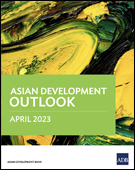 Asian Development Outlook (ADO) April 2023South Asia is projected to grow faster than other subregions in Asia, with real gross domestic product (GDP) estimated at 5.5% in fiscal year (FY) 2023 and 6.1 in FY2024. Growth within South Asia is expected to vary, with India projected to grow by 6.4% in FY2023 and 6.7% in FY2024 behind strong domestic demand. In Bangladesh, GDP growth is estimated at 5.3% in FY2023 owing to global economic disruptions and 6.5% in FY2024. In Bhutan, hydropower production will push up growth to 4.6% in FY2023 and 4.2% in FY2024. Growth in Maldives is estimated at 7.1% in FY2023 and 6.9% in FY2024, supported by a boom in tourism and construction. In Nepal, growth will slow to 4.1% this year before picking up in FY2024 at 5.0% with a recovery in tourism and infrastructure. Sri Lanka is projected to contract at -3.0% in FY2023 before recovering to 1.3% in FY2024 premised on debt relief and key reforms. In Southeast Asia, Myanmar's GDP will rise moderately to 2.8% in FY2023 and 3.2% in FY2024. Author: Asian Development Bank Year: 2023 Download Tags: South Asia, Hydropower, ADB, Bangladesh, Bhutan, India, Maldives, Myanmar, Nepal, Sri Lanka Asian Economic Integration Report 2023This report shows how smart trade and investment policies, and regulatory cooperation in the Asia and Pacific region can help economies tackle climate change, recover from the pandemic, and support resilient and sustainable development. Analyzing topics including global value chains, investment, the movement of people, and regional cooperation initiatives, it outlines the economic and environmental challenges the region currently faces. It explores how trade and investment policies can support climate action and highlights why a joined-up approach is essential to help deepen the digital economy, strengthen supply chains and foster greener businesses, markets, and trade. Author: Asian Development Bank Year: 2023 Download Tags: SASEC, Infrastructure, ADB, Connectivity, Climate Change, Global Value Chains, Trade Identifying Challenges and Improving Trade Facilitation in the States of Northeast IndiaThe northeast of India is shares international borders with Bangladesh, Bhutan, Nepal, and Myanmar and acts as a bridge for India's participation in global forums through the Bay of Bengal Initiative for Multisectoral Technical and Economic Cooperation and the South Asia Subregional Economic Cooperation program. This paper highlights challenges in global trade and suggests ways for improving trade with other countries in South Asia and Southeast Asia. Author: Sanchita Basu Das and Soumya Chattopadhyay Year: 2023 Download Tags: India, Trade Facilitation, SASEC, BIMSTEC, Transport, Bangladesh, Bhutan, Nepal, Myanmar Review of Maritime Transport 2022Ships carry over 80% of the volume of global trade. In South Asia, intraregional shipping connections increased as India improved its shipping connections to Pakistan, Sri Lanka, People's Republic of China, the Republic of Korea, Malaysia, Saudi Arabia, Singapore, and the United Arab Emirates. The most connected port in South Asia is the Colombo port in Sri Lanka; the Colombo port ranked the 24th best port in the world in 2021. Author: United Nations Conference on Trade and Development Year: 2022 Download Tags: India, Sri Lanka, Transport, Trade, Global Value Chains Role of Northeast Indian States in Shaping India's Logistics PerformanceThe Government of India launched the National Logistics Policy in 2022 to improve the ease of doing business in the country. The policy integrates infrastructure and network planning and aims to make logistics services and human resources more efficient. This paper explains the current status of logistics and connectivity in India as well as the northeastern region's potential to expand domestic and international trade. The paper also identifies opportunities and initiatives to improve logistics performance. Author: Bijaya Roy and Mihir Shekhar Bhonsale Year: 2022 Download Tags: India, Logistics, Regional Connectivity Leveraging Thematic Circuits for BIMSTEC Tourism DevelopmentThematic tourist circuits in the BIMSTEC region can help boost economic recovery from the pandemic and promote a return to pre-COVID-19 tourism growth. However, to fully realize the benefits of cross-border tourism and create thematic circuits, multiple issues need to be addressed throughout the region. This report focuses on COVID-19 recovery, infrastructure, marketing and products, human resources, policy, and investment areas, and recommends actions for each to help hasten the recovery and aid in creating thematic circuits. Author: Asian Development Bank Year: 2022 Download Tags: BIMSTEC, Tourism, COVID-19 BIMSTEC Trade Facilitation Strategic Framework 2030The BIMSTEC Trade Facilitation Strategic Framework 2030 suggests a structured pathway approach for enhancing the environment for trade facilitation among BIMSTEC member states. This framework outlines development of various soft infrastructure, hard infrastructure, and capacity-building strategies. It has also identified seven principles to guide implementation of the BIMSTEC Trade Facilitation Strategy, namely, (i) country ownership, (ii) results-orientation combined with pragmatism, (iii) flexibility and responsiveness to country needs, (iv) reform and modernization, (v) active participation and involvement of the private sector, (iv)partnerships with development partners, and (vii) mutual cooperation. Author: Asian Development Bank Year: 2022 Download Tags: BIMSTEC, Trade Facilitation, Infrastructure Asian Development Outlook (ADO) 2022 Supplement: Global Gloom Dims Asian ProspectsSouth Asia is projected to grow at 6.5% in fiscal year (FY) 2022 and 6.3% in FY2023. In Bangladesh, weak exports and high inflation are hampering recovery, while in Bhutan, agriculture and construction are projected to support economic growth. In India, growth is projected at 7.0% in FY2022 and 7.2% in FY2023, sustained by public reform and public and private investment. Maldives tourist arrivals and construction continue to pick up. In Nepal, the 2023 budget aims to improve agriculture, industry, and social protection. Economic contraction is expected in Sri Lanka with marked declines in industry and agriculture. In Southeast Asia, Myanmar maintains positive growth projections despite high rates of inflation. Author: Asian Development Bank Year: 2022 Download Tags: ADB, Agriculture, South Asia, Southeast Asia, Investment, Social Protection Trade and Development Report 2022South Asia is projected to expand at 4.9% in 2022 amid inflation and high energy prices. Balance of payment constraints in Bangladesh and Sri Lanka have led these countries to place restrictions on the consumption of electricity. In India, where the economy expanded by 8.2% in 2021, the easing of supply chain disruptions and the rise in domestic demand has led to a deceleration in growth. Author: United Nations Conference on Trade and Development Year: 2022 Download Tags: UNCTAD, Trade, South Asia Significance of Padma Bridge in South Asia's ConnectivityThe Padma Bridge will improve connectivity and increase trade in the Bangladesh. The bridge increases connectivity in Bangladesh and is projected to improve the quality of life among nearby communities. The economies of nearby countries also stand to benefit, as the bridge improves connectivity among Bhutan, India, and Nepal, and improves mobility of people, goods, and essential services. Author: CUTS International Year: 2022 Download Tags: Transport, Trade, BBIN, Bangladesh, Bhutan, India, Nepal Key Indicators for Asia and the Pacific 2022Key Indicators for Asia and the Pacific 2022 provides statistics on economic, financial, social, and environmental measures, as well as select indicators for the Sustainable Development Goals (SDGs). Statistics for Asian Development Bank's member countries include numbers for energy and electricity, transport and communications, and international trade. Author: Asian Development Bank Year: 2022 Download Tags: ADB, South Asia, Sustainable Development Goals  South Asia Economic Focus (Fall 2022) Coping with Shocks: Migration and the Road to ResilienceReal gross domestic product (GDP) in South Asia is projected to slow to 5.8% in fiscal year (FY) 2022 and FY2023. In Bangladesh, real GDP growth is projected at 6.1% in FY2022-2023, as higher inflation and rolling power outages dampen post-coronavirus economic recovery in consumption and investment. The easing of mobility restrictions is supporting Bhutan's recovery amid one of the highest vaccination rates globally. With slower domestic demand, real GDP forecast in Bhutan is set at 4.1% in FY2022-2023. In India, where exports and overall economic activity have recovered more strongly than the rest of the world, growth is forecast at 6.5% in FY2022-2023. In Maldives, real GDP is expected to grow by 12.4% in FY2022 and 8.2% in FY2023 on the recovery of tourism. Growth forecast in Nepal is set at 5.1% in FY2022-2023 amid normalization of monetary policy. Real GDP in Sri Lanka is projected at -9.2% in FY2022 and -4.2% in FY2023 due to a severe balance of payment crisis and risks posed by the country's political situation. Author: World Bank Year: 2022 Download Tags: WB, South Asia World Investment Report 2022 In 2020–2021, foreign direct investment (FDI) in South Asia fell by 26%, to $52 billion, with large mergers and acquisitions from 2020 not repeated in 2021. Flows to Bangladesh rose by 13% to $2.9 billion, while inflows to India declined to $45 billion. However, India announced new international project finance deals, including 23 in renewable energy. Outward FDI from South Asia, mainly from India, rose by 43% to $16 billion. Author: United Nations Conference on Trade and Development Year: 2022 Download Tags: UNCTAD, Trade, South Asia, Bangladesh, India, Renewable Energy  Asian Development Outlook (ADO) 2022 Update: Entrepreneurship in the Digital AgeGrowth forecast in South Asia is projected at 6.5% in fiscal year (FY) 2022 and FY2023. In Bangladesh, gross domestic product (GDP) growth is projected at 7.2% in FY2022 and 6.6% in FY2023, reflecting lower consumption spending. Growth in Bhutan is forecast to grow at 4.5% in FY2022 and 4.0% in FY2023 as government investment continues as a key driver of growth. In India, weaker than expected global demand is expected to affect growth, projected at 7.0% for FY2022 and 7.2% for FY2023. GDP growth in Maldives is forecast at 8.2% in FY2022 and 10.4% in FY2023 with continued tourism arrivals. In Nepal, GDP is projected at 5.8% in FY2022 and 4.7% in FY2023, affected in part by needed policy tightening to address rapid rise in imports. Contractions are projected for Sri Lanka, -8.8% in FY2022 and -3.3% in FY2023, likely resulting from severe macroeconomic challenges, including the impact of the ongoing crisis. In Southeast Asia, Myanmar's GDP is forecast at 2.0% in FY2022 and 2.6% in FY2023 owing to an improvement in economic activity. Author: Asian Development Bank Year: 2022 Download Tags: ADB, Bangladesh, Bhutan, India, Maldives, Myanmar, Nepal Economic and Social Survey of Asia and the Pacific 2022: Economic Policies for an Inclusive Recovery and Development Rapid economic growth in Asia and the Pacific in the last three decades have lifted many out of poverty, through improvements in agriculture and manufacturing. Nevertheless, many countries have experienced increases in inequality in their countries since the 1990s. This publication argues that Asia-Pacific countries should prioritize inclusive growth, by allowing those from all socioeconomic groups to improve livelihoods, incomes, and education. While fiscal and health challenges posed by the coronavirus pandemic present challenges, achieving inclusive recovery is still very possible. Author: United Nations Economic and Social Commission for Asia and the Pacific Year: 2022 Download Tags: UNESCAP, COVID-19, Trade  Reshaping Norms: A New Way ForwardSouth Asian countries are emerging from coronavirus (COVID-19) pandemic burdened by high inflation and fiscal imbalances, as well as external shocks. In Bangladesh, gross domestic product (GDP) is projected to increase by 6.4% in fiscal year (FY) 2021-2022 and 6.7% in FY2022-2023. In Bhutan, FY2021-2022 growth is estimated at 4.4% and FY2022-2023 growth at 4.7%, with the expected return of international tourists and migrant workers from India. In India, FY2022-2023 growth is projected at 8%, slightly below last year’s rate. Economic recovery in Maldives will stay strong in 2022, with real GDP growth expected to grow by 8.5% in 2022 and 9.1% in 2023. In Nepal, tourism has yet to recover, with growth projected at 3.7% in FY2021-2022 and 4.1% in FY2022-2023. Hydropower in Nepal is providing a natural hedge against increases in crude oil-based energy prices. Growth in Sri Lanka is hampered by a series of shocks amid high debt, with 2022 growth projected at 2.4%. Author: World Bank Year: 2022 Download Tags: WB, South Asia, Bangladesh, Bhutan, India, Maldives, Nepal, Sri Lanka National Single Window: Guidance NoteElectronic national single window systems help stakeholders meet trade and transit requirements. Single windows allow trade and transit sectors to send information to multiple agencies through one platform, thereby helping reduce processing time and the cost of doing business. This guidance note compiles information on planning and implementing national single window systems that help countries comply with international trade regulations. Author: Asian Development Bank Year: 2022 Download Tags: ADB, National Single Window, Trade, Transport Basic Statistics 2022Basic Statistics presents economic, environmental, and social indicators used to track progress toward the Sustainable Development Goals. The publication includes new data for development indicators for 46 economies in Asia and Pacific, including those for the seven South Asia Subregional Economic Cooperation countries: Bangladesh, Bhutan, India, Maldives, Myanmar, Nepal, and Sri Lanka. Author: Asian Development Bank Year: 2022 Download Tags: Bangladesh, Bhutan, India, Maldives, Myanmar, Nepal, Sri Lanka, Trade, Sustainable Development Goals, Renewable Energy 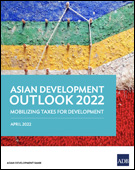 Asian Development Outlook (ADO) 2022: Mobilizing Taxes for DevelopmentGrowth in South Asia is projected to remain strong at 7.0% in FY2022 and 7.4% in FY2023 as the region’s economies try to catch up to pre-pandemic levels. In Bangladesh gross domestic product (GDP) growth is projected at 6.9% in FY2022. Growth in FY2023, projected at 7.1%, will be driven by private consumption. Bhutan is forecast to grow at 4.5% in FY2022. Growth will accelerate to 7.5% in FY2023 with the reopening of international tourism in the country. India is forecast to grow at 7.5% in FY2022 and 8.0% in FY2023, buoyed by strong investment growth. GDP growth in Maldives is forecast at 11.0% in FY2022 and 12.0% in FY2023 with continued tourism arrivals. In Nepal, fiscal stimulus and wider vaccination coverage will support growth, projected at 3.9% in FY2022 and 5.0% in FY2023. Sri Lanka's growth is forecast to slow to 2.4% in FY2022 and pick up to 2.5% in FY2023 amid low foreign exchange reserves. In Southeast Asia, Myanmar’s economy is forecast to contract in FY 2022 on protracted political instability. Myanmar GDP is forecast at -0.3% in FY2022 and 2.6% in FY2023. Author: Asian Development Bank Year: 2022 Download Tags: ADB, Bangladesh, Bhutan, India, Nepal, Sri Lanka, Maldives, Myanmar Regional Cooperation and Integration in Asia and the Pacific: Responding to the COVID-19 Pandemic and "Building Back Better"Platforms for regional and subregional cooperation helped spur collective action to help Asia and the Pacific build back resiliency from the coronavirus disease (COVID-19) pandemic. Regional cooperation platforms such as the South Asia Subregional Economic Cooperation program helped countries respond to the COVID-19 emergency. In South Asia, partners will have the opportunities to support regional market development through transport corridors, trade facilitation, and cross-border energy trade post-COVID-19. Author: Asian Development Bank Year: 2022 Download Tags: ADB, Bangladesh, COVID-19, Economic Corridor Development, Energy, India, Trade Facilitation, SASEC, ADB RCI 2022 , ADB RCI Asian Economic Integration Report 2022: Advancing Digital Services Trade in Asia and the PacificAs of December 2021, 73 South Asia Subregional Economic Cooperation (SASEC) projects worth $17.43 billion had been financed. The SASEC Program was able to sustain its momentum in 2020 and 2021 in spite of setbacks brought about by the coronavirus pandemic. In 2020–2021, the Asian Development Bank (ADB) committed $2.36 billion for 13 regional cooperation and integration projects in the subregion, including five transport projects, three energy projects, and five multisector/economic corridor projects. The SASEC Secretariat is reviewing the progress of the SASEC Vision initiatives to help make coordination mechanisms more effective and to improve resource mobilization. Author: Asian Development Bank Year: 2022 Download Tags: Trade, SASEC, ADB, COVID-19, Regional Cooperation Asian Development Outlook (ADO) 2021 Supplement: Recovery ContinuesSouth Asia’s economic growth is projected at 8.6% for fiscal year
(FY) 2021, while the forecast for FY2022 stands at 7.0%. In Bangladesh,
exports and imports grew due to rising global demand in clothes. In India,
gross domestic product (GDP) growth remained strong, driven by growth
in private consumption and investments. Maldives saw an increase of 193.3%
in tourist arrivals from January to October in 2021 compared with
2020. In Nepal, GDP grew by 2.5% in FY2021 due to a rebound in
services. In Sri Lanka, GDP grew by 12.3% in the second quarter of
2021, with growth prospects for 2022 downgraded due to macroeconomic
challenges. Previously, in the Asian
Development
Outlook Update, the GDP of Bhutan and Myanmar were forecast to
contract in FY2021. Author: Asian Development Bank Year: 2021 Download Tags: South Asia, Export, ADB, Import Asia–Pacific Regional Cooperation and Integration Index: Enhanced Framework, Analysis, and ApplicationsThis report discusses the framework of the Asia–Pacific Regional Cooperation and Integration Index (ARCII), which has been revised to include digital connectivity and environmental cooperation. ARCII estimates have remained stable among Association of Southeast Asian Nations members and in the Greater Mekong Subregion, while it improved for Central Asia Regional Economic Cooperation Program countries. ARCII declined slightly for South Asia Subregional Economic Cooperation countries, though improvements and links with nearby subregions are expected from joint initiatives with the Bay of Bengal Initiative for Multi-Sectoral Technical and Economic Cooperation countries. Author: Asian Development Bank Year: 2021 Download Tags: Regional Cooperation, SASEC, BIMSTEC South Asia Economic Focus, Fall 2021South Asia continued to recover from the coronavirus (COVID-19) pandemic with growth set to rise by 7.1% in 2021 and 2022. Growth in Bangladesh is estimated at 6.4% in fiscal year (FY) 2021-2022 with the recovery of exports and private consumption. Bhutan GDP is projected to grow by 3.6% supported by migrant labor and public infrastructure projects. India is projected to grow by 8.3% in FY2021-2022 on the back of incentives to increase domestic demand and manufacturing. With the return of tourism in Maldives, the country’s output is expected to grow at 23.3% in 2021. Nepal GDP is estimated to grow by 3.9% as vaccination picks up and tourism and migrant worker flow recover. With pressure from the spread of the COVID-19 Delta variant in June 2021, real GDP in Sri Lanka is projected to grow by 3.3% in 2021. Author: World Bank Year: 2021 Download Tags: South Asia, WB, COVID-19 Field Diary Chattogram Port: Transition from National to Regional Transportation HubThis study conducted by CUTS International, India, in collaboration with Unnayan Shamannay assesses infrastructure and trade logistics at Chattogram Port, Bangladesh. Chattogram Port is considered the maritime gateway of Bangladesh, with nearly 90% of Bangladesh trade passing through through the port. The study noted points of conflict between policy and practice while stakeholders identified the support needed to ensure that regional multimodal connectivity delivers its projected benefits. Author: CUTS International Year: 2021 Download Tags: Bangladesh, Trade Policy, Ports Reforming Port Processes in India for Logistics EfficiencyResearchers undertook port-process mapping at Jawaharlal Nehru and Vishakhapatnam ports, two key export–import gateways in India, to help identify strategic reform and potential solutions to improve port systems in the country. This brief recommends streamlining and digitizing port logistics and operations in India to help reduce logistics cost and make operations more efficient. Author: Asian Development Bank Year: 2021 Download Tags: ADB, India, Customs, ADB RCI Field Diary Phuentsholing: Largest Commercial Hub in BhutanThis study assesses infrastructure and trade logistics in Phuentsholing, Bhutan. It observed that several South Asia Subregional Economic Cooperation (SASEC) projects have helped develop trade and transport in Phuentsholing through the construction of four-lane roads and bridges. The study proposes ways to promote multimodal connectivity among the BBIN countries (Bangladesh, Bhutan, India, and Nepal), such as the further improvement of ports and related facilities in Phuentsholing to handle an increase in trade and transport. Author: CUTS International Year: 2021 Download Tags: Bhutan, SASEC, Trade, Transport, BBIN Key Indicators for Asia and the Pacific 2021Key Indicators for Asia and the Pacific 2021 provides updated statistics on economic, financial, social, and environmental measures as, well as select indicators for the Sustainable Development Goals (SDGs). Statistics are for 49 regional members of the Asian Development Bank, including numbers for energy and electricity, transport and communications, and international trade. Author: Asian Development Bank Year: 2021 Download Tags: ADB, South Asia, Sustainable Development Goals Asian Development Outlook 2021 UpdateEconomic growth in South Asia is projected at 8.8% in 2021 while the outlook for next year has been raised to 7.0% from 6.6%. In Bangladesh, growth in fiscal year (FY) 2022 is projected to strengthen though still below pre-coronavirus pandemic levels. In Bhutan, gross domestic product (GDP) in FY2021 is estimated to have contracted by 3.4%; growth is forecast to rebound to 3.7% in FY2022. The projection for India is downgraded to 10.0% from the earlier projection of 11.0% in FY2021, while the outlook for FY2022 improved to 7.5% from 7.0%. Tourist arrivals in Maldives increased by 33.4% year on year in 2021. In Nepal, GDP growth is estimated at 2.3% in FY2021. In Sri Lanka, GDP growth forecasts are revised down to 3.4% in 2021 with risks from fresh pandemic outbreak and currency related stress. Author: Asian Development Bank Year: 2021 Download Tags: ADB, COVID-19, South Asia, Bangladesh, Bhutan, India, Maldives, Sri Lanka Quarterly Dossier: Catalytic Multi-modal Connectivity Initiatives in the BBIN Sub-regionVarious national, bilateral, trilateral, and subregional initiatives in multimodal connectivity in the Bangladesh-Bhutan-India-Nepal (BBIN) subregion support faster and safer trade and transport. These have multiple positive impacts, including those that improve delivery of services to deal with the coronavirus pandemic. This publication presents four stories that show the impact of infrastructure connectivity in BBIN countries. It provides an assessment of connectivity initiatives as well as suggestions to enhance the positive effects of these initiatives. Author: CUTS International Year: 2021 Download Tags: ADB, BBIN, COVID-19, Trade, Transport World Investment Report 2021Global flows of foreign direct investment fell by one third to $1 trillion in 2020 due to the coronavirus disease (COVID-19) pandemic. In South Asia, foreign direct investments rose by 20% to $71 billion in 2020, driven mainly by strong mergers and acquisitions in India. Inflows in Bangladesh contracted by 11% and in Sri Lanka by 43%, where inflows will take longer to recover. This report monitors global and regional investment trends to support national and international policymakers. Author: United Nations Conference on Trade and Development Year: 2021 Download Tags: COVID-19, Bangladesh, India, Sri Lanka, FDI, South Asia, Sustainable Development Goals, UNCTAD Beyond the Pandemic: Building Back Better from Crises in Asia and the PacificThe coronavirus disease (COVID-19) pandemic has interrupted trade and tourism worldwide, leading to job losses and rising poverty. Countries need to address weaknesses in economic and social protection systems, through national initiatives that can be supported by regional cooperation. United Nations Economic and Social Commission for Asia and the Pacific member countries endorsed the Action Plan to Strengthen Regional Cooperation on Social Protection in Asia and the Pacific. This provides a platform through which governments in South Asia could work together to help mitigate the impacts of the pandemic. Author: United Nations Economic and Social Commission for Asia and the Pacific Year: 2021 Download Tags: COVID-19, Regional Cooperation, South Asia, Trade, Tourism Basic Statistics 2021Basic Statistics 2021 presents development indicators—tracking the progress made by countries in achieving the Sustainable Development Goals. It includes data for 46 economies in Asia and the Pacific, including those for the seven South Asia Subregional Economic Cooperation countries: Bangladesh, Bhutan, India, Maldives, Myanmar, Nepal, and Sri Lanka. Author: Asian Development Bank Year: 2021 Download Tags: Bangladesh, Bhutan, India, Maldives, Myanmar, Nepal, Sri Lanka, Trade, Sustainable Development Goals, Renewable Energy Asian Development Outlook (ADO) 2021 Supplement: Renewed Outbreaks and Divergent RecoveriesGrowth forecast for South Asia has been downgraded to 8.9% for 2021, dampened by new surges of coronavirus disease (COVID-19) infections. Growth in exports and remittances backed economic activity in Bangladesh. In Bhutan, economic activity has slowed after local containment measures were enacted to control the spread of COVID-19. India's growth projection has been downgraded to 10.0% from 11.0% in 2021. Weak travel demand in Maldives and persistent infections in Nepal are hampering recovery in those countries. In Sri Lanka, restrictions brought about by a third wave of infections are slowing down tourism and other economic activity. With businesses and consumers in South Asia better able to adapt to containment measures, the adverse economic impact of COVID-19 surges is expected to be limited. Author: Asian Development Bank Year: 2021 Download Tags: COVID-19, Tourism, South Asia ADB Annual Report 2020The Asian Development Bank (ADB) 2020 Annual Report details operational and financial results. In 2020, ADB continued its support for the South Asia Subregional Economic Cooperation (SASEC) road corridor in Dhaka-Northwest in Bangladesh, committing $406.1 million in loans to strengthen trade. Under the SASEC program, ADB committed $200 million to support cross-border power trade by upgrading substations in Nepal in Khimti, Barhabise, and Lapsiphedi. ADB also committed a $150 million concessional loan to improve the safety and capacity of Tribhuvan International Airport and Gautam Buddha Airport to help revive Nepal's tourism industry and address the long-term economic effects of the coronavirus pandemic. Author: Asian Development Bank Year: 2021 Download Tags: COVID-19, Energy, Regional Cooperation, SASEC, Trade, Transport Dealing with Coronavirus Pandemic in the Bay of Bengal RegionBay of Bengal countries have been deeply affected by the ongoing coronavirus disease (COVID-19) pandemic. To cope, the countries should be able to secure vaccines at an affordable rate and ensure these are administered safely and securely. The countries could restore economic growth by strengthening regional cooperation in the public health sector and enhancing trade facilitation to augment resilience of the supply chain. Mitigation measures should also focus on reducing the cost of addressing the pandemic in the region. Author: Prabir De Year: 2021 Download Tags: Trade Facilitation, BIMSTEC, Trade Facilitation Assam as India's Gateway to ASEANAssam's location in northeast India offers opportunities for enhancing cross-border trade and developing regional economic corridors spanning Bangladesh, Bhutan, India, Nepal, and countries in Southeast Asia. By developing trade and economic corridors, Assam aims to build on its vision of becoming a $75 billion economy by 2025. Author: Asian Development Bank Year: 2021 Download Tags: ASEAN, Bangladesh, Bhutan, India, Nepal, Regional Cooperation, Trade, ADB RCI Making BIMSTEC a Regional Vehicle for Nepal's Economic GrowthThe Bay of Bengal Initiative for Multi-Sectoral Technical and Economic Cooperation (BIMSTEC) was established in 1996 with a permanent secretariat in Dhaka, Bangladesh. Nepal, which joined BIMSTEC in 2004, could achieve its goals of development and prosperity through the organization. Nepal could expand its trade, economy, business, investments, and cultural connections through connections with BIMSTEC member countries in South and Southeast Asia. Author: Sunil K.C. Year: 2021 Download Tags: BIMSTEC, Nepal, Trade Harnessing Inland Waterways for Inclusive Trade Among Bay of Bengal CountriesThe transboundary rivers Ganges, Brahmaputra, and Meghna create a vibrant water grid connecting Bangladesh, Bhutan, India, and Nepal. India has been developing fairways and river and multimodal terminals in the last few years. Further development of inland waterways in Bay of Bengal countries would create jobs and open opportunities for inclusive trade. Author: Veena Vidyadharan Year: 2021 Download Tags: Bangladesh, Bhutan, India, Inland Waterways, Nepal, Trade, Transport Regional Integration in Bay of Bengal Region in Post-COVID-19 PeriodBay of Bengal countries face similar challenges in facing the coronavirus disease (COVID-19) pandemic. By strengthening regional cooperation, countries could bring down costs brought about by the pandemic and help hurdle barriers to the flow of people, ideas, and trade in goods and services. This paper analyzes the possible economic losses caused by the pandemic in the Bay of Bengal region. It also looks at progress in regional cooperation and suggests ways for working together in dealing with the COVID-19 pandemic. Author: Prabir De Year: 2021 Download Tags: COVID-19, BIMSTEC, Regional Cooperation Learning from CAREC Corridors and Connectivity: Prospects for BBIN Sub-regionThis publication looks at Central Asia Regional Economic Cooperation (CAREC) corridors, drawing lessons for the Bangladesh, Bhutan, India, Nepal (BBIN) subregion. It also looks at the potential for multimodal connectivity between CAREC and BBIN countries. BBIN countries formed the South Asian Growth Quadrangle in 1996 and, with help from the Asian Development Bank, formed the South Asia Subregional Economic Cooperation (SASEC) program in 2001 to promote regional cooperation in transport and trade. The SASEC partnership later grew to include Maldives, Sri Lanka, and Myanmar. Author: CUTS International Year: 2021 Download Tags: BBIN, Connectivity, Economic Corridor Development, SASEC, Regional Connectivity, Trade Facilitation, Transport Regional Cooperation for Trade and Transport Connectivity in the Age of Pandemics in Asia and the PacificGovernments, border agencies, logistics companies, and traders have been studying how trade and transport facilitation measures may be used to maintain the flow of goods across borders. In South Asia, the South Asia Subregional Economic Cooperation (SASEC) Trade Facilitation Working Group and the SASEC Customs Subgroup, through SASEC’s Trade Facilitation Strategic Framework, have helped develop separate lanes for handling and releasing medicines and other critical goods. A SASEC technical assistance project is also being implemented to modernize cross-border e-commerce for micro, small and medium enterprises. Author: United Nations Economic and Social Commission for Asia and the Pacific Year: 2021 Download Tags: Trade, Transport, SASEC, Trade Facilitation Asian Economic Integration Report 2021: Making Digital Platforms Work for Asia and the PacificThis report reviews economic cooperation and integration in Asia and the Pacific. As of the end of 2019, ADB had committed a total of $13.77 billion to 60 projects under the South Asia Subregional Economic Cooperation (SASEC) partnership, including projects for improving transport connectivity, trade facilitation, and power transmission. In 2019, SASEC members revamped the SASEC Operational Plan 2016–2025 to prioritize narrowing gaps in the subregion’s transport and energy networks. The SASEC program focused on expanding multimodal connectivity to include maritime and inland water transport. Subregional health cooperation was strengthened in 2020 to improve access to health services in Asia and the Pacific. Author: Asian Development Bank Year: 2021 Download Tags: ADB, Regional Cooperation, SASEC, Transport, Trade Facilitation, Energy The Recover Better with Sustainable Energy Guide for South Asian CountriesThis guide under the Recover Better series from Sustainable Energy for All (SEforALL) highlights ways in which countries could attain long-term sustainable development. This report recommends South Asian countries to develop regional value chains through the South Asian Association for Regional Cooperation (SAARC) regional energy cooperation framework. The framework would help reduce costs and increase energy system resilience. By deepening cooperation, South Asian countries involved in the electricity trade would also reap many technical, economic, and environmental benefits. Author: Sustainable Energy for All Year: 2020 Download Tags: Renewable Energy, South Asia Reimagining Border Haats as Border Co-prosperity Zones Border Haats have been successful in increasing local livelihoods, improving cross-border microtrade, facilitating people-to-people contact, reducing informal trade, and enhancing border security. This paper argues that establishing border coprosperity zones, coupled with investments in infrastructure and technologies, could help promote connectivity and realize mutual growth and prosperity for Bangladesh and India. Author: Sabyasachi Dutta Year: 2020 Download Tags: Bangladesh, India, Border Haats, Bilateral Trade, Customs The Least Developed Countries Report 2020: Productive Capacities for the New DecadeThe coronavirus disease (COVID-19) pandemic is taking its toll on economies of least developed countries (LDCs). To help economies and aid their recovery from the pandemic, this report lays out proposed measures for improving productive capacities of LDCs. It looks at mechanisms for regional cooperation in the areas of green technologies, industry, and digital technologies. The report takes a look at regional integration schemes, such as the South Asian Free Trade Area, and discusses how these could be instrumental in the sustainable and inclusive recovery for LDCs. Author: United Nations Conference on Trade and Development Year: 2020 Download Tags: South Asia, UNCTAD, Least Developed Countries, Regional Cooperation, SAFTA COVID-19 and Transport in Asia and the Pacific: Guidance NoteThis guidance note outlines the effects of the coronavirus disease pandemic on the transport sector in developing Asia and the Pacific. In India, for example, rail freight traffic in April and May 2020 had decreased by 28% compared with demand in 2019. The publication shares possible measure for a post-pandemic recovery that provides greener and more resilient recovery. The publication also proposes regional cooperation bodies for coordinating cross-border freight and logistics and international air travel. Author: Asian Development Bank Year: 2020 Download Tags: ADB, Regional Cooperation, India, Transport, Logistics, ADB RCI 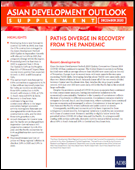 Asian Development Outlook (ADO) 2020 Supplement: Paths Diverge in Recovery from the PandemicThis publication provides updated economic forecasts for Asia and the Pacific. In South Asia, the earlier forecast of 6.8% contraction in 2020 is upgraded to 6.1%. Growth in South Asia is expected to return in 2021 at 7.2%. This is in line with improved prospects for India, where contraction is projected at 8.0% in 2020 and growth is projected at 8.0% in 2021. In Bangladesh, growth in exports and remittances backed economic activity. In Bhutan, the impact of the coronavirus disease (COVID-19) pandemic is expected to be greater than projected. Travel demand remains weak in Maldives and is hampering recovery. In Nepal, a persistent rise in COVID-19 infections holds back demand. Resurgent outbreaks in Sri Lanka’s export and tourist markets are expected to worsen contraction in 2020. Author: Asian Development Bank Year: 2020 Download Tags: South Asia, India, Bhutan, Sri Lanka, Nepal, Bangladesh, Maldives, Tourism, COVID-19, Export India-Bangladesh Coastal Shipping AgreementIn 2015, Bangladesh and India signed an Agreement on Coastal Shipping to promote two-way trade through the countries’ respective ports. Coastal shipping began the following year with MV Harbour 1, which carried a shipment of cotton from Chittagong Port, Bangladesh, to Krishnapatnam Port, India. This short briefing note describes the basic features of the India-Bangladesh Coastal Shipping Agreement and examines complementary initiatives. It discusses the benefits of direct container shipping services, the agreement’s socioeconomic impact, and the issues and challenges associated with the agreement. Author: CUTS International Year: 2020 Download Tags: India, Bangladesh, Trade Energy Insecurity in Asia: Challenges, Solutions, and Renewable EnergyThis book explores challenges in addressing energy insecurity in Asia. Bhutan, Myanmar, Nepal, and other energy surplus countries could export electricity and get huge economic gains, while Bangladesh, India, Sri Lanka, and other energy-deficient countries could grow faster by importing energy. Cross-border renewable energy projects could also reduce dependence on coal and oil and thus limit environmental damage. Author: Naoyuki Yoshino, Farhad Taghizadeh-Hesary, Youngho Chang, and Thai-Ha Le (editors) Year: 2020 Download Tags: ADB, Regional Cooperation, Renewable Energy Reimagining India’s Engagement with BIMSTECThis brief discusses the role that India can play in subregional integration by reimagining India’s economic relations with its Bay of Bengal Initiative for Multi-Sectoral Technical and Economic Cooperation (BIMSTEC) partners. Recent economic developments in the Asia-Pacific region provide context in the analysis presented in this report. By developing local value chains, India can pull the region closer amid competing economic needs. Author: Suparna Karmakar Year: 2020 Download Tags: India, BIMSTEC, Regional Integration New Approaches to Measuring and Assessing Regional Cooperation and Integration: Workshop HighlightsThis publication presents highlights from the Asian Development Bank (ADB) workshop on regional cooperation and integration on 16 and 17 April 2020. Discussions focused on approaches to measuring RCI and its implications for policy assessment. Mr. Ronald Antonio Butiong, Director, Regional Cooperation and Operations Coordination Division, South Asia Department, ADB, discussed regional integration indicators in South Asia Subregional Economic Cooperation (SASEC) member countries and outlined priorities for enhancing economic growth, improving social inclusion, and tackling poverty. Author: Asian Development Bank Year: 2020 Download Tags: Regional Cooperation, South Asia, SASEC, ADB, ADB RCI Summary of Proceedings of the 53rd ADB Annual Meeting of the Board of GovernorsThe Fifty-Third Annual Meeting of the Board of Governors of the Asian Development Bank (ADB) was held virtually in two stages in May and September 2020. Ms. Nirmala Sitharaman, Minister of Finance, India, called for the establishing of a regular South Asia Subregional Economic Cooperation (SASEC) meeting of finance ministers by 2021 to further strengthen regional cooperation. Mr. Ibrahim Ameer, Finance Minister, Maldives, noted how ADB has assisted Maldives through the SASEC National Single Window Project. Author: Asian Development Bank Year: 2020 Download Tags: SASEC, ADB, India, Maldives, Regional Cooperation, National Single Window Developing Multimodal Logistics Parks in IndiaMultimodal logistics parks (MMLPs) help bring down the cost of logistics and improve logistics performance by providing services in freight aggregation and distribution, multimodal freight transport, integrated storage and warehousing, technology support, and value-added services. This brief from the Asian Development Bank examines the potential of MMLPs to support supply chains in India and discusses the feasibility of MMLPs in Bengaluru and Guwahati. Author: Sabyasachi Mitra, Hoe Yun Jeong, Kavita Iyengar, Bhuwan Bhaskar Agrawal, Shreyans Jain, and Atu Sanganeria Year: 2020 Download Tags: ADB, Bangladesh, India, Logistics, ADB RCI World Trade Statistical Review 2020 World Trade Statistical Review 2020 presents the latest developments in world trade, with analysis of recent trends for trade in goods and services. The report examines the impact of the coronavirus disease (COVID-19) pandemic on international trade, and provides data on trade in least developed countries as well as in countries under the South Asian Free Trade Area. Author: World Trade Organization Year: 2020 Download Tags: SAFTA, South Asia, Trade Facilitation, Strengthening Freight Transport Corridors of South Asia in the aftermath of COVID-19The supply of food and medicine in South Asia relies on freight transport, affecting the lives and livelihood of millions of people in the region. Therefore the recovery of international freight transport will play a large role post-Coronavirus-19 economic recovery in the region. This report looks at policies that could help freight transport in South Asia bounce back from the health crisis and ensure that the sector becomes more resilient and sustainable. Author: United Nations Economic and Social Commission for Asia and the Pacific Year: 2020 Download Tags: 2019 Development Effectiveness ReviewThis report looks at the Asian Development Bank's (ADB) performance in achieving the goals set out in ADB's Strategy 2030. In 2019, ADB brought more focus to poverty reduction and inclusiveness. Many projects that were committed last year will also enable disability inclusion. For example, an administration and operations center to be built under the South Asia Subregional Economic Cooperation Port Access Elevated Highway Project will include features that will provide better services for persons with disabilities using Sri Lanka's port in Colombo. Author: Asian Development Bank Year: 2020 Download Tags: Basic Statistics 2020Basic Statistics presents select economic, environmental, and social indicators used to track progress toward the Sustainable Development Goals. It includes new data for development indicators for 46 economies in the Asia and Pacific region, including those for the seven South Asia Subregional Economic Cooperation countries: Bangladesh, Bhutan, India, Maldives, Myanmar, Nepal, and Sri Lanka. Author: Asian Development Bank Year: 2020 Download Tags: Sustainable Development Goals, Bangladesh, Bhutan, India, Maldives, Myanmar, Nepal, Sri Lanka Adapting the use of Asycuda World to the Covid-19 Situation: Guidelines to Customs AdministrationsCustoms administrations need to act decisively to prevent the spread of the coronavirus disease (COVID-19). The Automated System for Customs Data (ASYCUDA) World system helps cross-border agencies deal with the pandemic through procedures that limit virus transmission in work areas, while ensuring smooth cross-border movement of essential products. The system reduces the need for face-to-face interaction by allowing agencies and traders to exchange data, send and receive documentation, and expedite various trade transactions. Author: Automated System for Customs Data and United Nations Conference on Trade and Development Year: 2020 Download Tags: Customs, Trade, UNCTAD Enhancing Productivity for Poverty Reduction in India This brief looks at labor productivity in India and its impact on poverty reduction. It notes the need to bridge the infrastructure gap, improve the investment climate, and invest in education. Economic corridors would boost inclusive development, as these would act as markets for goods, help overcome infrastructure and regulatory bottlenecks, and aid dynamic reallocation. One such corridor is the Vizag–Chennai Industrial Corridor, which the Asian Development Bank is supporting with a $631 million loan. Author: Kanupriya Gupta and Abhijit Sen Gupta Year: 2020 Download Tags: ADB, India, Economic Corridor Development Digitalizing the Port Call ProcessThis study looks at the digitization of port call operations and the tensions and opportunities this digitization creates in the global maritime sector. One of the solutions being used to improve coordination of port call operations is Port Collaborative Decision Making (PortCDM), an international, independent system for near real-time digital data sharing. PortCDN technical guidelines, which can be adapted to regional and local needs, make processes more efficient by furnishing predictable port call timings and operations. Author: United Nations Conference on Trade and Development Year: 2020 Download Tags: Trade Facilitation, Transport Unleashing E-Commerce for South Asian IntegrationE-commerce is changing how transactions are made for goods and services. E-commerce facilitates international trade by reducing transaction costs. It also has the potential to be more inclusive of women, small businesses, and rural entrepreneurs. This report considers how e-commerce can be improved to deepen intraregional trade in South Asia. It looks at digital transacting models that reduce transaction costs and gives recommendations for regulatory reforms that could expand global participation by South Asian firms. Author: Sanjay Kathuria, Arti Grover, Viviana Maria Eugenia Perego, Aaditya Mattoo, and Pritam Banerjee Year: 2020 Download Tags: South Asia, Regional Cooperation, Regional Integration, Trade Facilitation Role of Multi-modal Connectivity in Fostering Value Chains in the BBIN Sub-regionThis report looks at how multimodal connectivity can strengthen regional value chains in the Bangladesh, Bhutan, India, Nepal (BBIN) subregion. It also provides a snapshot of various multimodal connectivity initiatives, such as the South Asia Subregional Economic Cooperation (SASEC) Road Connectivity Investment Program, the inland waterways agreement between Bhutan and Bangladesh, and the railway link between Raxaul (India) and Sirsiya (Nepal). Author: CUTS International Year: 2020 Download Tags: Bangladesh, Bhutan, India, Nepal, Rail, Road, Transport, SASEC Review of the ADB Clean Energy ProgramThis publication presents a review of the Clean Energy Program of the Asian Development Bank (ADB). It looks at what needs to be done in light of goals of mitigating climate change and promoting sustainable development. It also looks at the goals in terms of ADB’s Strategy 2030. Fostering regional cooperation and integration is among the operational priorities ADB has identified in Strategy 2030. ADB operations in the energy sector has promoted energy connectivity—such as through power interconnections in South Asia—and sharing best practices and technologies in renewable energy development. Author: Asian Development Bank Year: 2020 Download Tags: ADB, Energy, South Asia, Renewable Energy Asia's Journey to Prosperity: Policy, Market, and Technology Over 50 YearsThis book presents factors that can explain Asia's development performance. It looks at the role of policy, market, and technology in promoting trade and investment, infrastructure, and regional cooperation and integration (RCI). In South Asia, RCI has focused on connectivity through transport, energy, and trade facilitation. The Asian Development Bank has supported RCI by initiating several subregional programs, such as the Greater Mekong Subregion (GMS), the Central Asia Regional Economic Cooperation (CAREC), and the South Asia Subregional Economic Cooperation (SASEC). Author: Asian Development Bank Year: 2020 Download Tags: ADB, SASEC, Regional Cooperation, Trade, Energy ADB Annual Report 2019The Asian Development Bank (ADB) 2019 Annual Report details ADB’s operations, activities, and financial results over the year. ADB helps foster regional cooperation and integration through its support of the SASEC Program. In 2019, ADB committed $495 million to reduce travel times along regional corridors connecting Nepal with India and Bangladesh and improve connections to Sri Lanka’s international port under the SASEC Program. Author: Asian Development Bank Year: 2020 Download Tags: ADB, SASEC, South Asia, Regional Cooperation 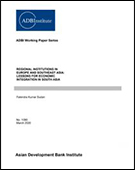 Regional Institutions in Europe and Southeast Asia: Lessons for Economic Integration in South AsiaThis working paper takes a look at the European Union (EU) and the Association of Southeast Asian Nations (ASEAN) as examples of regional institutions that were able to successfully foster economic growth and competitiveness. More specifically, the paper discusses the economic achievements of regional integration within the ASEAN and compares it with the EU. It offers lessons from the ASEAN integration that could help accelerate South Asian regional integration. It also examines the political and economic barriers hindering economic integration in South Asia, and emphasizes potential benefits regional integration and economic cooperation could bring to the South Asian Association for Regional Cooperation (SAARC) region. These include reduced economic dependence on developed countries, increased trade, and stronger economic growth in the SAARC region. Author: Falendra Kumar Sudan Year: 2020 Download Tags: Regional Cooperation, Economic Cooperation, EU, ASEAN, ADB RCI 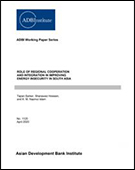 Role of Regional Cooperation and Integration in Improving Energy Insecurity in South AsiaThis working paper examines the literature on energy security in Asia. It gives an overview of resource constraints and the growth nexus in Asia, the scope for enhancing energy security, and the potential of regional cooperation to boost energy security. Wide disparity exists in energy security across the regions and between and within countries in Asia. With energy security critical to national security and access to natural resources, it is an important aspect of Asia’s long-term growth and development. This working paper puts forth that increasing regional cooperation can help improve access to energy among the energy-deficit developing countries in Asia, and benefit the region.It concludes that regional cooperation and integration promotes an interdependence network that ensures maximum use of renewable and non-renewable energy resources. This working paper also covers energy infrastructure development, investment needs, and potential sources of funding. Author: Tapan Sarker, Shanawez Hossain, K. M. Nazmul Islam Year: 2020 Download Tags: Energy Security, Energy, Renewable Energy, Trade Asian Development Outlook (ADO) 2020: What Drives Innovation in Asia?Growth in developing Asia is forecast to slow to 2.2% in fiscal year (FY) 2020 due to the effects of the global health emergency. In South Asia, growth will decelerate to 4.1% in FY2020 and rebound to 6.0% in FY2021 following a projected revival in India. Bangladesh is projected to grow by 7.8% this fiscal year and 8.0% in FY2021. GDP growth in Bhutan, despite lower tourist arrivals, will accelerate on high government spending. Growth in Maldives and Sri Lanka will be constrained this year due to weaker tourism. In Nepal, the outlook is for moderating growth. In Southeast Asia, Myanmar growth is expected to slow in FY2020 and pick up in FY2021. Author: Asian Development Bank Year: 2020 Download Tags: ADB, Bangladesh, Bhutan, India, Maldives, Myanmar, Nepal, Sri Lanka, Tourism, FDI 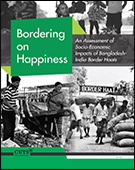 Bordering on Happiness: An Assessment of Socio-Economic Impacts of Bangladesh-India Border HaatsThis study on the border "haats" (market) between Bangladesh and India sought to understand and examine their impact on poverty alleviation. It considers different stakeholders, including vendors, vendees, transporters, laborers, officials, opinion leaders, villagers and residents on both sides of the border, from the four operational border haats between the two countries. It also compares the different trade performances of the four haats and discusses opportunities in each. Participation rate is also tackled, where the impact of transportation options or lack thereof on the regularity of attendance is discussed. The study has found that areas with border haats have formalized many informal trade. These have generated income and employment, benefiting local people positively and improving standards of living. They have also enhanced trade opportunities by offering vendors access to new markets, as well as a source of products they can resell in their own countries. Furthermore, border haats have promoted improved cross-border relations and security, and people-to-people connectivity. The study recommends further policy improvements to border haats, such as encouraging more women participation and upgrading common infrastructure that makes people-to-people connectivity more conducive. Author: CUTS International Year: 2019 Download Tags: Border Haats, India, Bangladesh Accelerating Regional Cooperation and Integration in Asia and the Pacific: 2017 Conference HighlightsRegional cooperation and integration (RCI) plays a critical role in accelerating economic growth, reducing poverty and economic disparity, and raising productivity and employment. This conference report looks at challenges for accelerating RCI in Asia and the Pacific, with a focus on economic corridors and emerging RCI initiatives. It underscores the importance of gateway ports to multimodal transport, such as the Port of Chittagong in Bangladesh under the South Asia Subregional Economic Cooperation (SASEC) program. The report also maintains that RCI technical secretariats, such as that for the SASEC partnership, are vital to fostering RCI across Asia and the Pacific. Author: Asian Development Bank Year: 2019 Download Tags: ADB, Economic Corridor Development, Regional Cooperation, Trade, Transport, SASEC Infrastructure Financing in AsiaThis book discusses how private financing can help address Asia’s infrastructure investment needs. In South Asia, public spending and public-private partnerships (PPP) may be leveraged for large infrastructure needs. Challenges that arise from each source of infrastructure financing—such as the long-term nature of PPP contracts—need to be addressed. Author: Asian Development Bank Year: 2019 Download Tags: ADB, South Asia Review of Maritime Transport 2019According to this report, total volume of global maritime trade reached an all-time high of 11 billion tons in 2018. However, growth was at 2.7%, below previous averages. In South Asia, the 10 most connected ports are in Sri Lanka, India, and Pakistan. Among which, the most connected port is Colombo in Sri Lanka, which serves as a transshipment hub for the region. The Mundra port in India saw the largest increase in the liner shipping connectivity index. Chittagong in Bangladesh is the world’s 14th most connected port, while Male in Maldives is 18th. Author: United Nations Conference on Trade and Development Year: 2019 Download Tags: South Asia, Sri Lanka, Ports, Trade Achieving Energy Security in Asia: Diversification, Integration and Policy ImplicationsThis publication reviews the status of energy security in Asia. In South Asia, countries face challenges in achieving energy security and climate goals. India and Bangladesh, for instance, face rising energy import bills while Maldives depends on oil products. The book suggests that countries and regions can achieve energy security through energy cooperation and diversification. This would lead to economic growth and poverty reduction, as well as mitigate energy security risks from climate change. Author: Asian Development Bank Institute and World Scientific Year: 2019 Download Tags: WB, India, Bangladesh, Maldives, Energy, Climate Change Doing Business 2020From May 2018 to May 2019, 294 regulatory reforms were implemented worldwide to make it easier to do business. India was among the countries that showed the most notable improvement in doing business during the period. South Asia had the highest share of economies that implemented cross-border cooperation reform, which ensures easy customs clearance procedures, harmonization of compliance rules, and border control efficiency. For example, Nepal opened a new integrated check post with India, thereby decreasing the time to import and export. Author: World Bank Group Year: 2019 Download Tags: WB, Ease of Doing Business, Customs, South Asia, Harmonisation Asian Development Outlook (ADO) 2019 Supplement, December: Growth Slows Further in Developing Asia’s GiantsDeveloping Asia's gross domestic product is projected to grow by 5.2% both in 2019 and 2020 as a slowing of global economic activity tempers regional growth, according to the Asian Development Outlook (ADO) 2019 Supplement. In South Asia, growth forecasts have been lowered to 6.1% in 2020. Strong remittances in Bangladesh will raise domestic demand, while in Bhutan, hydropower production rose to 3.1% in Q1 of FY2020 (ending 30 June 2020). Growth in India is expected to recover to 6.5% in 2020 with government policy measures, such as a corporate tax cutt and policy rate reduction. In Maldives, tourism remains strong. Foreign direct investments surged in Nepal while a recovery in economic activity is projected in Sri Lanka. Author: Asian Development Bank Year: 2019 Download Tags: ADB, South Asia, Hydropower, Tourism, Investment, Bangladesh, Bhutan, Maldives, Nepal, Sri Lanka World Bank East Asia and Pacific Economic Update, October 2019: Weathering Growing RisksAmid weakening global demand and policy uncertainty regarding trade tensions, growth in developing East Asia and Pacific region slowed in the first half of 2019. There is a need to address vulnerabilities and preserve economic dynamism in developing economies in the region. In Myanmar, GDP growth will reach 6.8% in 2021/2022 with the projected pick-up in agriculture. Policy measures to encourage investment, such as those for the energy sector, are expected to strengthen Myanmar’s manufacturing and construction sectors. Author: World Bank Year: 2019 Download Tags: Energy, Investment, Myanmar, WB Integrated Check-Posts on the India-Bangladesh Border: a Field Survey and Brief AnalysisIntegrated Check-Posts (ICPs) are designed to be one-stop solutions that house all regulatory agencies, including immigration, customs, and border security. India is in the process of establishing ICPs to efficiently manage crossings along its land borders. The country has identified 20 checkpoints for development as ICPs, including 10 that are on the India–Bangladesh border. This report studies the impact of the ICPs on activities along the India-Bangladesh border and suggests ways to improve efficiency of ICPs. Author: Joyeeta Bhattacharjee Year: 2019 Download Tags: Bangladesh, Customs, Trade Facilitation, India 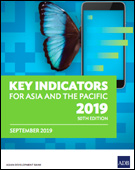 Key Indicators for Asia and the Pacific 2019This report presents the latest economic, financial, social, and environmental statistics, and includes sustainable development goals indicators, for the 49 regional members of the Asian Development Bank (ADB). Remittances have been a stable source of revenue for Asia and the Pacific, with India being the top recipient of remittances globally at $78.6 billion in 2018. In 2017, foreign direct investment (FDI) in the region rose to $541.9 billion, although FDI flows have been more volatile compared to remittance flows. This report uses domestic value-added via forward linkages (DVA_F) to discuss the evolution of global value chains in Asia. In 2018, almost a third of the DVA_F generated in Asia stayed within the region, representing 39.0% of the total domestic value-added sent to the region. It shows the importance of intraregional trade for Asia, as Asia's trade connection to North America is weakening. Author: Asian Development Bank Year: 2019 Download Tags: ADB, India, South Asia, Sustainable Development Goals, Trade International Rules and e-Commerce: Trade Insight, Vol. 15 No. 1–2, 2019Trade Insight is published by the South Asia Watch on Trade, Economics and Environment. This issue includes discussions on various aspects of e-commerce, such as cryptocurrencies, integration of small and medium enterprises, and competition and regulation. Its editorial argues that South Asia should take an active part in drafting global rules on e-commerce. The issue also includes features on the South Asian Association for Regional Cooperation investment agreement, Connectivity 2.0 for the South Asia Economic Union, the use of inland waterways, and the electronic cargo tracking system. Author: South Asia Watch on Trade, Economics and Environment Year: 2019 Download Tags: Electronic Cargo Tracking System, SAARC, Trade, Transport Bountiful Bangladesh: An Ocean of OpportunitiesThis special publication by the Bangladesh High Commission, New Delhi, India, celebrates India-Bangladesh relations. A chapter on regional cooperation discusses how prosperity is promoted in the region through the South Asia Subregional Economic Cooperation (SASEC). Progress in regional cooperation builds on the momentum generated in the last 18 years through SASEC. Economic performance has been impressive and South Asia is forecast to become the fastest growing subregion in Asia. Author: Bangladesh High Commission, New Delhi, India Year: 2019 Download Tags: Bangladesh, India, SASEC, Regional Cooperation Asia-Pacific Trade Facilitation Report 2019: Bridging Trade Finance Gaps through TechnologyThis report reviews the progress of trade facilitation in Asia and the Pacific. It looks at recent trends in paperless trade and transit facilitation and the impact of trade facilitation initiatives on trade costs. The Global Survey on Digital and Sustainable Trade Facilitation shows significant progress toward streamlining trade procedures in the Asia and the Pacific. In South Asia, the average implementation rate of trade facilitation procedures in 2019 is at 55.4%. The report features a special chapter on how trade finance gaps—especially prevalent for small and medium-sized enterprises—can be bridged by technology. Author: Asian Development Bank and United Nations Economic and Social Commission for Asia and the Pacific Year: 2019 Download Tags: Small and Medium Enterprise, South Asia, Trade Facilitation South Asia: Shifting Outlook Calls For Steadfast ReformsGrowth in South Asia is projected to rise to 7.0% in 2020. To create more and better jobs, the region needs to further strengthen reforms. Growth in Bangladesh is expected to remain strong at around 8.0% in fiscal year (FY) 2019, led by private consumption and investment. In Bhutan, economic activity will pick up to around 6.0% in FY2020, supported by private consumption. In India, gross domestic product (GDP) growth slowed to 6.8% in FY2018/2019. Economic activity in Nepal remains robust as FY2018/2019 growth reached 7.1%. In Maldives, growth has been supported by increasing tourist arrivals. Economic activity in Sri Lanka is projected to recover as the tourism sector stabilizes. Author: International Monetary Fund Year: 2019 Download Tags: Bangladesh, Bhutan, India, Maldives, Nepal, Sri Lanka, Investment, Jobs, Tourism Borders without Barriers: Facilitating Trade in SASEC CountriesBorders without Barriers presents an analysis of the state of trade facilitation in member countries of the South Asia Subregional Economic Cooperation (SASEC) program. The book includes an analysis of the state of trade facilitation in Bangladesh, Bhutan, India, Nepal, and Sri Lanka, as well as in Maldives and Myanmar. It identifies trade facilitation priorities in SASEC countries: implementation of trade facilitation agreements and other conventions; logistics and infrastructure development and regulatory reforms; coordinated border management; and institutions and capacity development. Author: Asian Development Bank Year: 2019 Download Tags: ADB, SASEC, Trade Facilitation Agreement, Bangladesh, Bhutan, India, Maldives, Myanmar, Nepal, Sri Lanka, ADB RCI Infrastructure Financing for Sustainable Development in Asia and the PacificThis book proposes adopting a more holistic approach to help accelerate infrastructure development in Asia and the Pacific. It discuses project financing for Nepal’s cross-border dry ports, streamlining Nepal’s trade and transit procedures through Automated Systems for Customs Data (ASYCUDA) and Advanced Cargo Information System (ACIS), and project financing by the Asian Development Bank of the Kakarbhitta dry port and a cross-country corridor project between Bangladesh and India. Financing and technical assistance from multilateral development banks and neighboring countries not only bridge funding gaps, these also help countries learn from funders’ experience constructing and operating infrastructure assets. Author: United Nations Economic and Social Commission for Asia and the Pacific Year: 2019 Download Tags: Infrastructure, Nepal, Sustainable Development Goals, UNESCAP Bridging the East: Trade and Transport Connectivity in the Bay of Bengal RegionBangladesh, Bhutan, India, and Nepal Motor Vehicles Agreement aims to reap the trade and economic potentials of the countries of South Asia. This study identifies hurdles to the successful implementation of the agreement through evidence-based advocacy and dialogue. The study highlights issues related to infrastructure, political economy, gender, and livelihood. Author: CUTS International Year: 2019 Download Tags: Trade, Transport, BBIN, BBIN Motor Vehicles Agreement, Bangladesh, India, Bhutan, Myanmar, Nepal 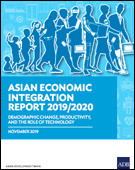 Asian Economic Integration Report 2019/2020: Demographic Change, Productivity, and the Role of TechnologyThis report reviews economic cooperation and integration in Asia and the Pacific. It reports that in 2018, the South Asia Subregional Economic Cooperation (SASEC) focused on reducing gaps in multimodal connectivity among its member countries. By the end of 2018, 52 ADB-financed projects worth $11.36 billion had been committed to SASEC projects, with an additional $106.44 million in 81 technical assistance grants. SASEC nodal officials and working groups met in Singapore in March 2018 to update the SASEC operational plan. The operational plan identified 77 projects ($45.6 billion) to be financed by SASEC members, ADB, and development partners. A holistic approach under the operational plan will build transport links with Southeast Asia and East Asia and expand regional trade markets. Author: Asian Development Bank Year: 2019 Download Tags: ADB, Regional Cooperation, SASEC, Trade Facilitation, Transport, Bangladesh, Bhutan, India, Maldives, Myanmar, Nepal, Sri Lanka Maritime Cooperation in SASEC: South Asia Subregional Economic CooperationMost South Asia Subregional Economic Cooperation (SASEC) countries rely on maritime transport for international trade. Stronger maritime relations are crucial to achieve the economic growth potential for the subregion. This report looks at how countries can strengthen international trade by improving maritime cooperation among the SASEC countries, comprised of Bangladesh, Bhutan, India, Maldives, Myanmar, Nepal, and Sri Lanka. It gives an overview of the SASEC maritime sector and identifies collaboration initiatives that could address key challenges. Author: Asian Development Bank Year: 2019 Download Tags: Transport, Trade Facilitation, Bangladesh, Bhutan, India, Maldives, Myanmar, Nepal, Sri Lanka, ADB RCI Asian Development Outlook (ADO) 2019 Update: Fostering Growth and Inclusion in Asia's CitiesGrowth in developing Asia remains strong despite the slowing down of international trade and a weakening of investments. In South Asia, growth momentum has slowed, with growth forecasts lowered to 6.2% for 2019 and retained at 6.7% for 2020. Growth in India has softened but is expected to bounce back to 7.2% in 2020. Bangladesh and Nepal performed better than projected. Bhutan’s growth slowed to 5.3% in fiscal year (FY) 2019 due to a decline in hydroelectric generation. Growth projection for FY2020 is retained at 6.0%. In Sri Lanka, growth forecast has been lowered for 2019 and 2020. Forecasts for Maldives is retained as tourist arrivals increased in the first half of 2019. In Southeast Asia, growth projections for Myanmar has been retained. Author: Asian Development Bank Year: 2019 Download Tags: Hydropower, ADB, Bangladesh, Bhutan, India, Maldives, Myanmar, Nepal, Sri Lanka Services for Trade Competitiveness: Country and Regional Assessments of Services TradeThis book applies methodologies for assessing competitiveness of countries’ services sector. It examines the types of barriers to services in the regulatory environment and identifies the policy implications. It aims to guide policymakers in the area of services in international trade. The chapter on diversifying Nepal’s economy assesses the country’s trade potential in services. Using the Services Trade Competitiveness Diagnostic toolkit, it identifies policy measures that can help Nepal identify strategies for greater integration in the global marketplace. Author: Claire Hollweg and Sebastian Saez, eds. Year: 2019 Download Tags: Energy, Nepal, Services, Trade, WB ASYCUDA Programme: Compendium of Case Studies 2019Through customs automation and reform projects, the Automated System for Customs Data (ASYCUDA) Programme contributes to the achievement of the Sustainable Development Goals and production of trade-related statistics. This compendium includes details of achievements and benefits reported by countries—including Bangladesh and Sri Lanka—after implementing ASYCUDA systems. The information suggests ASYCUDA is not just a technical assistance program but also a development program. Author: United Nations Conference on Trade and Development Year: 2019 Download Tags: Sustainable Development Goals, Bangladesh, Sri Lanka, Trade Global Economic Prospects, June 2019South Asia enjoyed solid economic activity in 2018 with gross domestic product (GDP) growth at 7% owing to strong domestic demand. Risks to the outlook include possible re-escalation of political uncertainties, financial sector weaknesses due to nonperforming assets, and fiscal challenges amid elections in several countries. Author: World Bank Group Year: 2019 Download Tags: WB, South Asia, Trade World Investment Report 2019This report monitors global and regional foreign direct investment trends and national and international investment policy developments. Foreign direct investments (FDI) in South Asia grew by 4% in 2018 to $54 billion, with India accounting for $42 billion. International cooperation in the development of special economic zones (SEZs) has been increasing. In developing countries, many SEZs are built through bilateral partnerships or as part of development cooperation programs. In South Asia, the number of SEZs is set to increase substantially. India has 200 new zones in the pipeline, while Bangladesh has 60, and Nepal 12. Author: United Nations Conference on Trade and Development Year: 2019 Download Tags: Bangladesh, India, Nepal, FDI, Investment, South Asia, UNCTAD Basic Statistics 2019Basic Statistics presents select economic, environmental, and social indicators used to track progress toward the Sustainable Development Goals. It includes indicators for development indicators for 46 economies in the Asia and Pacific region, including those for the seven SASEC countries: Bangladesh, Bhutan, India, Maldives, Myanmar, Nepal, and Sri Lanka. Author: Asian Development Bank Year: 2019 Download Tags: Bangladesh, Bhutan, India, Maldives, Myanmar, Nepal, Sri Lanka, Trade, Sustainable Development Goals, Energy Economic and Social Survey of Asia and the Pacific 2019: Ambitions beyond GrowthThe Asia-Pacific region needs an estimated $1.5 trillion per year to end poverty and hunger, provide basic health care, quality education, enabling infrastructure, and clean energy for all, and for climate action and living in harmony with nature. Available public and private resources make these ambitions affordable for most countries in the region. However, development partnerships and regional cooperation are needed for all countries to achieve these “ambitions beyond growth.” Author: United Nations Economic and Social Commission for Asia and the Pacific Year: 2019 Download Tags: Sustainable Development Goals, Bangladesh, Bhutan, India, Nepal, Maldives, Myanmar, Sri Lanka, Trade, Energy Connecting Corridors beyond Borders: Enabling Seamless Connectivity in the BBIN Subregion Trade connectivity is expected to bring economic growth and prosperity and reduce poverty in Bangladesh, Bhutan, India, and Nepal (BBIN). It will strengthen the economies of landlocked Bhutan and Nepal and give BBIN countries greater access to global markets for exports and imports. The Motor Vehicles Agreement will promote containerization of multimodal cargo movement, which will help reduce trade costs. This study identifies eight trade corridors in the BBIN countries and provides details on existing infrastructure, time-cost-distance analysis, and projected sociopolitical impact. Author: CUTS International Year: 2019 Download Tags: BBIN, BBIN Motor Vehicles Agreement, Transport, Bangladesh, Bhutan, India, Nepal Impact Evaluation of Energy Interventions: A Review of the EvidenceImpact evaluations in the energy sector has so far focused on rural electrification and improved cookstoves. However, most investments have been in power generation and transmission. This energy sector impact evaluation report assesses what has been produced against what might be possible. It summarizes outcomes of 85 impact evaluations of energy interventions in developing countries, including Bangladesh, Bhutan, India, and Nepal. It looks at evidence gaps and proposes future directions for impact evaluations in the energy sector. Author: David A. Raitzer, Nina Blöndal, and Jasmin Sibal Year: 2019 Download Tags: Energy, Bangladesh, Bhutan, Nepal, India 2018 Development Effectiveness ReviewThis report looks at the Asian Development Bank’s (ADB) performance in achieving the goals set out in ADB’s Strategy 2020. In its South Asia operations, ADB supported the linking of countries through transport connectivity. ADB has committed $180 million to rehabilitate the Kanchanpur–Kamala section of the East–West Highway in Nepal to promote safety and transport connectivity. It is also committed to a $150 million project through the South Asia Subregional Economic Cooperation Road Connectivity Investment Program to upgrade a section of the Asian Highway connecting Manipur, India, to Myanmar and construct an international bridge between India and Nepal. Author: Asian Development Bank Year: 2019 Download Tags: ADB, India, Jobs, Myanmar, Nepal, SASEC, Transport, Road Impact Evaluation of Transport Interventions: A Review of the EvidenceDevelopment of transport is integral to the development of economic corridors, regional economic integration, and trade. This publication reviews the impact of 91 transport interventions in developing countries, including Bangladesh, Bhutan, India, and Nepal. It summarizes the project outcomes, identifies evidence gaps, and presents proposals for future directions. Author: David A. Raitzer, Nina Blöndal, and Jasmin Sibal Year: 2019 Download Tags: Bangladesh, Regional Connectivity, Bhutan, India, Nepal, Rail, Road, Transport Renewable Capacity Statistics 2019This report provides renewable energy statistics for 2009–2018. It includes figures on total renewable energy capacity installed and connected by energy source (hydropower, wind energy, solar energy, etc.). It gives figures for capacity per region and per country, including those for Bangladesh, Bhutan, India, Maldives, Myanmar, Nepal, and Sri Lanka. Author: International Renewable Energy Agency Year: 2019 Download Tags: Renewable Energy, Bangladesh, Bhutan, India, Maldives, Myanmar, Nepal Exports to Jobs: Boosting the Gains from Trade in South Asia South Asia’s economy has grown while significantly reducing poverty. Yet concerns persist regarding growing joblessness and poor job quality. This report shows how increasing exports per worker could result in higher wages for skilled workers, while less-skilled and rural workers could benefit from new jobs. To spread benefits from higher exports, policies are needed to raise skills and get women and youth into better jobs. Author: Erhan Artuc, Gladys Lopez-Acevedo, Raymond Robertson, and Daniel Samaan Year: 2019 Download Tags: South Asia, Jobs, Trade ADB Annual Report 2018The Asian Development Bank (ADB) supports cross-border infrastructure to help foster regional cooperation and integration. It is transforming transport corridors into economic corridors, allowing South Asian countries to participate in regional and global value chains and promote agriculture trade. In 2018, ADB committed $150 million to upgrade sections of South Asia Subregional Economic Cooperation (SASEC) road corridors in India and Nepal. The investments aim to improve connectivity between Manipur (in India) and Myanmar; build an India–Nepal international bridge; and improve the safety of Nepal’s East–West Highway. ADB also approved a technical assistance project to build institutional capacity and improve expertise of trade facilitation officials in SASEC member countries. Author: Asian Development Bank Year: 2019 Download Tags: Economic Corridor Development, ADB, Energy, India, Nepal, SASEC, Trade Facilitation 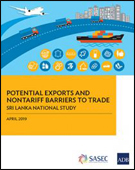 Potential Exports and Nontariff Barriers to Trade: Sri Lanka National StudyHow can Sri Lanka address nontariff barriers (NTBs) that hinder growth of its trade with Bangladesh, Bhutan, India, Maldives, and Nepal? The study examined the impact of sanitary and phytosanitary (SPS) and technical barriers to trade (TBT)-related nontariff measures enforced by SASEC countries to Sri Lanka’s exports with maximum potential, conducted a national diagnostic audit of the SPS and TBT infrastructure, and identified current SPS and TBT infrastructure capacity constraints. It considered options and opportunities to deal with the identified NTBs, including recommendations to improve Sri Lanka’s SPS–TBT infrastructure, and enhancing efficiency of SPS–TBT-related processes. Findings of the study could help formulate policies, laws, and institutions to address SPS–TBT-related NTBs and promote intraregional trade, as well as provide considerations for bilateral Free Trade Agreement negotiations. Additionally, the study provides traders with a comprehensive coverage of available export opportunities in Sri Lanka, and barriers they could encounter. Author: Asian Development Bank Year: 2019 Download Tags: Sri Lanka, Trade, Sanitary and Phytosanitary Measures, Technical Barriers to Trade, Non-Tariff Measures, ADB RCI Asian Development Outlook (ADO) 2019: Strengthening Disaster ResilienceDeveloping Asia is projected to grow at 5.7% in 2019 and 5.6% in 2020. South Asia is projected to bounce back in 2019 and 2020 from the previous year’s slowdown. India’s growth is expected to pick up to 7.2% in 2019 (from 7.0% in the previous year) on recovery in agriculture and strong domestic demand. Bangladesh is projected to grow by 8.0% in 2019. Bhutan is expecting modest growth while the outlook for Maldives is for growth to moderate. Nepal should expect stable growth in 2019 while Sri Lanka is projected to recover moderately. Inflation in South Asia is projected to rise to 4.7% in 2019. Growth should pick up in Myanmar in Southeast Asia. Author: Asian Development Bank Year: 2019 Download Tags: ADB, South Asia, Bangladesh, Bhutan, India, Myanmar, Maldives, Nepal, Sri Lanka SASEC Vision – MyanmarMyanmar serves as a land bridge between South Asia, Southeast Asia, and East Asia. This book identifies regional and subregional opportunities for Myanmar to harness natural and human resources, industrial potential, and infrastructure connectivity as part of the South Asia Subregional Economic Cooperation (SASEC) program. SASEC Vision – Myanmar serves to supplement the 2017 SASEC Vision document, which articulates shared aspirations of the SASEC countries and sets the path to achieve these through regional collaboration. Author: South Asia Subregional Economic Cooperation Program Year: 2019 Download Tags: SASEC, Trade Facilitation, Transport, Energy World Energy Outlook 2018Electricity demand is doubling in developing economies, led by India. This makes cleaner and affordable electricity central to economic development and emissions reduction. This report analyzes different pathways across various fuels and technologies. It looks at policies that could help reduce air pollution and meet global energy and climate goals. Author: International Energy Agency Year: 2018 Download Tags: Energy, India, Renewable Energy Review of Maritime Transport 2018Around 80% of volume of global trade are carried by sea and are handled by ports. According to this report, global maritime trade experienced its fastest growth in five years. Prospects for maritime trade are bright. However risks exist in the form of trade frictions, the global energy transition, etc. The report states that technological advances including artificial intelligence, blockchain applications, the internet of things, and autonomous ships and drones could potentially boost efficiency in global shipping. Author: United Nations Conference on Trade and Development Year: 2018 Download Tags: Cooperation, South Asia, Transport Asia-Pacific Trade and Investment Report 2018: Recent Trends and DevelopmentsThe Asia-Pacific Trade and Investment Report provides information and independent analyses of regional trends and policy developments in trade, goods, and commercial services. In 2018, the Asia-Pacific region increased its share of global merchandise trade. Intraregional and interregional trade also accelerated in Asia-Pacific. As trade among and with North, Central, and South Asia still involve high costs, more cooperation is needed on digitalization of trade processes. Author: United Nations Economic and Social Commission for Asia and the Pacific Year: 2018 Download Tags: South Asia, Trade Facilitation Agreement, WTO, SAARC, UNESCAP Doing Business 2019: Training for ReformA record 314 reforms were undertaken around the world, serving to improve business climate in the past year. South Asian economies carried out 19 reforms, many of which focused on improving starting a business, access to credit, paying taxes, and resolving insolvency. South Asia scored the highest for trading across borders. India continued its reform agenda and advanced 23 slots to 77th place in the global ranking, making it South Asia’s top-ranked economy. Bhutan introduced an online platform for filling corporate and personal income tax. Sri Lanka climbed to 100th place after instituting reforms on paying taxes and enforcing contracts. Author: World Bank Group Year: 2018 Download Tags: Ease of Doing Business, South Asia, Trade Facilitation, WB What Does It Cost to Trade Cross-Border?Customs duties, local taxes, and customs clearance increase trade costs and serve as obstacles for many small and medium enterprises. This paper explores challenges these enterprises face in using e-platforms and trading internationally. It looks at de minimis exemptions (the minimum value of goods below which no duties are collected) in India and other economies and analyzes the impact of these exemptions on exports by micro and small enterprises. Author: Sanjay Kumar Mangla Year: 2018 Download Tags: India, Trade Facilitation Sustaining Harbor Operation and Maintenance in MaldivesImproved inter-island connectivity plays a key role to achieving inclusive growth in Maldives. This Asian Development Bank brief explores investments in harbor infrastructure, operation, and maintenance in Maldives, and looks to understand the opportunities these provide, especially for women, and for poor and vulnerable groups in the country. Author: Andri Heriawan Year: 2018 Download Tags: ADB, Maldives, Transport World Energy Trilemma Index 2018Using global and national data, this report presents a ranking of countries’ energy performance in terms of energy security, energy equity, and environmental sustainability. The rankings show impacts of decisions and changes to suggest policy innovation that could help countries successfully navigate the energy transition. In South Asia, India was noted for increasing diversity of its energy generation while trying to meet rising demand. Bhutan attained 100% electrification in 2016, while Bangladesh increased energy access from 55% to 76% from 2014 to 2018, largely due to the use of micro and mini solar power systems. Nepal has achieved 91% electricity access and is on track to achieving 100% electrification by 2030. Author: World Energy Council Year: 2018 Download Tags: Energy, South Asia Asian Development Outlook 2018 Supplement: The Outlook Firms as Trade Conflict PausesGrowth forecasts for developing Asia stand at 5.8% in 2019. South Asia is still the fastest-growing subregion in developing Asia, while 2019 forecasts are revised down marginally at 7.1%. Bangladesh maintains its growth momentum with the expansion of exports and remittances. Growth in Bhutan has moderated while tourist arrivals grew strongly in Maldives. India exports are increasing along with the country’s industrial and agricultural output. GDP in Sri Lanka grew by 3.7% amid revived private consumption. In Nepal, exports surged by 16.1% while remittances grew to a record $2.1 billion. Author: Asian Development Bank Year: 2018 Download Tags: ADB, Bangladesh, Bhutan, India, Maldives, Nepal, Sri Lanka World Trade Report 2018: The Future of World TradeThe report looks at international trade and analyzes how digital technologies will reduce trade costs. It examines the internet of things, artificial intelligence, 3-D printing and blockchain, and speculates how these things will affect global trade in the next 15 years. It looks at indicators on South Asia and other regions to help evaluate each region’s preparedness for the digital age. Author: World Trade Organization Year: 2018 Download Tags: South Asia, Trade Facilitation Agreement, WTO Investment Climate Improvement in East Coast Economic Corridor of India: Regulatory, Institutional, and Policy Reforms Support to Tamil NaduThis paper summarizes a study that the Asian Development Bank (ADB) undertook upon the request of the Government of Tamil Nadu, India. The state sought to become a preferred investment destination with an investor-friendly business climate. The study identified policy, institutional, and process reforms to improve the ease of doing business in Tamil Nadu, including institutional and regulatory reforms needed for the East Coast Economic Corridor (ECEC) development. The study resulted in the implementation of an online single window mechanism that simplified and sped up processes for transparent and time-bound clearances for investors. Author: Asian Development Bank Year: 2018 Download Tags: ADB, Ease of Doing Business, Economic Corridor Development, India, Single Window, ADB RCI 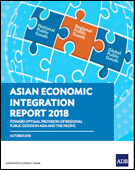 Asian Economic Integration Report 2018This report tracks the progress of regional cooperation and integration in Asia. It shows how intraregional trade grew in South Asia, Southeast Asia, and the Pacific. In South Asia, the South Asia Subregional Economic Cooperation (SASEC) has been focused on building multimodal connectivity to facilitate trade as one of its priorities. Its operational plan is being reviewed to better reflect regional project priorities in the region. SASEC is also studying how Myanmar, its newest member, is to be integrated as a vital link between South Asia, Southeast Asia, and East Asia. The chapter "Toward Optimal Provision of Regional Public Goods in Asia and the Pacific" looks at how collective action among countries can help find solutions for such transnational challenges as infrastructure connectivity, environmental degradation, and transnational health threats. Author: Asian Development Bank Year: 2018 Download Tags: ADB, Regional Cooperation, SASEC, Trade Facilitation South Asia Economic Focus, Fall 2018: Budget CrunchAmid a turbulent international environment, South Asia is expected to remain the fastest-growing region in the world. Growth in Bangladesh will be driven by consumption and public investment. In Bhutan, growth is expected to accelerate with the commissioning of two major hydropower projects. Growth in India firms up prompted by the adoption of the Goods and Services Tax and the recapitalization of banks. Maldives is projected to grow strongly based on dynamism in construction and tourism. Economic activity in Nepal is set to grow over the medium term while Sri Lanka’s economic growth will recover following 2017’s weather disruptions. The report highlights how growth performance is anchored on domestic consumption rather than private investment or exports. Author: World Bank Year: 2018 Download Tags: Bangladesh, Bhutan, Economic Growth, Exports 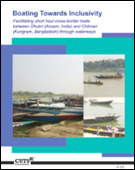 Boating Towards Inclusivity: Facilitating Short Haul Cross-border Trade between Dhubri (Assam, India) and Chilmari (Kurigram, Bangladesh) through WaterwaysIndia and Bangladesh use inland waterways to trade goods, mainly through three routes. The most active route is a portion of Protocol Route 1 between Kolkata, India, and Narayanganj, Bangladesh. This paper by Consumer Unity and Trust Society (CUTS) International explores how cross-border trade may be expanded along the stretch between Dhubri, India, and Chilmari, Bangladesh. Opening the route to small mechanized boats would offer livelihood opportunities to boat pilots, boat builders, vendors, small traders. Farmers will also have access to new markets across the border. The study highlights the need for an inclusive developmental approach that encourages cooperation in trade and connectivity and benefits marginalized communities. Author: Saurabh Kumar, Susan Mathew, and Veena Vidyadharan Year: 2018 Download Tags: Transport, India, Bangladesh, Trade, Connectivity Trade Profiles 2018This report presents key indicators on trade in goods and services, highlighting the major exports and imports for each economy as well as their main trading partners. It gives a snapshot of the importance of trade in the economy and gives information on total trade flows. The report includes trade profiles for 197 economies, including Bhutan, Maldives, Myanmar, and Nepal, and covers data on trade per capita, world ranking in exports and imports, and trade in commercial services. It also covers data on patent, trademark, and industrial design applications for each country. India ranks 8th in exports of commercial services, while Bangladesh ranks 49th in imports of merchandise. Sri Lanka ranks 69th in exports of commercial services. Author: World Trade Organization Year: 2018 Download Tags: Trade, WTO 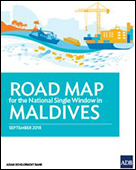 Road Map for the National Single Window in MaldivesThis publication outlines key steps to launching Maldives’ national single window (NSW) platform. An archipelago, Maldives’ geographic dispersion contributes to logistics and border control challenges. An NSW on a digital platform will allow all trade stakeholders to submit and access information on importing and exporting goods in a single place. It will streamline international trade procedures, minimize the time, effort, and resources needed to conduct trade, while helping the government maintain requisite controls. With current bottlenecks to trade in Maldives leading to some of the highest import and export costs in the South Asian subregion, leveraging on information and communications technology will help the country overcome physical and logistical barriers to trade, and significantly improve efficiency. More efficient trade procedures can lower the costs of imports, exports, and goods, and help drive economic growth. Author: Asian Development Bank Year: 2018 Download Tags: Maldives, National Single Window, ADB RCI World Investment Report 2018In India, foreign direct investment (FDI) inflows dropped from $44 billion in 2016 to $40 billion in 2017. Across South Asia, FDI inflows are predicted to stagnate or decline marginally in 2018. The global trend in FDI flows demonstrates the need for open, transparent, and non-discriminatory investment policies to maintain an environment conducive for investment. New types of industrial policies are emerging to respond to opportunities and challenges brought about by a new industrial revolution. This report examines investment policy tools available in the new environment. Author: United Nations Conference on Trade and Development Year: 2018 Download Tags: Connectivity, FDI, Global Value Chains, India, Investment, Policy, Sustainable Development Goals, South Asia, UNCTAD Infrastructure Financing in South AsiaSouth Asia is the world's fastest-growing region. The region has also shown significant reduction in poverty and income inequality owing to improved road transport, electricity, and sanitation. The growth is attributed partly to the improvement in infrastructure in Bangladesh, India, and Sri Lanka. Yet, to sustain growth and deal with climate change, the region must invest more to develop infrastructure in the next 15 years. This paper looks at public and private sector financing of infrastructure and discusses the factors driving infrastructure investment. Author: Shikha Jha and Rosa Mia Arao Year: 2018 Download Tags: Bangladesh, India, Sri Lanka, Energy, ICT, Infrastructure, Public Private Partnerships, Transport Reinvigorating Trade and Inclusive GrowthThis report offers insights into how trade benefits the poor, those in rural areas, micro, small, and medium-sized enterprises, and women. It also shows how productivity and living standards could be raised through greater openness in key areas, such as services trade and e-commerce. The report goes on to suggest that trade policies should aim to build greater openness and urge countries to reinvest in open, rules-based global trade. Author: International Monetary Fund, World Bank, and the World Trade Organization Year: 2018 Download Tags: India, Regional Cooperation, Trade Facilitation Agreement, WTO Key Indicators for Asia and the Pacific 2018This report presents the latest economic, financial, social, and environmental statistics for the 48 regional members of the Asian Development Bank (ADB). In 2017, foreign direct investment flows to developing Asia was stable, with 8.8% going to South Asia; energy gains were made in five of six countries in South Asia; and starting a business continues become easier in most developing ADB member economies following lowered regulatory costs and simplified compliance procedures. Nepal and Armenia experienced the most rapid annual growth rate at 7.5%, while India witnessed a 6.7% growth in GDP. Author: Asian Development Bank Year: 2018 Download Tags: ADB, Energy, Transport, Bangladesh, Bhutan, India, Maldives, Nepal, Southeast Asia, Sri Lanka BBIN: Opportunities and ChallengesThe Bangladesh, Bhutan, India, and Nepal (BBIN) initiative focuses on establishing connectivity, which have helped foster regional trade and improve sustainable resource management. This publication contains discussions held at the Young Thinkers' Conference, entitled "BBIN: Opportunities and Challenges," held in 2017 in Kolkata, India. The section "Strengthening Connectivity in the BBIN" looks at how connectivity in the subregion could be increased through several measures that address a number of logistical handicaps. "BBIN: The Way Ahead" examines the need for cooperation among the countries to achieve collective growth. Author: Anasua Basu Ray Chaudhury et al Year: 2018 Download Tags: Bangladesh, BBIN, Bhutan, India, Nepal BIMSTEC and Japan: Exploring Prospects for Renewed CooperationThe Bay of Bengal region is rising as an economic and strategic hub, with the Bay of Bengal Initiative for Multi-Sectoral Technical and Economic Cooperation (BIMSTEC) playing a key role in promoting growth and development in the region. BIMSTEC is also being seen as a potential driver of integration between South Asia and Southeast Asia. Given Japan's relationship with BIMSTEC nations, this brief makes a case for deeper engagement between Japan and BIMSTEC. The benefits could include cooperation in infrastructure, connectivity, and energy projects. A free trade agreement between the two entities would also be mutually beneficial. Author: Vindu Mai Chotani Year: 2018 Download Tags: ASEAN, Bangladesh, Bhutan, BIMSTEC, Connectivity, India, Myanmar, Nepal, Sri Lanka, Free Trade Agreements Asian Development Outlook (ADO) 2018 Update: Maintaining Stability Amid Heightened UncertaintyThis Update forecasts 6.0% growth for the region in 2018 and 5.8% in 2019. In South Asia, economic outlook remains optimistic. The region is expected to sustain its growth momentum, and meet projections of 7.0% in 2018 and 7.2% in 2019. Forecast for India is maintained at 7.3% in 2018 and 7.6% in 2019. Robust investment climate in Bangladesh is driving projections from 7.0% to 7.9% in 2018 and 7.2% to 7.5% in 2019, and in Nepal, from 4.9% to 5.9% in 2018. A drop in domestic demand lowers growth projections for Bhutan, from 7.1% to 6.7% in 2018 and 7.4% to 7.1% in 2019, and Sri Lanka, from 4.2% to 3.8% in 2018 and 4.8% to 4.5% in 2019. Author: Asian Development Bank Year: 2018 Download Tags: South Asia, India, Bangladesh, Nepal, Sri Lanka, ADB, Bhutan World Tariff Profiles 2018World Tariff Profiles 2018 presents comprehensive data on tariffs and non-tariff measures imposed by over 170 countries and customs territories. It provides data on tariffs imposed by these economies, in comparative tables and one-page profiles. This year's report presents a special analysis of least-developed countries’ (LDCs) use of preferential market access offered by trading partners. It highlights how LDCs benefit from preferential customs duties, and examines products eligible for preferential treatment, to show how members utilize preferential tariff schemes for LDCs and use other "competing" preferential duty arrangements. Author: World Trade Organization Year: 2018 Download Tags: LDC, Least Developed Countries, Customs, Trade Risk Management in Maldives: Sharing Practical Experience and Lessons LearnedMaldives is implementing reforms to improve risk management controls and to strengthen its trade environment. Risk management aims to determine which goods need to be examined in detail when entering a country. As government agencies improve service delivery, traders will benefit from reduced time to import and export goods, increased predictability of services, and greater ease of doing business. This report shows that improvements to risk management processes to deliver operational and economic gains in Maldives can be replicated across South Asia. Author: Asian Development Bank Year: 2018 Download Tags: Customs, Maldives, SASEC, Trade, ADB RCI The WEB of Transport Corridors in South AsiaThis book looks at how the economic benefits of investments in transport corridors could be amplified and how negative impacts could be minimized in South Asia. The book introduces an appraisal methodology that looks at the web of interconnected elements around corridors and assesses proposed corridors according to their potential to bring wider economic benefits (WEB). It uses case studies of past and recent corridor initiatives, and presents a simulation of the impact of the proposed Kolkata-Dhaka corridor. Author: Asian Development Bank, JICA, UKAID, World Bank Year: 2018 Download Tags: ADB, Economic Corridor Development, Gender, Regional Integration, Roads, Trade, Transport, WB, ADB RCI Connecting to Compete 2018: Trade Logistics in the Global EconomyConnecting to Compete summarizes the findings from the latest data from the 2018 Logistics Performance Index (LPI) and its six component indicators. The book aims to help countries frame policies by looking at supply chain performance and constraints in 100 countries, using data on time, distance and reliability; and ratings on domestic infrastructure quality, services, and border agencies. Among lower-middle-income countries, India stands among the top performers with an LPI score of 3.18 and ranked 44th. Author: Arvis et al. Year: 2018 Download Tags: India, Logistics How Would Cross-Border Electricity Trade Stimulate Hydropower Development in South Asia?South Asia uses only 20% its hydropower potential, estimated at more than 350 gigawatts. This report looks at regional electricity trade and examines the potential of hydropower development and trade in the region. It studies the importance of improving cross-border transmission interconnections to promote hydropower in South Asia. It also shows that large hydropower development would provide the additional benefits of irrigation and flood control that can be shared among neighboring countries, such as Bangladesh, India, and Nepal. Author: Govinda R. Timilsina Year: 2018 Download Tags: Bangladesh, Energy, Hydropower, Nepal, Regional Cooperation, South Asia, Trade World Trade Statistical Review 2018World Trade Statistical Review 2018 presents the latest developments in world trade, with analysis of recent trends for trade in goods and services. It looks at the performance of developing economies, where merchandise exports increased by 12% in 2017. The book also looks at value-added exchanges and digital trade, and provides data on trade-facilitating measures and on the implementation of regional trade agreements, such as the South Asian Free Trade Area. Author: World Trade Organization Year: 2018 Download Tags: Trade Facilitation Agreement, WTO, UNCTAD Economic and Social Survey of Asia and the Pacific 2018The Asia-Pacific region experienced rapid growth as inflation remained stable and firmer global demand supported a pickup in investments. In the South and South-West Asian subregion, there is an opportunity for greater trade integration. It is the fastest-growing subregion in Asia and the Pacific, with growth accelerating in all countries with the exception of India and Sri Lanka. In Bangladesh, large infrastructure projects and new energy initiatives drove strong domestic demand and backed the country’s robust growth. Author: United Nations Economic and Social Commission for Asia and the Pacific Year: 2018 Download Tags: Bangladesh, Sri Lanka, Infrastructure, Energy Strategy 2030: Achieving a Prosperous, Inclusive, Resilient, and Sustainable Asia and the Pacific Under its new long-term strategy, the Asian Development Bank (ADB) continues its efforts to eradicate extreme poverty while bringing focus to a vision of a prosperous, inclusive, resilient, and sustainable Asia-Pacific. ADB’s key operational priorities include the fostering of regional cooperation and integration, covering its support for enhancing connectivity and competitiveness, promoting regional public goods, and strengthening the financial sector cooperation. ADB also aims to strengthen subregional initiatives, such as the South Asia Subregional Economic Cooperation (SASEC) Program. Author: Asian Development Bank Year: 2018 Download Tags: ADB, Energy, Regional Cooperation, SASEC, Regional Integration, Connectivity Embracing the E-commerce Revolution in Asia and the PacificAsia is the world’s largest e-commerce marketplace. In South Asia, India has the largest e-commerce market at $33 billion in 2017. Maldives, Bhutan, and Sri Lanka lead the subregion in terms of percentage of the population with access to the internet. This report introduces a framework for analyzing the quality of e-commerce development in the Asia-Pacific region and discusses lessons learned regarding e-commerce development. The framework incorporates economic factors, institutional environment, and social acceptance to assess e-commerce development and suggest the way forward. Author: Asian Development Bank, United Nations Economic and Social Commission for Asia and the Pacific Year: 2018 Download Tags: ADB, ICT, Trade, UNESCAP, Maldives, Bhutan, Sri Lanka Asian Development Outlook 2018 Supplement: The Outlook Remains Stable South Asia continues to be the fastest expanding subregion, with growth on track to achieve forecasts of 7.0% in 2018 and 7.2% in 2019. India will meet April forecasts of 7.3% in 2018 and 7.6% in 2019. Owing to strong agricultural growth in Bangladesh and industry growth in Nepal, 2018 GDP growth in the two countries surpassed earlier forecasts. Decline in construction slowed Sri Lanka’s economic growth to 3.2% while hydropower production was lower than forecast in Bhutan. Cement, wood, and metal imports grew in Maldives. Author: Asian Development Bank Year: 2018 Download Tags: ADB, Bangladesh, Bhutan, Energy, Hydropower, India, Maldives, Nepal, Sri Lanka High-Speed Railway, Market Access, and Economic GrowthHigh-speed railway in the People’s Republic of China exerts positive impact effects on growth, where a 1% increase in market access leads to an increase of 0.12% in real income. Drawing insights from the effects of transport infrastructure in India, this paper suggests that high-speed railway could help promote regional cooperation and stimulate regional economic growth. Author: Wei Zou, Liangheng Chen, and Junke Xiong Year: 2018 Download Tags: ADB, Regional Cooperation, Transport, Railway Basic Statistics 2018Basic Statistics presents development indicators for 45 economies in the Asia and Pacific region, including those for the seven SASEC countries, Bangladesh, Bhutan, India, Maldives, Myanmar, Nepal, and Sri Lanka. It presents selected core indicators such as international and national poverty rates, inflation, and current account balance. It also presents information on indicators related to land, population, sustainable development goals, national accounts, money, balance of payments, reserves, external debt, and central government finance. Author: Asian Development Bank Year: 2018 Download Tags: Energy, ADB, Trade, Sustainable Development Goals, Bangladesh, Bhutan, India, Maldives, Myanmar, Nepal, Sri Lanka 2017 Development Effectiveness ReviewThis report serves as the Asian Development Bank’s (ADB) tool for monitoring and strengthening its progress. In South Asia, ADB’s $1.3 billion commitment to regional cooperation and integration (RCI) were spread across South Asia Subregional Economic Cooperation (SASEC) program’s priority areas: transport, energy, trade facilitation, and economic corridor development. Project preparation work will expand the $5 billion pipeline for RCI in the subregion with 26 projects planned for approval. SASEC finance ministers endorsed a joint vision of regional cooperation and connectivity. Myanmar’s addition to SASEC improved cooperation prospects between South and Southeast Asian subregions. Author: Asian Development Bank Year: 2018 Download Tags: ADB, Myanmar, SASEC, Transport, Economic Corridor Development East Asia Pacific Economic Update, April 2018: Enhancing PotentialEast Asia and Pacific (EAP) grew slightly faster than anticipated in 2017, with growth in Myanmar rebounding slightly at 6.4% due to strong exports. Amid risks to macroeconomic stability, EAP countries must enhance trade facilitation and integration, improve education systems, and upgrade capabilities of workers and managers. Author: World Bank Year: 2018 Download Tags: Exports, GDP, India, Manufacturing, Myanmar, Poverty Reduction, Trade Facilitation, WB Global Energy Transformation: A Roadmap to 2050The report details the needed energy technologies and analyzes the costs and benefits of energy transition in Asia and the rest of the world. All regions are projected to experience high growth in gross domestic product from the energy transformation. Mexico, Brazil, and India are expected to post the highest welfare gains, where pollution’s impact on health is projected to fall sharply. To accelerate the energy transition, governments could establish more bilateral and multilateral demonstration projects and encourage development of internationally harmonized technical standards to facilitate cross-border trade and exchange of technologies. Author: International Renewable Energy Agency Year: 2018 Download Tags: Climate Change, Renewable Energy, India, South Asia Trade Costs, Time, and Supply Chain ReliabilityTrade Costs, Time, and Supply Chain Reliability analyzes the effect of time on trade costs using shipment-level data from the Universal Postal Union. Distance and logistics performance are factors that affect transport times and uncertainty, which increase trade costs substantially. The paper suggests that by investing in improving connectivity, South Asia Subregional Economic Cooperation countries could reduce transport times and increase reliability to major markets. Author: Utsav Kumar, Ben Shepherd, and Roselle Dime Year: 2018 Download Tags: ADB, SASEC, Trade, Transport, ADB RCI Asian Development Outlook (ADO) 2018: How Technology Affects JobsDeveloping Asia is forecast to expand by 6.0% in 2018 and 5.9% in 2019. Growth in South Asia is expected to be revived after a two-year slowdown. India is expected to bounce back to 7.3% in 2018 and 7.6% in 2019 owing to the effects of tax and banking reforms and corporate deleveraging. Growth will be strong in the rest of South Asia, with a forecast of 7.0% in 2018 and 7.2% in 2019, but expansion will be affected in Bangladesh and Sri Lanka following a need to carry out revenue-enhancing fiscal reform and to strengthen economic policy. Inflation forecast in South Asia is 4.7% in 2018 and raised to 5.1% in 2019. Author: Asian Development Bank Year: 2018 Download Tags: ADB, Bangladesh, Bhutan, India, Employment, Jobs, Maldives, Myanmar, Nepal, Sri Lanka, Technology Renewable Capacity Statistics 2018This publication provides statistics on renewable power generation capacity for the last decade. It gives figures for global capacity, capacity per region, and capacity per country, including those for Bangladesh, Bhutan, India, Maldives, Myanmar, Nepal, and Sri Lanka. Figures include those for total energy generation capacity, total renewable capacity, and capacity by energy source (hydropower, wind energy, solar energy, etc.). Author: International Renewable Energy Agency Year: 2018 Download Tags: Hydropower, Renewable Energy, Bangladesh, Bhutan, India, Maldives, Myanmar, Nepal, Sri Lanka Trade Rules in E-commerce: WTO and IndiaRegulations for e-commerce is evolving in India and the rest of the world. This paper traces the growth of the e-commerce sector in India, developments in the WTO, and India’s position. It finds that while trade rules in India are more liberal than in other countries, India needs to address gaps and inconsistencies in the regulations. It also recommends that India join the negotiations on trade rules. Author: Arpita Mukherjee and Avantika Kapoor Year: 2018 Download Tags: ADB, India, Trade Facilitation Agreement, WTO Fostering Effective Energy TransitionThis report introduces the Energy Transition Index, which looks at the performance of energy systems in 114 countries and their readiness to transition to a secure, sustainable, affordable, and inclusive future energy system. The report shows that India has been improving electricity access. It also encourages countries to benchmark themselves against comparable groups in terms of development status and energy trade balance to identify best practices and develop applicable improvement plans. Author: World Economic Forum Year: 2018 Download Tags: Energy, India, Trade Trade Facilitation and Innovation: Evidence from South Asia Subregional Economic Cooperation CountriesThis paper looks at trade and its effects on innovation. Its analysis of firm-level data from Bangladesh, India, and Nepal shows that shorter trade times add competitive pressure from world markets and induces firms to innovate, hence associated with introduction of new products and new management systems. The results suggest that policies that improve trade facilitation would support long-term growth in South Asia Subregional Economic Cooperation countries. Author: Ben Shepherd, Utsav Kumar, and Roselle Dime Year: 2018 Download Tags: Bangladesh, India, Nepal, SASEC, Trade Facilitation Agreement, WTO, ADB RCI Financing Infrastructure in Asia and the Pacific: Capturing Impacts and New SourcesThis book looks at the impact of infrastructure investment on economic and social indicators, and shows how infrastructure investment can increase output, taxes, trade, and firm productivity. One study in the book shows that trade facilitation reforms in South Asia resulted in increased intraregional trade and trade with other regions. The book proposes innovative modes of financing for infrastructure needed to drive sustainable growth. Author: Naoyuki Yoshino, Matthias Helble, and Umid Abidhadjaev (editors) Year: 2018 Download Tags: ADB, Infrastructure, Services, South Asia, Trade Facilitation Transport Corridors and their Wider Economic Benefits: A Critical Review of the LiteratureThis paper reviews literature estimating the impact of large transport investments. It reviews 78 studies, 11 of which centers on infrastructure projects in India. The paper looks at the economic benefits of transport infrastructure projects to better understand how corridors could generate wider economic benefits, with a focus on roads, rails, and waterways. The review assesses the impact of transport corridor projects on economic welfare and equity, environmental quality, and social inclusion, and suggests a need for policies and institutions that address trade-offs. Author: Mark Roberts, Martin Melecky, Theophile Bougna, and Yan Sarah Xu Year: 2018 Download Tags: Economic Corridor Development, India, Infrastructure, Investment, Railway, Roads, Transport, WB The Digital Transformation and the Transformation of International TradeAs new modes of trade emerge from developments in the digital economy, new regulatory concerns arise regarding privacy, ensuring tax neutrality across different modes of trade, and competition. This paper considers the different approaches to these issues by different countries and country partnerships. It studies modes of trade in the digital era, categorizes concerns identified by stakeholders and governments, and reviews how regional trade agreements are working to address these concerns. Author: Dan Ciuriak and Maria Ptashinka Year: 2018 Download Tags: Trade, WTO Impact of Implementation of Digital Trade Facilitation on Trade CostsThis paper studies of the effect of the implementation of World Trade Agreement Trade Facilitation Agreement (WTO TFA) measures on trade costs in the Asia-Pacific region. Its analysis shows that full implementation of measures is associated with 15% reduction in trade cost. The paper also projects a 26% decrease in trade costs, amounting to $600 billion annually, with the full implementation of WTO TFA measures together with digital trade facilitation measures. It also looks at the need to develop legal and technical frameworks to support cross-border paperless trade, including the legal recognition of trade data and documents between public and private organizations in different countries. Author: Yann Duval, Chorthip Utoktham, and Alexey Kravchenko Year: 2018 Download Tags: Trade Facilitation, Trade Facilitation Agreement, WTO ADB Annual Report 2017The Asian Development Bank (ADB) 2017 Annual Report details ADB’s operations, activities, and financial results over the year. In South Asia, finance ministers from South Asia Subregional Economic Cooperation (SASEC) member countries launched the SASEC Vision, which sets a long-term strategy for inclusive growth for the region. ADB also signed seven SASEC projects worth a combined $1.33 billion, bringing SASEC’s cumulative investment portfolio to $10.72 billion. ADB helped form SASEC working groups for cross-border trade and supported economic corridors in Bangladesh, India, and Sri Lanka to facilitate trade and investment in South Asia. Author: Asian Development Bank Year: 2018 Download Tags: ADB, Bangladesh, Bhutan, India, Regional Cooperation, SASEC, South Asia Global Investment Competitiveness Report 2017/2018: Foreign Investor Perspectives and Policy ImplicationsThis report provides analytical insights and empirical evidence on foreign direct investment’s (FDI) drivers and contributions to economic transformation. Data are categorized by sector and geographic origin and destination of investment, including analysis for SASEC countries using data for Bangladesh, Bhutan, India, Myanmar, Nepal, and Sri Lanka. The report explores the potential of FDI to create growth for local firms, assesses the effectiveness of fiscal incentives in attracting FDI, and gives practical recommendations to developing countries. Author: World Bank Group Year: 2018 Download Tags: Bangladesh, Bhutan, FDI, India, Nepal, Sri Lanka, Trade, WB, Myanmar Services and Global Value Chains: The Asia-Pacific Reality, Studies in Trade, Investment and Innovation 89This book reviews issues concerning the roles of services in global value chains. It presents a framework for assessing links among different services and between services and the manufacturing sector. The book explains the contribution of services to global value chains in the Asia-Pacific region and to the world and also draws lessons with which countries could understand the importance of services and participation in global value chains to achieving sustainable development. Author: Witada Anukoonwattaka, Mia Mikic, Yuhua Zhang Year: 2017 Download Tags: ASEAN, Asia-Pacific, Energy, Global Value Chains, India, Nepal, Regional Cooperation, Sri Lanka, Sustainable Development, Sustainable Development Goals, Trade Facilitation, UNESCAP Harmonizing Electricity Laws in South AsiaMany in South Asia face electricity shortages that affect their socioeconomic development. But the region has a large hydropower potential and other energy resources that may be harnessed to drive growth in the region. This report looks at legal, regulatory, technical, and commercial requirements for energy trade to advance in the region, and gives recommendations for implementing the South Asian Association for Regional Cooperation Framework Agreement on Energy Trade. Author: Asian Development Bank and the South Asian Association for Regional Cooperation in Law Year: 2017 Download Tags: Bangladesh, Bhutan, Energy, Harmonisation, India, Industrialization, Maldives, Nepal, Regional Cooperation, South Asia, Sri Lanka, Trade, ADB RCI World Energy Outlook 2017This report looks at large-scale shifts in the global energy system, such as the the growing electrification of energy and the rise of renewables, and discusses how these shifts interact with each other. It also examines how India and other major developing countries are blurring the distinctions between energy producers and consumers. Author: International Energy Agency Year: 2017 Download Tags: Energy, India, Renewable Energy, Renewables SME Guide to Value ChainsThis is a guide for small and medium enterprises (SMEs), providing insights on entering international value chains and building business relationships. It discusses compliance with standards and regulations, contractual relationships, production and performance management, and strategies for diversification. It features success stories of small companies from India and other countries, illustrating how these companies became regional or global leaders. Author: International Trade Centre Year: 2017 Download Tags: Global Value Chains, India, Small and Medium Enterprise Digital Trade Facilitation in Asia and the Pacific: Studies in Trade, Investment and InnovationDigital trade facilitation is reducing trade costs for developing economies, allowing them to use trade as an engine of growth and sustainable development. This report provides an overview of trade facilitation and paperless trade implementation in the Asia-Pacific region. It analyzes the impact on trade costs of trade facilitation measures and reviews paperless trade provisions in recent regional trade agreements. Among the countries surveyed are Bangladesh, Bhutan, India, Maldives, Nepal, and Sri Lanka. Author: United Nations Economic and Social Commission for Asia and the Pacific Year: 2017 Download Tags: Bangladesh, Bhutan, India, Maldives, Nepal, Sri Lanka, Trade Facilitation Agreement, WTO National Trade Facilitation Committees: Beyond Compliance with the WTO Trade Facilitation Agreement?This study presents analysis of 59 national trade facilitation committees from around the world, based on a survey by the United Nations Conference on Trade and Development. It outlines how countries are applying the World Trade Organization Trade Facilitation Agreement article number 23.2 relating to the formation of national committees on trade facilitation. The study includes analysis of national trade facilitation committees’ institutional frameworks, composition, gender mainstreaming policies, communications activities, and financing sources. It also gives a summary of outcomes, obstacles faced, and lessons learned by the committees. Author: United Nations Conference on Trade and Development Year: 2017 Download Tags: Sri Lanka, Trade Facilitation Agreement, Transport, UNCTAD, WTO BIMSTEC: Rediscovering Old Routes to ConnectivityThis brief considers how Bay of Bengal Initiative for Multi-Sectoral Technical and Economic Cooperation (BIMSTEC) stands to gain by leveraging existing transport connectivity projects in the region. It looks at how initiatives, including those under the South Asia Subregional Economic Cooperation (SASEC) Program and other groups, build connectivity through standards harmonization, multimodal integration, and development of national single windows. Author: K. Yhome Year: 2017 Download Tags: BIMSTEC, Connectivity, Energy, Regional Cooperation, Single Window, Standards Harmonization, Transport Extra Time: Trade Insight, Vol. 13 No. 2, 2017Trade Insight is published by the South Asia Watch on Trade, Economics and Environment. This issue’s main feature examines the special and differential treatment (S&D) provisions, which give least developed countries flexibilities in implementing WTO Agreements. The issue also includes features on trade integration among landlocked developing countries and the proposal to facilitate trade in services. Author: South Asia Watch on Trade, Economics and Environment Year: 2017 Download Tags: Regional Integration, South Asia, Trade Facilitation Agreement, WTO How Strategic Are Trade Strategies? Trends for Effective DevelopmentThis paper looks at 1,454 trade strategies in the International Trade Centre’s Trade Strategy Map, the world’s largest collection of documents on trade and development. It identifies key trends in trade and development strategies from 169 countries and highlights the need to ensure coherence among domestic and multilateral strategies in the coming years. Author: International Trade Centre Year: 2017 Download Tags: Trade, South Asia Trade and Trade Facilitation along the Belt and Road Initiative CorridorsThis paper reviews the current state of trade and trade facilitation among the countries along the six corridors under the Belt Road Initiative (BRI), and looks at the potential impact of infrastructure development on trade. It explores at the Bangladesh-China-India-Myanmar (BCIM) corridor, and reviews trade growth, tariff rates, logistics performance index, ease of trading across borders, and other indicators in those countries. Author: Bala Ramasamy, Matthew Yeung, Chorthip Utoktham, and Yann Duval Year: 2017 Download Tags: Bangladesh, Economic Corridor Development, India, Myanmar, Trade Facilitation Bangladesh: Company Perspectives – An ITC Series on Non-tariff MeasuresBangladesh exporters are burdened by various non-tariff measures, as well as regulatory and procedural obstacles to trade. They face long waiting times and administrative hurdles, which include difficulties involving border clearance and shipment inspection. This report recommends upgrading domestic infrastructure and streamlining procedures, enhancing enterprise competitiveness, and improving transparency in trade and trade facilitation. Author: International Trade Centre Year: 2017 Download Tags: Bangladesh, Trade Facilitation, Transparency 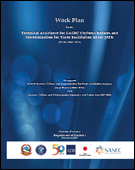 Work Plan for the Technical Assistance for SASEC Customs Reform and Modernization for Trade Facilitation under JFPRThis work plan serves as a roadmap to implement the second tranche policy actions of the SASEC Customs Reform and Modernization for Trade Facilitation Program, a policy-based loan signed between the Government of Nepal and the Asian Development Bank. Ten policy actions feature reform milestones in (i) policy and legal framework, (ii) automation, (iii) organization restructuring, and (iv) capacity development—building blocks to transform the Nepal Department of Customs into risk-based, paperless e-Customs operations, introduce customs procedures with economic impact to promote exports, and comply with WTO TFA measures and implement RKC general standards and other relevant international standards. This work plan comprises tasks designed to boost the capacity of the Customs and support delivery of its Customs Reform and Modernization Strategies and Action Plan 2017–2021. It also includes implementation arrangements, timeline, and inputs from the technical assistance (TA) attached to the Program. Author: Nepal Ministry of Finance, Department of Customs Year: 2017 Download Tags: SASEC, Customs, ADB, Nepal, Trade Facilitation Agreement  Asian Economic Integration Report 2017The 2017 Asian Economic Integration Report introduces the Asia-Pacific Regional Cooperation and Integration Index (ARCII), a composite index constructed from 26 socioeconomic indicators grouped into six dimensions: (i) trade and investment, (ii) money and finance, (iii) regional value chains, (iv) infrastructure and connectivity, (v) movement of people, and (vi) institutional and social integration. It helps capture the diversity of regional cooperation and integration, allowing Asian economies to keep track of their progress in regional integration. Within the region, ARCII shows RCI is highest in East Asia and Southeast Asia, but remains low in South Asia and Central Asia owing to gaps in infrastructure and connectivity. It is also low in the Pacific due to weak institutional and social integration. In subregional cooperation, SASEC comes third to the ASEAN and GMS. The publication highlights that regional integration can be improved through institutional and social dimensions, including efforts to remove national barriers to regional integration, adopt regional standards, and institutionalize regional frameworks, and narrowing gaps in regional connectivity and infrastructure. Author: Asian Development Bank Year: 2017 Download Tags: Regional Cooperation, Trade Facilitation, Connectivity, SASEC, GMS Least Developed Countries Report 2017This report focuses on transformational energy access for the LDCs, where 62% of people have no access to electricity. It makes a case for trade in electricity, such as the 2014 South Asian Association for Regional Cooperation framework agreement for regional cooperation on electricity among Afghanistan, Bangladesh, Bhutan, India, Maldives, Nepal, Pakistan, and Sri Lanka. International and regional trade in electricity could help lower electricity prices, mitigate power shocks, relieve shortages, and facilitate the transition to cleaner energy. Author: United Nations Conference on Trade and Development Year: 2017 Download Tags: Bangladesh, Bhutan, Maldives, Nepal, Sri Lanka, Energy, Least Developed Countries, Trade SME Competitiveness Outlook 2017 – The Region: A Door to Global TradeThe most common form of trade for small and medium-sized enterprises (SMEs) is regional trade. This report shows that regional trade agreements deliver inclusive growth, attracting value chain activity and fostering competitiveness for small firms. It provides advice for policymakers, businesses, and trade and investment support institutions. The report also includes 50 country profiles—including those of Bangladesh, Bhutan, India, Nepal, and Sri Lanka—showing SME competitiveness and export potential by region. Author: International Trade Centre Year: 2017 Download Tags: Small and Medium Enterprise, Trade, Bangladesh, Bhutan, India, Nepal, Sri Lanka Regional Cooperation and Integration in Asia and the Pacific: Implementation of the Operational Plan for Regional Cooperation and Integration, 2016–2020─Corporate Progress Report 2017Regional cooperation and integration (RCI) is a valuable means for attaining national development goals. This report reviews ADB’s progress in implementing its Operational Plan for Regional Cooperation and Integration, 2016–2020, and identifies areas for improvement. It takes a close look at progress in connectivity, competitiveness, and regional public goods and collective action through projects such as the Nepal: SASEC Customs Reform and Modernization for Trade Facilitation Program. Author: Asian Development Bank Year: 2017 Download Tags: Nepal, Energy, Trade, Customs, Myanmar, Regional Cooperation, Regional Integration, SASEC, Trade Facilitation Asia-Pacific Trade and Investment Report 2017: Channelling Trade and Investment into Sustainable DevelopmentThis report provides analyses of trends and policy developments in trade in goods and commercial services in Asia-Pacific. It shows that merchandise trade remained subdued in 2016, with South and Southwest Asia accounting for 8% of Asia-Pacific exports and 12% of Asia-Pacific imports. Foreign direct investments inflows In South and South-West Asia decreased slightly by 4% to $66 billion in 2016. The report also argues for targeted trade and investment policies that strike a balance between economic development and social and environmental development. Author: United Nations Economic and Social Commission for Asia and the Pacific Year: 2017 Download Tags: Trade, Investment, FDI, ASEAN, India, Services, South Asia, Sri Lanka, Sustainable Development Goals, UNESCAP 2017 Handbook of StatisticsThis report presents statistics and indicators on international trade, investment, and development. It includes data on developing economies in South Asia, which in 2016 accounted for about $401 billion in merchandise exports and $529 billion in merchandise imports, $192 billion in service exports and $175 billion service imports, and 6.7% gross domestic product (GDP) growth. Author: United Nations Conference on Trade and Development Year: 2017 Download Tags: FDI, South Asia, Trade, Transport, UNCTAD 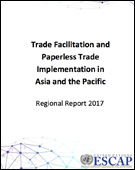 Trade Facilitation and Paperless Trade Implementation in Asia and the Pacific - Regional Report 2017Paperless trade reduces trade costs and enables trade to drive growth and sustainable development. This report shares results of the global survey on trade facilitation and paperless trade implementation, covering 44 countries in Asia and the Pacific. It covers 47 trade facilitation measures, including those involving general trade, paperless trade, cross-border paperless trade, transit, and trade for small and medium-sized enterprises. The report gives an overview of trade facilitation implementation in South and Southwest Asia, and includes Bangladesh, India, and Myanmar in its analysis of transit measures in Asia and the Pacific. Author: United Nations Economic and Social Commission for Asia and the Pacific Year: 2017 Download Tags: UNESCAP, Bangladesh, India, Least Developed Countries, Maldives, Myanmar, Small and Medium Enterprise, Trade Facilitation Agreement, Transport Facilitation, WTO Customs Clearance Procedure for Relief Materials 2017 This relief consignment procedure published by the Nepal Department of Customs act as guide for the import of relief materials in response to emergencies and disaster situations in Nepal. It identifies items that can and cannot be imported, and conditions for import, and details procedures for Customs clearance, including declaration and valuation. It also discusses provisions for temporary import or export of relief goods. Author: Department of Customs, Ministry of Finance, Nepal Year: 2017 Download Tags: Customs, Nepal, Trade Facilitation, Temporary admission 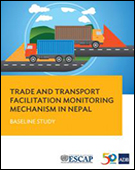 Trade and Transport Facilitation Monitoring Mechanism in NepalThis report synthesizes the business process analysis conducted on import of wool through Kolkata-Birgunj-Kathmandu, export of wool carpet from Kathmandu-Birgunj-Kolkata, and import of fabrics from Bangladesh to Nepal through Dhaka-Banglabandha-Fulbari-Panitanki-Kakarbhitta-Kathmandu. It also measures the performance of trade corridors and border crossings in Nepal, to quantify current trade and transport facilitation and provide recommendations. Findings of the study reveal bottlenecks to trade, including procedures needed to complete import/export, compounded by requirements for transiting trade through India, which further prolongs the trade process and increases the cost. The report includes specific short-term and long-term policies to improve Nepal’s trade and transport facilitation. Author: Asian Development Bank and United Nations Economic and Social Commission for Asia and the Pacific Year: 2017 Download Tags: Trade Facilitation, Nepal, Import, Export, ADB RCI Key Indicators for Asia and the Pacific 2017This report gives the latest statistics on economic, financial, environmental, and Sustainable Development Goal (SDG) indicators for the 48 regional members of the Asian Development Bank, including up-to-date figures on energy, trade, and transport. In 2016, Asia and the Pacific accounted for 40.9% of global gross domestic product (GDP). While foreign direct investment (FDI) flows declined in East Asia and Southeast Asia in 2016, FDI flows to South Asia remained stable. The average number of days required to start a business in South Asia was 16. Energy consumption is also expected to increase in the coming decades owing to increasing GDP per capita and an increase in the use of energy-consuming goods. Author: Asian Development Bank Year: 2017 Download Tags: ADB, Energy, Transport, Bangladesh, Bhutan, India, Maldives, Nepal, Southeast Asia, Sri Lanka Doing Business 2018: Reforming to Create JobsDoing Business, an annual publication of the World Bank, presents quantitative indicators on business regulations that can be compared across 190 economies and over time. The report finds that entrepreneurs in 119 economies saw improvements in their local regulatory framework, including reforms for reducing complexity in regulatory processes for starting businesses. South Asia scores well for starting a business, though it scores only an average of 33.04 for resolving insolvency. India has the highest score in South Asia for protecting minority investors. Patterns show further room for improvement across all regions and at all income levels. Author: World Bank Group Year: 2017 Download Tags: Ease of Doing Business, South Asia, WB ESCAP Newsletter - 2017 SeptemberThe ESCAP Newsletter is a monthly recap of the events and other activities of the United Nations Economic and Social Commission for Asia and the Pacific (UNESCAP). This issue highlights the ASEAN-India partnership and how it could benefit the Asia-Pacific region. Dr. Shamshad Akhtar, Executive Secretary, UNESCAP, talks about the importance of sustainable development and regional cooperation and integration. The issue also features a story on strengthening technical cooperation between UNESCAP and Myanmar. Author: United Nations Economic and Social Commission for Asia and the Pacific Year: 2017 Download Tags: ASEAN, India, Myanmar, Regional Cooperation, Regional Integration, UNESCAP The Asian Economic Integration Cooperation Agreement: Lessons for Economic and Social DevelopmentThis paper focuses on the impact of regional integration on development and poverty reduction in the Association of Southeast Asian Nations (ASEAN) economic community. It examines economic growth, rapid trade, and investment expansion and looks at challenges presented by the deterioration in trade balances in Cambodia, Laos, Myanmar, and Vietnam. It also explores the role of regional integration in addressing the development gap in ASEAN countries. Author: Amelia U. Santos-Paulino Year: 2017 Download Tags: ASEAN, Free Trade Agreements, Least Developed Countries, Myanmar, Regional Cooperation, Regional Integration, WTO Nepal Energy Sector Assessment, Strategy, and Road MapTo improve energy security and stimulate economic growth in the face of an unprecedented energy crisis, Nepal is accelerating the development of its hydropower sector. This report examines the performance of Nepal’s energy sector amid development constraints, and highlights government development plans and strategy. It assesses the Asian Development Bank’s (ADB’s) future support strategy, which sees Nepal’s energy sector as a key driver of inclusive economic growth. Author: Asian Development Bank Year: 2017 Download Tags: Energy, Nepal, SASEC, ADB, Hydropower 100% Electricity Generation through Renewable Energy by 2050: Assessment of Sri Lanka's Power SectorIn 2014, Sri Lanka met its target of generating at least 10% of renewable energy (RE) in its electricity mix in. The following year, the share of large hydro and RE further increased, while the country’s use of fossil fuels in the electricity mix decreased. This report aims to help design mechanisms that would allow Sri Lanka to reach its goal of 100% RE in electricity generation by 2050. It looks at financial interventions needed for Sri Lanka to achieve its goal while examining technical and economic challenges the country will face in reaching its goal. This report is a co-publication of the Asian Development Bank and the United Nations Development Programme. Author: Manpreet Singh et al Year: 2017 Download Tags: ADB, Cooperation, Hydropower, Sri Lanka, Renewable Energy, Trade Asian Development Outlook (ADO) Supplement: A Firmer Growth Outlook for AsiaGrowth forecast for developing Asia for 2018 is downgraded to 5.8%, from projections in the Asian Development Outlook 2017 Update in September 2017. Forecasts for the region’s inflation rates have been retained at 2.9% for 2018. For South Asia, growth outlook for 2018 is retained at 7.0%. India’s gross domestic product (GDP) growth rebounded to 6.3% in FY2017 (ending 31 March 2018), led by manufacturing. Bangladesh showed higher GDP growth for FY2017 (ended 30 June 2017) than was previously estimated. Bhutan showed stronger growth than forecast, supported by transport and communication services and construction. Growth projections for Maldives, Nepal, and Sri Lanka are in line with those in the Update. Author: Asian Development Bank Year: 2017 Download Tags: ADB, India, Bangladesh, Bhutan, Maldives, Nepal, Sri Lanka, Manufacturing Asian Development Bank and India: Fact SheetUpdated yearly, the Asian Development Bank (ADB) Fact Sheet provides social and economic indicators on India, as well as information on ADB operations and contact details. Millions of people from India have benefited from improvements to basic infrastructure and services from ADB-supported development programs. ADB has approved 205 loans totaling $35.1 billion for India, and will continue to support India through the pillars of inclusive growth, environmentally sustainable growth, and regional cooperation and integration. Author: Asian Development Bank Year: 2017 Download Tags: ADB, India, Infrastructure, Regional Cooperation, Sustainability Asian Development Bank and Sri Lanka: Fact SheetThis Asian Development Bank (ADB) Fact Sheet provides social and economic indicators on Sri Lanka and information on ADB operations in Sri Lanka and contact details. ADB has worked closely with the Government of Sri Lanka since 1966 and has provided loans, grants, and technical assistance totaling $8.4 billion. ADB assistance will focus on ensuring quality economic growth as Sri Lanka aims to reach upper-middle-income status. Author: Asian Development Bank Year: 2017 Download Tags: ADB, Sri Lanka, Development Asian Development Bank and Nepal: Fact SheetThe ADB Fact Sheet provides social and economic indicators on Nepal, as well as information on ADB operations in the country and contact details. Nepal is working toward graduation to middle-income country status and achieving the Sustainable Development Goals by 2030. ADB assistance aims to improve equitable access to education while pursuing a strategy that aims to address bottlenecks in infrastructure development in energy, transport, and urban facilities. ADB operations will also focus on agriculture, gender equality, good governance, environmental sustainability, regional cooperation, and private sector development. Author: Asian Development Bank Year: 2017 Download Tags: ADB, Nepal, Sustainable Development Goals, Infrastructure, Energy, Transport, Agriculture, Regional Cooperation, Gender Trade Profiles 2017Trade Profiles 2017 provides a series of key indicators on trade in goods and services for 196 economies, highlighting major exports and imports for each economy as well as their main trading partners. It provides a concise overview of global trade for each profile, showing detailed information about merchandise trade flows. It also features an expanded section on trade in commercial services and statistics on intellectual property. Author: World Trade Organization Year: 2017 Download Tags: GDP, Trade, WTO Transport Policies and DevelopmentThis survey reviews the current state of impact assessment of transport investments and policies on growth, inclusion, and sustainability in a developing country context. It reviews the cost and benefits of transport investment and policies in developed countries and discusses challenges in implementing transport interventions in developing countries. Author: Claudia N. Berg, Uwe Deichmann, Yishen Liu, and Harris Selod Year: 2017 Download Tags: Investment, Sustainability, Transport Measuring and Analyzing the Impact of GVCs on Economic Development (English)This report shows how the global economy is changing continuously and rapidly. It attempts to give a detailed picture of the dynamic network structure of the global economy, and tries to show how economies link up, specialize, and grow, in light of global value chains. It explains the difference between elements of an economy that are tradable and those that are non-tradable, while also presenting a picture of evolving patterns of independence. Author: Asian Development Bank Year: 2017 Download Tags: Development, WB, WTO Asian Development Bank and Bhutan: Fact SheetThe Asian Development Bank (ADB) Fact Sheet provides social and economic indicators on Bhutan, as well as information on ADB operations and contact details. Since 1982, ADB has supported Bhutan through projects in energy, finance, and trade facilitation, and transport. ADB has approved loans totaling $498.81 million, grants of $222.4 million, and $73.48 million in technical assistance for Bhutan. ADB support reflects strong emphasis on green energy production, transport connectivity, and urban infrastructure projects. To make growth more inclusive, ADB will help Bhutan through projects focusing on cross-border connectivity, skills development, and agriculture. Author: Asian Development Bank Year: 2017 Download Tags: ADB, Bhutan, Energy, Connectivity, Transport, Agriculture, Roads Asian Development Bank and Myanmar: Fact SheetUpdated yearly, this Asian Development Bank (ADB) Fact Sheet provides social and economic indicators on Myanmar, as well as information on ADB operations in the country and contact details. ADB is supporting Myanmar in promoting inclusive and sustainable economic growth, with investments focusing on infrastructure (in energy, transport, and urban and water services), education, and rural development. Regional cooperation will remain one of the key priorities. Author: Asian Development Bank Year: 2017 Download Tags: ADB, Myanmar, Sustainability, Infrastructure, Energy, Transport, Regional Cooperation Asian Development Bank and the Maldives: Fact SheetThis Asian Development Bank (ADB) Fact Sheet provides social and economic indicators on Maldives, and information on ADB operations and contact details. ADB is helping Maldives upgrade commercial and domestic harbors, ensure power supply reliability, boost economic growth, and reduce regional disparities in living standards. Projects in sustainable energy development are helping Maldives achieve carbon neutrality and reduce high fuel costs. Since 1978, ADB has approved 29 loans and grants totaling $248.53 million for Maldives, and has funded 67 technical assistance projects totaling $29.65 million. Author: Asian Development Bank Year: 2017 Download Tags: ADB, Maldives, Energy, Transport, Development, Sustainability 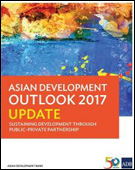 Asian Development Outlook (ADO) 2017 Update: Sustaining Development through Public-Private PartnershipDeveloping Asia is forecast to expand by 5.9% in 2017 and 5.8% in 2018, a slight upgrade from projections in the Asian Development Outlook 2017. However, growth forecast for South Asia is downgraded to 6.7% in 2017. India’s growth remains strong and most South Asian countries are expected to meet or exceed growth forecasts from April. Exceptions are Sri Lanka, where agriculture was affected by drought and floods, and Bhutan, where geological problems have constrained construction on two large hydropower projects. Growth in Nepal surged in 2017 on earthquake recovery but is slowing as agriculture struggles, following severe flooding in August 2017. Inflation forecast in South Asia is lowered to 4.2% for 2017 and 4.7% for 2018. Favorable global commodity prices, good harvests, and prudent macroeconomics are expected. Author: Asian Development Bank Year: 2017 Download Tags: Asia, Development, Sustainability, Public Private Partnerships, South Asia, India, Sri Lanka, Agriculture, Bhutan, Hydropower, Energy, Nepal The Little Green Data Book 2017Based on World Development Indicators 2017 and its online database, the Little Green Data Book 2017 looks at development and the environment through more than 50 indicators for all countries around the world. This edition features indicators on capture fisheries, aquaculture production, and marine-related areas, focusing on the economic importance of fisheries for sustainable development. Author: World Bank Year: 2017 Download Tags: Environment, WB, Development, Sustainability World Development Indicators 2017This report compiles statistics on global development, with this years’ database including more indicators covering the Sustainable Development Goals and more data disaggregated by sex, age, wealth quintile, and urban or rural location. The online database (http://data.worldbank.org) now includes more than 1,400 indicators for more than 220 economies (including those from South Asia), with some data series extending back more than 50 years. Author: World Bank Year: 2017 Download Tags: WB, Development, Sustainable Development Goals, South Asia Trans-Pacific Partnership Rules for Digital Trade in AsiaDigital trade has driven economic development by improving productivity and lowering the costs of trade in goods. The Trans-Pacific Partnership (TPP) is the first trade agreement to recognize the importance of digital trade and e-commerce, introducing new provisions that go beyond existing agreements. This paper asks why Australia, Brunei Darussalam, Japan, Malaysia, New Zealand, Singapore, and Viet Nam agreed to follow a similar set of policies for digital trade. Author: Debora Elms and Minh Hue Nguyen Year: 2017 Download Tags: Trade, Asia-Pacific The Internet of Things in the Power Sector: Opportunities in Asia and the PacificAsia’s power sector struggles to upgrade power systems and keep up with growing demand. The Internet of Things (IoT) has the potential to transform the power sector by optimizing operations and lowering costs for consumers. The power sector is already reaping the benefits of adoption of smart meters and smart thermostats, two consumer-oriented IoT applications. The Asian Development Bank has committed to smart grid projects in India, through a Green Energy Corridor and Grid Strengthening Project, and Maldives, through the Preparing Outer Islands for Sustainable Energy Development (Phase 1). Author: Arun Ramamurthy and Pramod Jain Year: 2017 Download Tags: Energy, ADB, India, Maldives, Sustainability Aid for Trade in Asia and the Pacific: Promoting Connectivity for Inclusive DevelopmentAid for Trade (AfT) is essential to promoting growth and tradability of services, and is a major catalyst for inclusive economic and structural information. This report looks at how trade performance in Asia and the Pacific is evolving, and highlights emerging trends in AfT. The report looks at cooperation projects in the energy sector, and shows how South Asia Subregional Economic Cooperation (SASEC) projects fund cross-border electricity transmission, power trade, energy efficiency, capacity building, and renewable sources of energy. The report also examines the impact of AfT on trade in services and the rise of e-commerce. Author: Asian Development Bank Year: 2017 Download Tags: Trade, Energy, SASEC, Aid for Trade, ADB World Trade Report 2017: Trade, Technology, and JobsEconomic growth over the last 25 years has been accompanied by unprecedented economic change. Over the past two decades, many countries have experienced significant transformations in the sectoral and occupational structure of employment. This report examines how technology and trade affect employment and wages and analyzes the challenges for workers and firms in adjusting to changes in labor markets. It looks at how governments could increase the positive impact of open trade and technological trade in South Asia and around the world. Author: World Trade Organization Year: 2017 Download Tags: Trade, ICT, Employment, Global Value Chains, South Asia 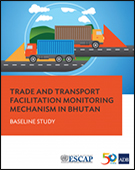 Trade and Transport Facilitation Monitoring Mechanism: Baseline Study in BhutanThis report synthesizes the business process analysis conducted on import of light motor vehicles from third countries to Bhutan via Kolkata Port, import of plastic kitchenware and tableware (melamine products) from Bangladesh to Bhutan, export of ferrosilicon from Bhutan to third countries through Kolkata Port, and export of cardamom from Bhutan to Bangladesh. It also measures the performance of trade corridors and border crossings in Bhutan, to quantify current trade and transport facilitation and provide recommendations. Findings of the study reveal bottlenecks to trade, including numerous procedures needed to complete import/export, and low speed along the trade corridors. The report includes specific short-term and long-term policies to improve Bhutan’s trade and transport facilitation. Author: Asian Development Bank and United Nations Economic and Social Commission for Asia and the Pacific Year: 2017 Download Tags: Bhutan, Trade Facilitation, Bangladesh, ADB, Transport, ADB RCI 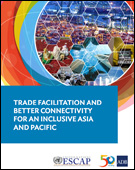 Trade Facilitation and Better Connectivity for an Inclusive Asia and PacificThis report investigates the evolution of trade costs, examines trade facilitation and paperless trade implementation, and highlights key initiatives in South Asia, including efforts by members of the South Asia Subregional Economic Cooperation (SASEC). The SASEC Trade Facilitation and Transport Working Group agreed to expand assistance to trade facilitation through technical assistance to support more efficient, transparent, secure, and service-oriented processing of cross-border trade across South Asia. Through 2025, the SASEC connectivity agenda will be better aligned with the frameworks of South Asian Association for Regional Cooperation and the Bengal Initiative for Multi-Sectoral Technical and Economic Cooperation. To help establish a trade and transport facilitation monitoring mechanism, Bangladesh, Bhutan, and Nepal conducted studies that reviewed trade and transport procedures, analyzed bottlenecks, and gave recommendations on trade and transport facilitation. Author: Asian Development Bank and United Nations Economic and Social Commission for Asia and the Pacific Year: 2017 Download Tags: ADB, Bangladesh, Bhutan, BIMSTEC, Maldives, Nepal, SAARC, India, Myanmar, SASEC, South Asia, Sri Lanka, Trade Facilitation, Transport, UNESCAP, ADB RCI 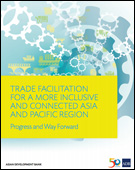 Trade Facilitation for a More Inclusive and Connected Asia and Pacific Region: Progress and Way ForwardThis report gives an overview of assessments from the 2017 global survey on trade facilitation and paperless trade in Asia and the Pacific. It looks at the implementation of trade facilitation and paperless trade measures in 44 countries in Asia and the Pacific, including how the South Asia Subregional Economic Cooperation Trade Facilitation Strategic Framework promotes development by deepening regional cooperation. The Framework covers national and subregional projects in Customs harmonization, improving cross-border facilities, and transport facilitation. The Framework also supports regulatory reforms and the development of the National Single Window Customs management system in Bangladesh, Bhutan, Maldives, and Nepal. Author: Asian Development Bank and United Nations Economic and Social Commission for Asia and the Pacific Year: 2017 Download Tags: ADB, Bangladesh, Bhutan, BIMSTEC, Maldives, Nepal, Regional Cooperation, Regional Integration, SAARC, SASEC, Standards Harmonization, Trade Facilitation, Trade Facilitation Agreement, WTO, UNESCAP, ADB RCI Myanmar’s Integration with the WorldMyanmar only recently began participating in global trade and investment. It has large untapped potential for trade and investment in agriculture and forest-based industries, and services, such as tourism and information technology. This book examines Myanmar’s access to the global market and examines the implication of Myanmar’s democratic transition, the progress of Myanmar’s industry and infrastructure, its international linkages, and options for increased integration in regional economic groups. The book also analyzes how Myanmar could exploit global value chains. Author: Prabir De and Ajitava Raychaudhuri, editors Year: 2017 Download Tags: Agriculture, Global Value Chains, Infrastructure, Investment, ICT, Myanmar, Regional Integration, Trade Regional Road Map for Implementing the 2030 Agenda for Sustainable Development in Asia and the PacificIn 2015, 150 countries set in motion the most ambitious development agenda of our time, the 2030 Agenda for Sustainable Development. Asian countries have begun translating this agenda into action through national plans and programs. However, to fully achieve the Sustainable Development Goals, countries need to examine opportunities for regional cooperation to complement the effectiveness of national mechanisms in the areas of finance, technology, capacity-building, and trade. Discussion through regional and subregional organizations can help facilitate cooperation in these key areas. Author: United Nations Economic and Social Commission for Asia and the Pacific Year: 2017 Download Tags: Regional Cooperation, SAARC, Sustainable Development Goals, Trade, UNESCAP Myanmar’s Engagement in Regional Integration: Status and Way Forward (AWP No. 169)Myanmar strategic position connects Asia’s three big markets—Association of Southeast Asian Nations, China, and India. Since 2011, Myanmar has laid down economic reforms that are unlocking the country’s potential. This working paper discusses Myanmar’s participation in regional partnerships, such as the South Asia Subregional Economic Cooperation, which it joined in 2017. It argues that such partnerships are essential in building Myanmar’s infrastructure and speeding up its growth. Author: Prabir De Year: 2017 Download Tags: ADB, ASEAN, India, Myanmar, Regional Cooperation, Regional Integration, SASEC, UNESCAP 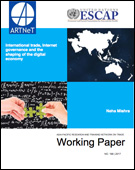 International Trade, Internet Governance and the Shaping of the Digital Economy (AWP No. 168)The connection between trade and internet governance presents complex policy challenges in today’s digital economy. This working paper highlights several observations and findings on the complex relationship between international trade and the internet. It recognizes the fact that the internet is not only driven by economic factors, but is a complex phenomenon shaped by political and social engagement, technical efficiency, and cultural and moral considerations. It sees the importance of synergizing international trade and the internet, and recommends that the World Trade Organization and other trade institutions develop mechanisms to consult internet governance institutions such as the Internet Engineering Task Force, World Web Wide Consortium, Internet Corporation for Assigned Names and Numbers, International Telecommunications Union, Internet Society, and the Internet Governance Forum. Author: Neha Mishra Year: 2017 Download Tags: ICT, Trade Facilitation, UNESCAP, WTO Together We Deliver: 50 Stories of ADB's Partnerships in Asia and the PacificThis special edition of Together We Deliver tells 50 stories that highlight the importance of good partnerships in Asia and the Pacific in meeting complex development challenges. In South Asia, ADB has supported infrastructure development and social programs, helping lift people out of poverty in a diverse, rapidly urbanizing subregion. The South Asia Subregional Economic Cooperation Roads Improvement Project, for instance, is set to widen 160 kilometers of Nepal’s East–West Highway, which connects Nepal to India. The improved roads will provide faster and better access to social services and economic opportunities, and will facilitate national and regional integration. Author: Asian Development Bank Year: 2017 Download Tags: ADB, Economic Corridor Development, India, Nepal, Regional Integration, Roads, SASEC, South Asia, Transport State of Electricity Access Report (SEAR) 2017This report presents insights drawn from emerging innovative business and delivery models so that governments, donors, the private sector, civil society organizations, and practitioners could develop interventions to close the electricity access gap. It shows that urgent measures are needed to speed up access to modern energy services in Sub-Saharan Africa and South Asia and that responses will have to be supported by a conducive environment of the right institutions, policies, strategic planning, and incentives. Author: World Bank Year: 2017 Download Tags: Energy, South Asia, Sustainable Development Goals 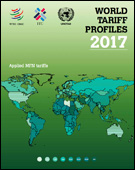 World Tariff Profiles 2017World Tariff Profiles is a joint publication of the World Trade Organization (WTO), International Trade Centre, and the United Nations Conference on Trade and Development devoted to information on market access for goods. It contains comprehensive data on tariffs and non-tariff measures imposed by over 170 countries and Customs territories. This year’s edition takes a close look at export diversification, analyzing to what extent economies have diversified their exports over time. Many countries make it a policy to diversify exports to obtain bigger market shares. An overview of export diversification shows how India, Myanmar, Sri Lanka, Bangladesh, and Bhutan have grown in the last two decades. Bangladesh in particular has achieved significant increase in terms of both product coverage and market reach. Author: World Trade Organization, International Trade Centre, and the United Nations Conference on Trade and Development Year: 2017 Download Tags: Bangladesh, Bhutan, Export, India, Maldives, Myanmar, Nepal, Sri Lanka, Tariffs, Trade, UNCTAD, WTO Asian Development Bank and Bangladesh: Fact SheetThis Asian Development Bank (ADB) Fact Sheet provides social and economic indicators on Bangladesh, as well as concise information on ADB's operations in Bangladesh and contact information. ADB supports Bangladesh’s efforts to generate inclusive and sustainable growth, and achieve the Sustainable Development Goals. ADB has provided Bangladesh with $18.3 billion for 269 loans, $252.4 million for 422 technical assistance projects, and $787.10 million for 35 grants. ADB supports projects contributing to regional connectivity to foster development along economic corridors and co-finances the SASEC Railway Connectivity: Akhaura-Laksam Double Track Project. Author: Asian Development Bank Year: 2017 Download Tags: ADB, Bangladesh, Economic Cooperation, Energy, Sustainable Development Goals, Sustainability, SASEC 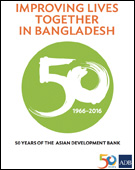 Improving Lives Together in Bangladesh: 50 Years of the Asian Development BankThis report highlights the milestones in the Bangladesh-Asian Development Bank (ADB) partnership since 1973, including projects in transport and energy that have shown sustained development results. Development contributions from ADB-assisted projects in Bangladesh include the Second South Asia Subregional Economic Cooperation Program (SASEC) Bangladesh-India Electrical Grid Interconnection Project that will help double electricity imports from India from the current 500 megawatts; the $505 million SASEC Railway Connectivity, Akhaura Laksam Double-Track Project, which will help railways meet passenger and freight demand; the SASEC Road Connectivity Project, which is upgrading a 70 km stretch along a corridor connecting the northwest to Dhaka to support domestic and subregional trade; and the SASEC Trade Facilitation Program, which aims to reduce non-tariff barriers by adopting international Customs administration protocols, upgrade existing Customs management systems, and establish a web-based electronic trade portal. Author: Asian Development Bank Year: 2017 Download Tags: SASEC, ADB, Bangladesh, India, Railway, Energy, Transport ESCAP Newsletter - June 2017The ESCAP Newsletter is a monthly recap of the key events, publications and other activities of the United Nations Economic and Social Commission for Asia and the Pacific (UNESCAP). It highlights the key issues that the UNESCAP works on and how the organization works to support member states in reaching the objectives of the Sustainable Development Goals (SDGs). This issue highlights the 73rd Commission Session of Asia-Pacific leaders on "Regional Cooperation for Sustainable Energy," which culminated with the adoption of resolutions advancing transport connectivity and sustainable energy development. Author: United Nations Economic and Social Commission for Asia and the Pacific Year: 2017 Download Tags: Energy, Regional Cooperation, UNESCAP, Sustainable Development, Sustainable Development Goals SARSO News: Vol. 31, No. 2The South Asian Regional Standards Organization (SARSO) newsletter features updates on SARSO events and activities. This issue features the publication of three South Asian Association for Regional Cooperation standards on food quality and safety, and the workshop on the importance of ISO 14001—which aims to help organizations improve environmental performance through the efficient use of resources and reduction of waste—and its impact on the environment and trade. It also has reports on Workshop on Conformity Standards held in New Delhi, India, and the Enhancing Capacity for Sanitary and Phytosanitary (SPS) Measures for Safe Trade in Animal and Animal Products in South Asia held in Kathmandu, Nepal. Author: South Asian Regional Standards Organization Year: 2017 Download Tags: Agriculture, Bangladesh, Bhutan, India, Nepal, SAARC, SARSO, South Asia, Standardization, Trade Asian Development Outlook (ADO) 2017 Supplement: Cautious Optimism for Asia's OutlookWith export demand stronger than expected in the first quarter of 2017, Asia’s GDP is expected to expand faster than forecast in April in Asian Development Outlook 2017. Developing Asia is now expected to grow by 5.9% in 2017. The smaller upgrade in the 2018 growth forecast—5.7% in ADO 2017 to 5.8%—reflects a cautious view on the pace of the turnaround in external demand. Excluding the newly industrialized economies, growth projections for the region are revised up to 6.4% for 2017 and to 6.3% for 2018. India is expected to achieve April forecasts of 7.4% growth in 2017 and 7.6% in 2018, primarily from strong consumption. Growth projections for South Asia are likewise maintained as prospects remain robust. Author: Asian Development Bank Year: 2017 Download Tags: ADB, Development, Export, Bangladesh, India, South Asia World Trade Statistical Review 2017The World Trade Statistical Review looks at the last 10 years and examines the latest developments in world trade, with a detailed analysis of the most recent trends for trade in goods and services. The book gives information on the participation of India, Bangladesh, and other South Asian economies in world trade, and highlights trends in the use of trade-facilitating measures. It also gives information on the implementation of the WTO Trade Facilitation Agreement and regional trade agreements, such as the South Asian Free Trade Arrangement. Author: World Trade Organization Year: 2017 Download Tags: Export, Least Developed Countries, Aid for Trade, SAFTA, South Asia, Trade Facilitation, WTO, Bangladesh, Bhutan, India, Maldives, Myanmar, Nepal, Sri Lanka Win-Win: How International Trade Can Help Meet the Sustainable Development GoalsThis book aims to demonstrate to policy makers how international trade can contribute to achieving the Sustainable Development Goals (SDGs). Trade can promote income growth, which can then support sustainable development. In addition, there are also direct links between trade and sustainable development, such as trade’s effect on the price and availability of health, education, energy, and other important services. This book maps out a triple-win scenario where good trade policy spurs international trade, contributes to development-friendly outcomes, and helps achieve the SDGs. Author: Matthias Helble and Ben Shepherd, eds. Year: 2017 Download Tags: Bangladesh, India, Maldives, Nepal, Services, South Asia, Sustainability, Sustainable Development Goals Trade and Transport Facilitation Monitoring Mechanism: Baseline Study in BangladeshThis report synthesizes the business process analysis conducted on the export of plastic kitchenware and tableware from Bangladesh to Bhutan through Burimari land port, and the import of lentils from Nepal to Bangladesh through Banglabandha land port, as well as studies on trade corridors and border crossings in Bangladesh, to quantify current trade and transport facilitation in Bangladesh through a set of indicators. Findings of the study reveal bottlenecks to trade, including costly one-time procedures for a new trader, numerous documents and copies required to complete export and import processes, and low speed along the trade corridors. This report includes specific short-term and long-term policies to improve Bangladesh’s trade and transport facilitation. Author: Asian Development Bank Year: 2017 Download Tags: Trade Facilitation, Transport, Bhutan, Bangladesh, Nepal, SASEC, ADB RCI 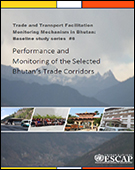 Performance and Monitoring of Selected Bhutan’s Trade CorridorsThis report on performance and monitoring of two corridors, the Kolkata-Phuentsholing corridor and the Burimari-Phuentsholing corridor is the sixth of a six-part study on Trade and Transport Facilitation Monitoring Mechanism (TTFMM) in Bhutan. The study finds that average speed along the corridor is very low. Along the Kolkata-Phuentsholing corridor, average speed with delays is 9 kilometers per hour (km/h) and without delays is 15 km/h. Along the Burimari-Phuentsholing corridor, average speed with delays is about 5 km/h and without delays is 16 km/h. The challenges to ensuring efficient transport along the corridor remain significant, yet the study sees tremendous opportunities for improvement, and raises the importance of continuous and effective monitoring to observe whether trade and transport performance along the corridor improve over time. Author: United Nations Economic and Social Commission for Asia and the Pacific Year: 2017 Download Tags: UNESCAP, Bhutan, Trade Facilitation, Transport Time Release Study in PhuentsholingThis Time Release Study report undertaken at Phuentsholing Land Border Crossing Station in Bhutan is the fifth of a six-part study on Trade and Transport Facilitation Monitoring Mechanism (TTFMM) in Bhutan. According to the study, the average time taken for clearance of import goods from India is 58 minutes for taxable goods and 28 minutes for non-taxable/exempted goods. Imports from third countries take around 16 hours for taxable goods and 7 hours for non-taxable/exempted goods. Export of goods to India and third countries follow the same procedure, with around 13 minutes on the average needed to clear export goods. Specific recommendations are given to further enhance the efficiency of clearance of goods at the borders, including conducting the TRS on a regular basis. Author: United Nations Economic and Social Commission for Asia and the Pacific Year: 2017 Download Tags: UNESCAP, Trade Facilitation, Bhutan Business Process Analysis of Export of Ferro Silicon from Bhutan to the Third CountriesThis business process analysis report on the export of Cardamom from Bhutan to Bangladesh via Phuentsholing-Jaigaon-Changrabandha-Burimari is the fourth of a six-part study on Trade and Transport Facilitation Monitoring Mechanism (TTFMM) in Bhutan. According to the study, it takes 29 days to complete all export procedures for new traders. The process is reduced to 26.5 days without the first time procedures. Total cost to export a typical truckload of two metric tons of cardamom is around $654, with one-time procedures amounting around $308. 24 documents are needed to complete the export process, with some documents requiring extra copies, numbering to as much as 71. Specific recommendations are given to improve trade in this commodity. Author: United Nations Economic and Social Commission for Asia and the Pacific Year: 2017 Download Tags: Bangladesh, Bhutan, Trade Facilitation, Transport Business Process Analysis of Import of Kitchen and Table Wares of Plastics (Melamine Products) from Bangladesh to BhutanThis business process analysis report on the import of kitchen and table wares (melamine products) from Bangladesh to Bhutan through Burimari-Changrabandha-Jaigaon-Phuentsholing-Thimphu is the second report of a six-part study on Trade and Transport Facilitation Monitoring Mechanism (TTFMM) in Bhutan. Study findings reveal it takes 16 days to import melamine products from Bangladesh, with costs amounting to around $719 for a truckload. 33 documents are needed to complete the 15 processes, with 12 documents requiring extra copies. Specific recommendations are given to improve trade in this commodity. Author: United Nations Economic and Social Commission for Asia and the Pacific Year: 2017 Download Tags: Business Process Analysis of Import of Light Motor Vehicles from the Third Countries to Bhutan via Kolkata PortThis business process analysis report on the import of light motor vehicles (LMVs) from third countries to Bhutan via Kolkata Port is the first report of a series of a six-part study on Trade and Transport Facilitation Monitoring Mechanism (TTFMM) in Bhutan. Study findings reveal it takes 28.5 days to import LMVs from the Republic of Korea, with costs amounting to around $1,289 to complete the import procedures, not including the applicable duty and taxes payable in Bhutan. 39 documents are needed to complete the import process, with 12 documents requiring extra copies. Specific recommendations are given to improve trade in this commodity. Author: United Nations Economic and Social Commission for Asia and the Pacific Year: 2017 Download Tags: UNESCAP, Bhutan, Trade Facilitation, Transport Lessons from ADB Transport Projects: Moving Goods, Connecting People, and Disseminating KnowledgeThis publication shares 20 case stories from the Asian Development Bank bearing practical lessons for transport projects across Asia and the Pacific region under different socioeconomic and political situations. The book includes reports on improving aviation in Bhutan, working on computerized transport and trade logistics in Nepal, and constructing Sri Lanka's Greenfield Highway, and the role policy plays in those projects. It also draws lessons from how India's road development increased rural communities' access to public services and economic opportunities, and how participatory processes in selecting road improvement projects in Bangladesh provide a model for long-term plan for road maintenance. Author: Asian Development Bank Year: 2017 Download Tags: ADB, Bangladesh, Bhutan, India, Nepal, Railway, Sri Lanka, Transport, ADB RCI Digital Trade Facilitation: Paperless Trade in Regional Trade AgreementsMost regional trade agreements now feature one or more measures for electronically exchanging trade-related information. These measures are becoming essential to maintaining trade competitiveness and enabling effective participation in cross-border e-commerce. This paper examines the extent to which measures enabling paperless trade are included in regional trade agreements (RTAs), such as the Association of Southeast Asian Nations-India Free Trade Agreement. India leads the region with the highest number of RTAs involving paperless trade measures. Asia-Pacific RTAs now increasingly cover specific areas of paperless trade such as electronic certificates of origin and sanitary and phytosanitary certificates. Author: Yann Duval and Kong Mengjing Year: 2017 Download Tags: ADB, ASEAN, Free Trade Agreements, India, Regional Cooperation, Trade Facilitation, UNESCAP, WTO World Investment Report 2017This report presents foreign direct investment (FDI) trends and prospects at global, regional and national levels. FDI flows to developing Asia contracted by 15% to $443 billion in 2016. This decline was relatively widespread, except in South Asia, where several countries including Bangladesh and Nepal are expected to receive more FDI in the coming years. The report investigates the internationalization patterns of digital multinational enterprises, as well as the effect of digitalization on global companies across all industries. It provides insights to policymakers on how the digital economy impacts investment policies and how investment policy can support digital development, with a view toward achieving the SDGs. Author: United Nations Conference on Trade and Development Year: 2017 Download Tags: FDI, Global Value Chains, Investment, Policy, South Asia, UNCTAD, Bangladesh, India, Nepal Regional Cooperation for Sustainable Energy in Asia and the PacificCountries in the Asia-Pacific region face multiple energy-related challenges, which are driving transformation of energy systems. Addressing these energy challenges is an integral part of implementing the 2030 Agenda for Sustainable Development, including ensuring access to affordable, reliable, sustainable, and modern energy for all. This report analyzes challenges in the Asia-Pacific region and its efforts to accelerate the energy transition to achieve Sustainable Development Goal 7. Author: United Nations Economic and Social Commission for Asia and the Pacific Year: 2017 Download Tags: Asia-Pacific, Energy, Sustainability, Sustainable Development Goals, UNESCAP, Bangladesh, Bhutan, India, Maldives, Myanmar, Nepal, Sri Lanka 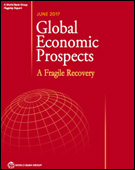 June 2017 Global Economic Prospects: A Fragile RecoveryThe World Bank forecasts that global growth will strengthen to 2.7% in 2017 amid a pickup in manufacturing and trade, rising confidence, favorable global financing conditions, and stabilizing commodity prices. In South Asia, growth is projected to remain strong at 6.8% in 2017. India is recovering from the temporary adverse effects of the end-2016 withdrawal of large-denomination currency notes. Activity in Bangladesh is moderating, reflecting a pullback in domestic demand and industrial production. Regional growth is expected to steady in 2018-2019, reaching an average of 7.2%, supported by strong domestic demand, a small rise in exports, and strong foreign direct investment. The regional outlook has been slightly revised down from January, reflecting a more protracted recovery in private investment in India than previously expected. Author: World Bank Group Year: 2017 Download Tags: WB, Bangladesh, FDI, India, Manufacturing, South Asia, Trade Eradicating Poverty and Promoting Prosperity in a Changing Asia-PacificThis report explores five long-term trends in the Asia-Pacific region that will shape approaches to poverty alleviation and the prospects for achieving prosperity: regional economic cooperation and integration; rural–urban transitions; demographic changes; ICT access and connectivity; and demand for natural resources. It examines the changing development context in South Asian and other economies. It also looks at opportunities created by regional cooperation and integration that intend to bring about shared economic benefits. Author: United Nations Economic and Social Commission for Asia and the Pacific, Asian Development Bank, United Nations Development Programme Year: 2017 Download Tags: ADB, Connectivity, ICT, Regional Cooperation, Sustainability, UNESCAP, UNDP, Bangladesh, Bhutan, India, Maldives, Nepal, Sri Lanka 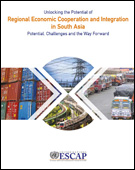 Unlocking the Potential of Regional Economic Cooperation and Integration in South AsiaAt a modest 6% of total trade, intraregional trade in South Asia stands at less than one third of its full potential. Trade barriers and inadequate infrastructure have cost South Asia over US $54 billion per year in lost export opportunities. With 309 million people living on less than $1.90 a day—the largest concentration of poverty in the world—South Asia should urgently pursue broad-based regional economic cooperation that could enable effective responses to the subregion’s developmental challenges. This report examines the state of economic integration in South Asia and identifies potential areas for further strengthening subregional linkages. It provides recommendations on policy actions to increase market integration, improve connectivity, boost investment in infrastructure development, and tackle shared vulnerabilities and risks. It calls for the consolidation and upgrading of existing trade and investment cooperation initiatives into a South Asia Comprehensive Economic Partnership. Author: United Nations Economic and Social Commission for Asia and the Pacific Year: 2017 Download Tags: BIMSTEC, Investment, Regional Cooperation, SAARC, South Asia, Sustainability, Sustainable Development, Trade, UNESCAP, Bangladesh, Bhutan, India, Maldives, Myanmar, Nepal, Sri Lanka Can Online Markets Make Trade More Inclusive? Technology-driven online trade reduces income inequality and makes trade more inclusive. To fully realize these new gains from trade, governments and export promotion agencies should address barriers to e-commerce. Technology made available by online markets has significantly reduced the cost of entry into international markets for small and medium-sized firms, which can now reach more distant consumers and create a global reputation as a seller at very low costs. Online firms, even those smaller than traditional offline firms, export, and this paper shows that online markets help reduce income inequality by providing smaller firms access to international markets. Author: Andreas Lendle and Marcelo Olarreaga Year: 2017 Download Tags: ADB, ICT, India, Trade Climbing Higher: toward a Middle-income NepalNepal is experiencing modest growth but brisk poverty reduction. It has halved the poverty rate in just seven years and witnessed an equally significant decline in income inequality. Yet Nepal remains one of the poorest and slowest-growing economies in Asia, with per capita income falling behind its regional neighbors. The report discusses the need for comprehensive policy reform to address the country’s challenges in becoming a lower-middle-income country by 2030. The report outlines suggested reforms to facilitate greater investment and improved productivity, build new sources of growth, and deepen human capital. Author: World Bank Group Year: 2017 Download Tags: Employment, Investment, Nepal, Poverty Reduction, Trade, Transport, WB Growth Slowdowns, Middle-Income Trap, and Demographic Profile in South AsiaThis paper examines how investment in human capital is critical for innovation. Analyzing the different growth-promoting factors in South Asian economies, with a focus on demographics, and factors that can help shift middle-income countries to high-income countries, it concludes that economic transition is affected by firms’ productive advantages—ability to compete with high-skilled producers, low-wage exporters—and education-based growth, which can help advance the country's technological capacity. Author: S. P. Jayasooriya Year: 2017 Download Tags: Economics, Employment, Manufacturing, Economic Corridor, South Asia 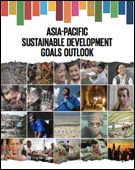 Asia-Pacific Sustainable Development Goals OutlookThis outlook report on the Sustainable Development Goals (SDG) offers an overview of the issues confronting the Asia and the Pacific region in eradicating poverty. Calling for greater synergies and collaboration, this report underscores that climate change and growth policies, including initiatives to improve access to energy and other forms of infrastructure, must also correspond to poverty-reduction strategies. The first knowledge product under a renewed partnership between the Economic and Social Commission for Asia and the Pacific, the Asian Development Bank, and the United Nations Development Programme, this report brings together experts and practitioners in the hope of inspiring new ideas to achieve the 2030 agenda. Author: United Nations Economic and Social Commission for Asia and the Pacific, Asian Development Bank, and United Nations Development Programme Year: 2017 Download Tags: Regional Cooperation, Trade Facilitation, Poverty Reduction, South Asia 2016 Development Effectiveness ReviewThe Development Effectiveness Review tracks development progress in Asia and the Pacific and monitors the Asian Development Bank’s (ADB) effectiveness 2010-2016. For South Asia, ADB shares results in regional cooperation, energy, and road and rail transport. ADB also approved $4.4 billion in financing for projects in South Asia during 2016. The Review includes details of ongoing and newly approved projects. Author: Asian Development Bank Year: 2017 Download Tags: ADB, Asia-Pacific, Development, Poverty Reduction, Regional Cooperation, Regional Integration, Roads, Transport, Bangladesh, Bhutan, India, Maldives, Nepal, Sri Lanka The Little Data Book on Information and Communication TechnologyThis book presents quick indicators for more than 200 countries showing data on key indicators of information and communications technology (ICT), including access, quality, affordability, efficiency, sustainability, and applications. It includes data for Bangladesh, Bhutan, India, Maldives, Myanmar, Nepal, and Sri Lanka. Author: World Bank and International Telecommunications Union Year: 2017 Download Tags: Bangladesh, Bhutan, ICT, India, Maldives, Myanmar, Nepal, Sri Lanka, South Asia, WB ADB Annual Report 2016The Asian Development Bank (ADB) 2016 Annual Report provides a complete picture of ADB’s performance in the reporting year. In 2016, South Asia sustained its rapid economic growth, expanding by 6.6% despite global headwinds. ADB approved $4.4 billion in loans and grants covering 30 projects in South Asia. ADB also supported the development of the South Asia Subregional Economic Cooperation (SASEC) Vision, which articulates the region’s potential as an integrated entity. SASEC countries adopted the partnership’s first comprehensive and long-term Operational Plan covering 2016-2025, defining strategic objectives and operational priorities. The Operational Plan identifies over 200 potential projects requiring more than $120 billion in development assistance over the next five years. Author: Asian Development Bank Year: 2017 Download Tags: ADB, SASEC, South Asia 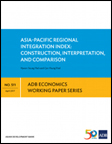 Asia-Pacific Regional Integration Index: Construction, Interpretation, and ComparisonDeeper regional integration expands markets, helps maximize the efficiency of resource allocation, and boosts productivity and investment opportunities, all serving stronger economies. This study proposes a regional integration index for Asia and the Pacific, the Asia-Pacific Regional Integration Index (APRII), comprising 26 indicators that measure various aspects of regional integration along six dimensions: trade and investment integration, money and finance integration, regional value chains, infrastructure and connectivity, free movement of people, and institutional and social integration. In the overall APRII, India ranks 14th—scoring closely to the Asia region integration average of 0.473—and scores highest on regional value chains and institutional and social integration. Nepal ranks 15th, scoring highest on regional value chains and trade and investment integration. Bangladesh and Sri Lanka rank 18th and 20th, respectively, and score highest on regional value chains. Maldives ranks 21st, scoring highest on free movement of people. Myanmar and Bhutan ranks 26th and 27th, and both score highest on trade and investment integration. In the overall regional integration indexes of selected Asian subregions, South Asia ranks 4th. Author: Hyeon-seung Huh, Cyn-Young Park Year: 2017 Download Tags: Regional Integration, Nepal, Bangladesh, Maldives, Myanmar, Bhutan 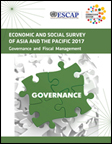 Economic and Social Survey of Asia and the Pacific 2017The 2017 edition of UNESCAP’s Economic and Social Survey of Asia and the Pacific underscores the need to better address the region's pressing challenges due to rising trade protectionism, heightened global uncertainty, and rapid growth in the previous years. Better governance and effective institutions can help Asia and the Pacific countries cope with steady but modest growth and rising inequalities, as well as environmental degradation, by helping them gain access to a skilled labor force, improve investment prospects, and sustain innovation—enhancing their level and pace of productivity, improving their long-term economic prospects. In South Asia, where most households depend entirely on labor income, decent and high-productivity jobs are needed to help mitigate high levels of poverty. The report also highlights the need to manage climate change, which threatens to undermine the region's economic development gains. Author: United Nations Economic and Social Commission for Asia and the Pacific Year: 2017 Download Tags: UNESCAP, South Asia, Trade Basic Statistics 2017Basic Statistics 2017 contains development indicators for 45 economies in the Asia and Pacific Region, including the seven SASEC countries, Bangladesh, Bhutan, India, Maldives, Myanmar, Nepal, and Sri Lanka. It includes selected indicators of the Sustainable Development Goals (SDGs) such as the proportion of population living below $1.90 (PPP) a day, proportion of population with access to electricity, renewable energy share in the total final energy consumption, unemployment rate, total official flows for infrastructure, and trade balance. Author: Asian Development Bank Year: 2017 Download Tags: Energy, Trade Facilitation, Transport, Sustainable Development Goals, Bangladesh, Bhutan, India, Maldives, Myanmar, Nepal, Sri Lanka Clean Energy Financing Partnership Facility: Annual Report 2016The Asian Development Bank (ADB) established the Clean Energy Financing Partnership Facility, comprising the Clean Energy Fund, the Asian Clean Energy Fund, the Carbon Capture and Storage Fund, and the Canadian Climate Fund for the Private Sector in Asia, to assist developing member countries improve energy security, and transition to low-carbon use through cost-effective investments in April 2007. The Facility aims to help the energy sector's aim of contributing around $3 billion to climate mitigation, to help ADB achieve its scaled up target of doubling its annual climate financing to $6 billion by 2020, with $4 billion for climate mitigation and $2 billion for climate adaptation. This report highlights overall implementation progress and operational results of the Facility in 2016. Author: Asian Development Bank Year: 2017 Download Tags: 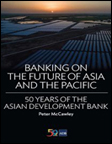 Banking on the Future of Asia and the Pacific: 50 Years of the Asian Development BankThis book tells the five-decade history of the Asian Development Bank (ADB), illustrating how the multilateral bank has grown and expanded, tackling Asia and the Pacific region’s economic development, and the evolution of its international development agenda. It discusses how ADB has helped promote regional cooperation and integration by developing subregional cooperation programs, including SASEC, which was formally established in 2001 as a project-based initiative to promote economic cooperation through the enhancement of cross-border connectivity and facilitation of trade. In 2006, the ADB Board approved the Regional Cooperation and Integration (RCI) Strategy based on four pillars: subregional economic cooperation on cross-border infrastructure and related software, trade and investment cooperation and integration, monetary and financial cooperation and integration, and cooperation in regional public goods. The RCI strategy envisaged ADB as a money bank, as a knowledge bank, as a capacity builder, and as an honest broker. Author: Peter McCawley Year: 2017 Download Tags: ADB, Development, Regional Cooperation, SASEC SASEC Powering Asia in the 21st Century SASEC Powering Asia in the 21st Century defines the SASEC Vision, framing the SASEC partnership in the larger context of the subregion’s collective growth and development by articulating shared aspirations of the SASEC countries (Bangladesh, Bhutan, India, Maldives, Myanmar, Nepal, and Sri Lanka), and setting the path to achieve these through regional collaboration. The SASEC Vision lays out a subregional transformative opportunity by leveraging natural resources, promoting industry linkages for the development of regional value chains, and expanding the region’s trade and commerce through the development of subregional gateways and hubs. This document is supplemented by SASEC Vision – Myanmar. Author: South Asia Subregional Economic Cooperation Year: 2017 Download Tags: SASEC, Trade Facilitation, Transport, Energy, ADB RCI 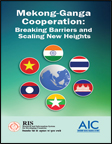 Mekong-Ganga Cooperation: Breaking Barriers and Scaling New HeightsThe Mekong-Ganga Cooperation (MGC) promotes intra-regional collaboration among Cambodia, India, Lao PDR, Myanmar, Thailand and Vietnam in the areas of trade, tourism, culture, education, and transport and communications. This book reviews how MGC cooperation has grown since MGC's inception in 2000, including expansion of their economic and cultural relations. Under India's Act East Policy, MGC has gained further momentum – endorsing a Plan of Action 2016-2018, and planning extended connectivity of the India-Myanmar-Thailand Trilateral Highway to Cambodia, Laos, and Vietnam. This report outlines important discussion points on trade, regional value chains, foreign direct investment, physical and digital connectivity, border connectivity, and cultural relations, to strengthen India and the Association of Southeast Asian Nation linkages through MGC. Author: Research and Information System for Developing Countries and ASEAN-India Centre Year: 2017 Download Tags: ASEAN, India, Southeast Asia, South Asia, Trade, Trade Facilitation Global Energy InterconnectionSustainable energy and climate change are major global concerns, yet three billion people around the world rely on wood, coal, or animal waste for cooking and heating. The interconnection of grids would open up opportunities for resource sharing and bring clean energy to much more of the world. This paper assesses benefits and outlines policy, technical, and economic preconditions for global energy interconnection. It analyzes global transmission scenarios and evaluates their impact on energy supplies and the environment. It also gives recommendations for setting standards, and where stakeholder involvement is necessary. Author: International Electrotechnical Commission Year: 2017 Download Tags: Energy, India, Nepal, Policy, Standardization, Sustainability, Trade, South Asia Implications of Brexit to the Asia-Pacific Region: with a Focus on Least Developed Countries (Trade Insights: Issue No. 20)This issue of Trade Insights, published by United Nations Economic and Social Commission for Asia and the Pacific, discusses how possible Brexit scenarios could adversely affect least developed countries in the Asia-Pacific region. Simulation results show that potential reduction in exports to the United Kingdom for fish, clothes, textiles, footwear, and other key items can range from 16% to 50% of their current export value. According to the study, countries heavily exposed to Brexit-induced risks must analyze the extent of such impact and engage the United Kingdom in discussions in order to limit negative impact. Author: Louis Graham, Arun Jacob, and Anders K. Møller Year: 2017 Download Tags: Asia-Pacific, Least Developed Countries, South Asia, Trade, UNESCAP, India, Bangladesh, Maldives, Myanmar, Nepal, Sri Lanka Emerging Trans-Regional Corridors: South and Southeast AsiaThis volume gathers perspectives from South Asia and Southeast Asia on trans-regional economic corridors, focusing on four planned projects—the Indo-Pacific Economic Corridor; the Bangladesh, China, India, and Myanmar Economic Corridor; the Maritime Silk Road initiative; and the Trans-Himalayan Economic Corridor. It underscores both opportunity and challenges promised by the economic corridors, discussing the socio-economic, environmental, security and political concerns from various stakeholders, while taking into account the rise of India and China as strong states and markets. This study also highlights the importance of upgrading India's infrastructure to promote connectivity to connect the region's economies. Author: K. Yhome and Rajeev Ranjan Chaturvedy, eds. Year: 2017 Download Tags: Asian Development Outlook 2017: Transcending the Middle-Income Challenge The Asian Development Outlook 2017 forecasts 5.7% growth for developing Asia in 2017 and 2018, and 7% and 7.2% for South Asia in 2017 and 2018. Resumption of growth in South Asia follows the brief slowdown in 2016 due to decline in fixed investment and impact of demonitization on trade and commerce. Growth in India is forecast at 7.4% in fiscal 2017 and 7.6% in 2018. In Bhutan, growth is expected to accelerate to 8.2% in 2017, with expanded investment in hydropower for export, and added capacity in electricity generation. Nepal's growth is expected to revive to 5.6% in 2017 with increased post-earthquake reconstruction and more reliable electricity. Author: Asian Development Bank Year: 2017 Download Tags: ADB, India, Bhutan, Nepal, South Asia Trade and the Post-2015 Development AgendaTrade and services are instrumental in achieving the Sustainable Development Goals. While openness to trade improves economic growth prospects, sound trade policy and efforts to reduce the costs of trade are necessary to bridge the link between trade growth and poverty reduction. For low income countries, there is still great scope to leverage trade for development, and pursue better access to a products and services to improve welfare, which can significantly contribute to economic development. In keeping with the post-2015 development agenda, this paper recommends sustained efforts by governments to reduce trade costs, support policy reforms to improve services trade, and focus on trade cost reduction and services trade facilitation. Author: Bernard Hoekman Year: 2017 Download Tags: Trade Facilitation, Services, Sustainable Development, Poverty Reduction, ADB 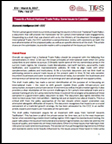 Trade Intelligence for the Private Sector Vol 17 – Towards a Robust National Trade PolicyThis paper provides an overview of the Ceylon Chamber of Commerce's (CCC) comments on the draft national trade policy for Sri Lanka prepared by Sri Lanka's Ministry of Development Strategies and International Trade. CCC's review focuses on ten key issues—trade liberalization; multilateral trading agreements, global value chains, global production networks; revenue considerations; innovation and technology upgrades; institutional reforms; regulatory reforms; government support for the private sector; rise of protectionism; digital trade and e-commerce; and future of existing bilateral and regional agreements. The Chamber puts forward that alongside a refocusing of Sri Lanka's trade policies toward international trade, new trade policy should tackle issues that arose from the current framework and be aligned with policies and institutions. It highlights the need for a forward thinking national trade policy that will improve Sri Lanka's competitiveness, and encompass interests of today's private sector as well as tomorrow's businesses and entrepreneurs. Author: CCC Economic Intelligence Unit Year: 2017 Download Tags: Sri Lanka, Economic Growth, Trade Facilitate Trade for Development: Aid for Trade The Aid for Trade program has been providing support to developing economies in tackling obstacles to growth through better facilitation of trade in the last 10 years. Since its launch in 2006, a total of $308 billion has been disbursed to finance aid-for-trade programs and projects, which are working to reduce trade and transport costs, promote trade expansion, and achieve economic and social objectives. As high trade costs persist in keeping developing countries from fully exploiting their trade and development potential, the Aid for Trade program remains highly relevant, and will help developing economies, including landlocked and small and vulnerable economies, achieve the 2030 Agenda for Sustainable Development. Author: William Hynes and Frans Lammersen Year: 2017 Download Tags: Trade, Development, Aid for Trade, Trade Facilitation, Transport, Bangladesh, Bhutan, Myanmar, Nepal, Least Developed Countries  Development of East Coast Economic Corridor and Vizag-Chennai Industrial CorridorThe East Coast Economic Corridor (ECEC)—India’s first coastal corridor—is an integrated economic development initiative that is expected to help pursue industrialization and integrate domestic companies into the global value chains of Southeast Asia and East Asia. Its development will start with Vizag–Chennai Industrial Corridor (VCIC), which covers about 800 kilometers and includes several ports and major industrial centers. This paper discusses strategies to consider when trying to improve shipping and air connectivity in the ECEC and Vizag–Chennai Industrial Corridor (VCIC). It stresses the importance of infrastructure development and regulatory reforms that facilitate increased connectivity. Author: Pritam Banerjee Year: 2017 Download Tags: Bangladesh, Connectivity, Economic Corridor, India, Infrastructure, Regional Integration, Trade Facilitation, Transport, Development, Economic Corridor Development, ADB RCI 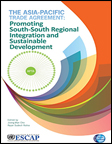 The Asia-Pacific Trade Agreement: Promoting South-South Regional Integration and Sustainable DevelopmentAs countries begin to depend on more each other, trade policy is helping achieve inclusive and sustainable development. Trade and investment are linked to the environment and social issues, and countries now realize that cooperation is necessary in approaching global and regional problems. The Asia-Pacific Trade Agreement (APTA), the oldest preferential trade agreement in the region, helps promote economic development and the adoption of mutually beneficial trade measures. This book gives an overview of the APTA and outlines potential benefits and challenges for members new to the APTA. The book details a possible road map for APTA and suggests that APTA move from the conventional preferential agreement to a comprehensive economic integration agreement by converting to FTAs in goods, services, investment, trade facilitation and non-tariff measures. Author: Joong-Wan Cho and Rajan Sudesh Ratna (editors) Year: 2017 Download Tags: Asia-Pacific Trade Agreement, Bangladesh, India, Sri Lanka, Regional Integration, Sustainability, UNESCAP Renewable Energy Sector in Emerging Asia: Development and Policies (TIID Working Paper No. 1/2017)Rapid economic growth in emerging Asia has led to a critical increase of greenhouse gas emissions. Transitioning to renewable energy sources would help reduce emissions. However, massive investment is needed to make that transition. According to this paper, targeted policy interventions are needed to facilitate trade and investment in the renewable energy sector and create “green jobs” in the low-carbon and resource-efficient sectors. Author: Masato Abe, Candice Lea Marie Branchoux, Jaewon Kim Year: 2017 Download Tags: Bangladesh, Energy, Governance, Hydropower, Employment, India, Myanmar, Sustainability, UNESCAP 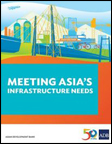 Meeting Asia's Infrastructure NeedsThis report estimates infrastructure investment needs in Asia and the Pacific for 2016-2030, updating the Asian Development Bank's assessment for 2010-2020 published in 2009. The report places developing Asia's investment needs at $26 trillion to maintain its growth momentum, eradicate poverty, and respond to climate change. While developing Asia's infrastructure, including its transport network and electricity generation capacity, has improved significantly over the years, it remains far from adequate – lack of reliable power supply continues to constrain economic growth and traffic congestion results in lost productivity, wasted fuel, and human stress. The report recommends $14.7 trillion investment for power and $8.4 trillion for transport. South Asia requires investments valued at 8.8% of gross domestic product. Author: Asian Development Bank Year: 2017 Download Tags: Asia, South Asia, Energy, Transport, Bangladesh, Bhutan, ADB, India, Maldives, Myanmar, Sri Lanka, Nepal 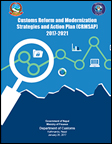 Customs Reform and Modernization Strategies and Action Plan 2017-2021The Customs Reform and Modernization Strategies and Action Plan 2017-2021 of the Nepal Department of Customs (DOC) aims to serve as a blueprint of Customs reform for the next four years, with a vision to support Nepal's initiatives toward economic and social prosperity. With Nepal seeing continuous increase of cross-border trade over the last decades, this Plan is being implemented to align Nepal toward international standards. It outlines the DOC's vision, mission, guiding principles, as well as strategies, such as expediting legitimate trade facilitation and enhancing Customs automation and data management, to create a conducive environment for seamless movement of cargo traffic to and from the borders, and help in lowering transaction costs through greater transport facilitation. Author: Nepal Department of Customs Year: 2017 Download Tags: Customs, Customs Valuation, Nepal, Trade Facilitation, Import, Export, Trade, Revised Kyoto Convention 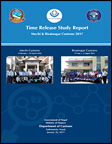 Time Release Study: Mechi and Biratnagar Customs 2017Time Release Study is a special tool developed by the World Customs Organization to measure effectiveness of operational procedures carried out by Customs, other regulatory agencies and private sector stakeholders in the standard processing of imports, exports, cross border and transit movements. A key activity identified in Nepal's Customs Reform and Modernization Strategies and Action Plan 2013-2017, it identifies the average time taken for clearance of consignments from entry to exit in the Customs area, enabling possible corrective measures to
improve performance. This Study was undertaken to support trade facilitation measures being introduced by the Nepal Department of Customs to reduce bottlenecks to faster Customs clearance, and promote seamless movement of cargo traffic to and from the Country. Author: Nepal Department of Customs TRS Working Group Year: 2017 Download Tags: Trade Facilitation, Time Release Study, Import, Export, Trade, Nepal, WCO 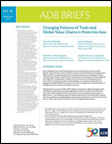 Changing Patterns of Trade and Global Value Chains in Postcrisis AsiaThis Asian Development Bank brief examines how patterns of trade and global value chains (GVCs) in developing Asia have changed since the global financial crisis. The paper reports that export slowdown in the region was caused by a combination of weak import demand for Asian goods in advanced economy markets, structural transformation and reduced import demand in the People’s Republic of China, and possible impact of increasing non-tariff measures. According to this paper, it further states that much of the weak import demand is likely
to be temporary — developing Asia gained a 1.5% increase in exports in 2016, after a 0.8% decline in 2015. Among South Asian economies, India and Sri Lanka are expected to have better export volume growth in 2016. Author: Ganeshan Wignaraja, Juzhong Zhuang, Mahinthan J. Mariasingham, and Madeline Dumaua-Cabauatan Year: 2017 Download Tags: Global Value Chains, Import, Export, India, Sri Lanka, Non-Tariff Measures, Trade Facilitation Time, Uncertainty, and Trade FlowsThis paper assesses the impact of international transit time and time-related uncertainty on bilateral trade, including their impact on trade costs. It concludes that international transit time matters primarily for South-South trade, while uncertainty is more important for North-North trade. Both factors are confirmed to be statistically and economically significant determinants of bilateral trade, including global value chains, and strengthens the ground on the emerging policy emphasis to address the overall costs faced by supply chain operators, including costs linked to uncertainty. Author: Jose Anson, Jean-Francois Arvis, Mauro Boffa, Matthias Helble, and Benjamin Shepherd Year: 2017 Download Tags: Trade, Trade Facilitation, Transport, South-South Trade Accumulating Trade Costs and Competitiveness in Global Value ChainsThis paper examines the implications of trade costs, including applied tariffs, transportation and insurance costs, on competitiveness at industry, national and global levels, and identifies where trade facilitation investment would have the highest social returns from the perspective of global value chains (GVCs). With trade costs amplified along GVCs, profitability of individual business operations are affected by incurred transaction expenses. The authors conclude that direct benefits of trade facilitation will be higher for countries that are not yet well integrated into international trade, but key traders who are at the core of GVCs also stand to gain much. Author: Antonia Diakantoni, Hubert Escaith, Michael Roberts and Thomas Verbeet Year: 2017 Download Tags: Trade, Tariff, Transport, Trade Facilitation, Global Value Chains South Asia’s Turn: Policies to Boost Competitiveness and Create the Next Export PowerhouseWill South Asia become the next global factory? By 2030 more than a quarter of the world’s working adults will live in South Asia. As the work force ages and labor costs rise in China and other East Asian countries, many eyes turn to South Asia. According to this report, to realize the region’s potential, countries in South Asia should increase regional and global integration, take advantage of agglomeration economies, strengthen firm capabilities, and improve the business environment. Author: Gladys Lopez‐Acevedo, Denis Medvedev, and Vincent Palmade Year: 2017 Download Tags: Bangladesh, India, Regional Integration, South Asia, Trade, WB Doing Business 2017: Equal Opportunity for AllGovernments including that of India have relied on Doing Business to provide insights into good practices worldwide. Doing Business 2017: Equal Opportunity for All presents quantitative indicators on business regulations that can be compared across 190 economies. It shows how South Asia can work to improve certain areas, including removing restrictions on women’s right to work. It also shows how South Asia has been the most successful region in terms of trading across borders. Bhutan, with a global ranking of 73, ranks highest among South Asian countries. Author: World Bank Group Year: 2017 Download Tags: Trade Facilitation, Ease of Doing Business, Transport, WB World Tariff Profiles 2016World Tariff Profiles, a joint publication of the World Trade Organization (WTO), International Trade Centre, and the United Nations Conference on Trade and Development, provides comprehensive information on tariff parameters imposed by the 164 WTO members—including Bangladesh, India, Maldives, Myanmar, Nepal, and Sri Lanka— and other countries and Customs territories with available data on imports—including Bhutan, a WTO Observer. It contains individual country tariff profiles, and statistics on non-tariff measures in effect as of December 2015. This 2016 edition also contains a discussion of the 2017 Harmonized System, which will affect around 15% of goods traded globally. Author: World Trade Organization, International Trade Centre, and the United Nations Conference on Trade and Development Year: 2016 Download Tags: Tariff, Trade Facilitation, Customs For a Shared Future of South Asia: Trade Insight, Vol. 12, No. 3This volume focuses on the South Asian Association for Regional Cooperation (SAARC) as a means for fostering regional cooperation to increase stability and development in the region. It urges SAARC member countries to cooperate, highlighting how economic integration and involving non-state actors can strengthen overall cooperation in South Asia, and help secure regional peace and security. It includes a discussion on the Bangladesh-Bhutan-India-Nepal as an economic corridor, South Asian drivers of regional integration, and the Belt and Road initiative. Author: South Asia Watch on Trade, Economics, and Environment Year: 2016 Download Tags: SAARC, Regional Cooperation, BBIN Study for Development of a Potential Hydropower Plant in South AsiaRapid development in South Asia has produced a huge surge in energy demand. Nepal, with more than 83,000 megawatts of potential hydropower supply, can significantly increase the South Asian Association for Regional Cooperation (SAARC) region's energy security. This study highlights ongoing hydropower projects in Nepal, in particular, the Sunkoshi 2 Storage Project, which has the potential to become a regional hydropower plant in South Asia. It also emphasizes the need to expand the region's power transmission infrastructure to promote power trade, and updating of policies that govern cross-border electricity trade among countries in the region. Author: SAARC Energy Centre Year: 2016 Download Tags: Hydropower, Energy, Nepal, SAARC, Trade BIMSTEC: The Road AheadThis report examines how the Bengal Initiative for Multi-Sectoral Technical and Economic Cooperation (BIMSTEC) region can utilize its intraregional network to deepen regional cooperation and integration to better the lives of the roughly 1.5 million people living in this region. It discusses issues of trade, investment, regional value chains, and connectivity, in the context of making the BIMSTEC grouping more relevant and meaningful. With BIMSTEC's enormous potential waiting to be tapped, this report urges the grouping to take advantage of newly available opportunities and harvest low
hanging fruits, including establishment of a BIMSTEC power trade network,
promotion of business-to-business and people-to-people contact, enhancement of
regional value chains, and engaging the experience and expertise of BRICS
economies. Author: Research and Information System Year: 2016 Download Tags: BIMSTEC, Regional Cooperation, Thailand, Trade, Energy Paperless Trade in Regional Trade AgreementsThis working paper provides a comprehensive list of paperless trade measures in regional trade agreements, which have become more extensive, covering increasingly specific areas including certificate of origins and sanitary and phytosanitary certificates. It also confirms that the number of paperless trade measures have doubled between 2005-2008 and 2013-2016 at the global level, with regional trade containing more provisions than those featured in the World Trade Organization's Trade Facilitation Agreement. It introduces the new United Nations Treaty and Framework Agreement on Cross-Border Paperless Trade in Asia and the Pacific, which aims to become a tool for harmonized implementation of paperless trade provisions. Author: Yann Duval and Kong Mengjing Year: 2016 Download Tags: Paperless Trade, Sanitary and Phytosanitary Measures, Trade Facilitation, India Trade Facilitation and Global Value Chains: Opportunities for Sustainable DevelopmentThis paper analyzes the relationship between global value chains (GVCs) and trade facilitation, and its contribution to sustainable development outcomes on low-income and least developed countries (LICs and LDCs). A key insight of the paper concludes that it is not fundamentally GVCs that drive the sustainable development implications of improved trade facilitation, but the resulting extension and intensification of economic activity. It underlines the importance of putting in place domestic regulatory infrastructure that considers the appropriate economic, social, and environmental dimensions to ensure that GVCs remain consistent with the global commitment to sustainable development, while expanding economic opportunities of LICs and LDCs. Author: Ben Shepherd Year: 2016 Download Tags: Trade Facilitation, Trade, Global Value Chains, Sustainability, Sustainable Development, Least Developed Countries, LDC 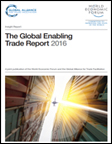 Global Enabling Trade Report 2016The Global Enabling Trade Report has been created to provide insight into trade policy and practice. It includes the Enabling Trade Index (ETI), which assesses the extent to which economies have in place institutions, policies, infrastructures and services facilitating the free flow of goods over borders and to their destination. This edition highlights that while an increasingly globalized trading system has been lifting millions out of poverty, trade barriers and costs are still preventing millions of people around the world from engaging in international trade. It reports that all South Asian economies have improved their ETI score over the past two years, with Bhutan as the most improved country in the region, jumping 12 places to 92, followed by India at 102, Sri Lanka at 103, Nepal at 108, Pakistan at 122, and Bangladesh at 123, yet the region remains the most closed worldwide. While South Asia has improved its access to foreign markets and adoption of ICTs, it needs to improve access to its domestic market – on average, South Asian countries impose a tariff of 16.7% on imported products – and enhance its transport infrastructure, particularly in Bhutan and Nepal. Author: Global Alliance for Trade Facilitation and the World Economic Forum Year: 2016 Download Tags: Trade, Trade Facilitation, Transport, Trade Policy, World Economic Forum, Bangladesh, Bhutan, India, Sri Lanka, Pakistan 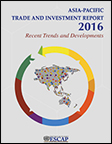 Asia-Pacific Trade and Investment Report 2016: Recent Trends and DevelopmentsThe Asia-Pacific Trade and Investment Report 2016 reports that the Asia-Pacific region is still the largest exporter of goods globally, with a share of 40%. Its share in commercial services trade is also on the rise, while restrictiveness of services trade has not increased. Foreign direct investment (FDI) inflows is also growing at a much faster pace compared to the global average, with special economic zones being used as one of the modalities to attract FDI. India, in particular, has been attracting an increasing portion of FDI inflows, both from outside and inside the region. While economies in Asia and the Pacific continue to make progress toward trade facilitation, there are still huge gaps among subregional economies, with much needing to be done to reduce trade costs. Furthermore, efforts undertaken to reduce trade costs through trade facilitation have been partially offset by imposition of a large number of new trade distortive measures globally and regionally, with most of these new measures falling under the non-tariff category. Author: United Nations Economic and Social Commission for Asia and the Pacific Year: 2016 Download Tags: Export, Trade Facilitation, Non-Tariff Measures, FDI, South Asia, India, Special Economic Zones Research Handbook on Trade in ServicesThis Research Handbook explores the latest developments in services trade by drawing on insights from experts with a range of perspectives, including empirical economics, law and global political economy. The book further chronicles the rising stakes and involvement of developing countries in global services trade, notably their growing insertion in global value chains, as well as the latest advances and remaining challenges in the statistical measurement of trade in services. Author: Pierre Sauvé and Martin Roy, editors Year: 2016 Download Tags: Services, Trade, Economics, Trade Facilitation, Trade Policy Economic Benefits from Nepal-India Electricity TradeThis report confirms Nepal and India's viable electricity export potential, and highlights how facilitating cross-border trade of electricity will benefit both countries. In Nepal, substantial economic gains can boost the economy and improve the well-being of its people—in 2045 under the accelerated power trade scenario, electricity trade revenue can bring in up to $9.8 billion. In India, gains from cross-border trade centers on lower electricity system cost—hydropower imports from Nepal will allow India to forgo some investment needed to meet its capacity demand. Furthermore, hydropower will complement India's solar and wind power generation, offering an affordable and convenient renewable resource to meet its evening peak demand. Author: South Asia Regional Initiative for Energy Integration Year: 2016 Download Tags: Energy, Trade, India, Nepal, Hydropower Capital Market Integration in South AsiaThis book discusses the potential capital market products and activities within South Asia that stakeholders in the region could explore to help the South Asian Association for Regional Cooperation (SAARC) region further realize its potential. Conventional investment, such as funds, global depository receipts, as well as promising opportunities that factor the region's demographics and socioeonomics are considered in this book, with arguments aimed toward investors and institutions. The book demonstrates both retail and institutional investor interest in this combined high-growth region by offering scope for yield, diversification and risk mitigation, maximized upside from multiple growth markets, minimized downside through low-correlation constituents, and makes the case why now is an opportune time to look at SAARC. Author: Sourajit Aiyer Year: 2016 Download Tags: Investment, SAARC, Trade, Economic Corridor 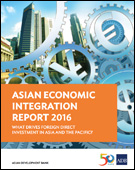 Asian Economic Integration Report 2016: What Drives Foreign Direct Investment in Asia and the Pacific?The 2016 Asian Economic Integration Report reviews regional economic cooperation and integration in Asia and the Pacific, amidst the rising global uncertainty following the United Kingdom’s referendum on leaving the European Union and the U.S. election, slower-than-expected global economic recovery, and ongoing economic restructuring in the People’s Republic of China and growth moderation. Asia faces heightened uncertainty–trade growth decelerated in 2015, falling to 2.3% in 2015; subregional trade linkages continue to strengthen, but inter-subregional trade linkages weakened; and non-tariff measures have become major obstacles to trade. In South Asia, SASEC cooperation has improved access to key markets in smaller economies, reduced real trade costs and behind-the-border barriers to stimulate investment; and enabled cross-border power exchanges to ensure power supply affordability, reliability, and overall grid stability. However, the SASEC agenda needs to be framed within wider integration processes taking place in Asia in the next decade to enhance economic linkages, and harness the full potential of Asian integration. Author: Asian Development Bank Year: 2016 Download Tags: ADB, ASEAN, Asia-Pacific, Development, FDI, Free Trade Agreements, Regional Cooperation, Regional Integration, SASEC, Trade Facilitation, UNCTAD, Bangladesh, Bhutan, India, Maldives, Nepal, Sri Lanka Competitiveness of South Asia’s Container Ports: A Comprehensive Assessment of Performance, Drivers, and CostsAs a result of inefficiencies in South Asia’s container ports, the average cost of exporting or importing a container in the region is more than double that in East Asia. Better port logistics could help increase trade, diversify exports, attract more foreign direct investment, and spur economic growth. As container traffic continues to grow in South Asia, the best way to improve port performance is by increasing productivity. This report examines the performance of the 14 largest container ports in the region, identifying key drivers of port performance and examining differences in performance across ports. Author: Matías Herrera Dappe and Ancor Suárez-Alemán Year: 2016 Download Tags: Customs, Economic Growth, FDI, Infrastructure, Investment, South Asia, Trade, WB Connecting Bangladesh: Economic Corridor NetworkEconomic corridors anchored on transport connectivity could significantly boost Bangladesh's economic growth. This paper presents a new set of corridors for Bangladesh – a nine-corridor comprehensive integrated multimodal economic corridor network that will enhance Bangladesh’s role as land bridge between South Asia and Southeast Asia, and between South Asia and northern Asia. These proposed corridors are designed to sustain robust economic growth over the long term by improving regional connectivity, transit, and integration, alongside trade facilitation measures. Author: Mohuiddin Alamgir Year: 2016 Download Tags: Economic Corridor, Bangladesh, South Asia, Southeast Asia, Connectivity, Transport, Trade Facilitation, ADB RCI Leveraging Urbanization in South Asia: Managing Spatial Transformation for Prosperity and LivabilityAs South Asian economies improve, they have the potential to greatly improve their prosperity and livability for the people of the region by improving their state of urbanization. Messy and hidden urbanization that leads to slums and sprawls is the result of failure to address congestion constraints arising from rapid growth of urban populations. This book examines the state of South Asia's urbanization – it reviews gaps in markets and policies that have hindered its proper growth, and discusses key policy areas that must be undertaken, including improvement in housing provisions, infrastructure, and basic services. Author: Peter Ellis and Mark Roberts Year: 2016 Download Tags: Economic Corridor, Urban Development, Governance, Sustainability, South Asia, Social Services SME Competitiveness Outlook: Meeting the Standard for TradeStandards and regulations for goods and services are important to international trade and value chains. They ensure consumer protection, determine compatibility, and promote environmental sustainability. This SME Competitiveness Outlook focuses on helping small and medium-sized enterprises (SME) make the most of standards and regulations to increase their competitiveness. Findings include strategies for SME managers on selecting and implementing standards and regulations, and an action plan for policymakers and trade and investment support institutions involved in aiding SMEs compete in markets where standards and regulations matter. Author: International Trade Centre Year: 2016 Download Tags: Trade, Small and Medium Enterprises, Bangladesh, India, Nepal, Sri Lanka, WTO, Global Value Chains World Trade Report: Levelling the Trading Field for SMEsParticipation in international trade, once exclusive, can progressively become more inclusive. But while new opportunities are opening up for small to medium-sized enterprises (SMEs), old barriers to international trade remain. This report highlights national and international policy actions that would enhance the ability of SMEs to participate in world markets more effectively. It says that for open trade and global integration to fully benefit everyone, it is crucial to ensure that all firms—not just large corporations—can succeed in today’s global marketplace. Author: World Trade Organization Year: 2016 Download Tags: Trade, WTO, Small and Medium Enterprise, Global Value Chains Implementing the Trade Facilitation Agreement: From Vision to RealityLow income to upper-middle income countries stand to gain a 14.6% to 16.5% reduction in trade costs upon implementation of the World Trade Organization's (WTO) Trade Facilitation Agreement (TFA). This publication looks at progression of the TFA – from conclusion of the talks at the 2013 Bali Ministerial Conference to preparations for the Agreement to take effect, as the valedictory moment of the TFA's entry into force nears. It highlights milestones, discusses the state of the ratification process, reviews implementation schedules, and examines work still to be done. Author: Nora Neufeld Year: 2016 Download Tags: Trade Facilitation, WTO, Least Developed Countries, Import, Export Trade Costs and Inclusive Growth: Case Studies Presented by WTO Chair-holdersThese contributions from participants of the World Trade Organization (WTO) Chairs Programme—which supports trade-related activities by academic institutions in developing countries—offer insightful research on opportunities that open up for developing countries when trade costs are reduced. Analyzing the potential impact of the WTO Trade Facilitation Agreement implementation in various developing regions of the world, this publication offers detailed country-level analysis on benefits of trade facilitation, including export diversification, greater global value chain participation, insertion of SMEs into international trade, the attraction of more foreign direct investments, and better governance. Author: Robert Teh, Maarten Smeets, Mustapha Sadni Jallab and Fatima Chaudhri, editors Year: 2016 Download Tags: Trade Facilitation, Global Value Chains, Small and medium enterprises, FDI, Governance, WTO South Asia Economic Focus, Fall 2016: Investment Reality CheckSouth Asia continues on a path of gradual acceleration in 2016, led by a solid India. However, amid the resilience to external headwinds, including China’s slowdown and uncertainty surrounding monetary policy in advanced economies, South Asia is starting to feel the effect of slowing remittance flows or waning oil price dividends. Against this backdrop, this World Bank publication forecasts growth for the region at 7.1% in 2016, with its medium-term performance strongly dependent on investment and export turnout. India is set to grow at 7.6% in 2016, with the same speed as in 2015, but may increase its pace again in 2017 to 7.7%. The report highlights how private investment is a key future growth driver across South Asia that could help further boost the pace of economic activity. Author: World Bank Year: 2016 Download Tags: India, South Asia, Investment, Economic Growth, WB, Export 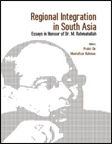 Regional Integration in South Asia: Essays in Honour of Dr. M. RahmatullahBuilding efficient transport linkages within and across countries in South Asia is crucial to development of production networks and value chains, and promotion of trade and investment. This collection of essays honors Dr. M. Rahmatullah, who championed the cause of multimodal connectivity in South Asia for seamless movement of goods across Asia, and dreamt of building an integrated South Asia through corridors and gateways to be connected with pan-Asian transport networks. A valuable resource for policymakers, academics, and practitioners working on issues of South Asian regional integration, this book looks at progress made on facilitating trade and enhancing connectivity in the region, assesses policy priorities, implementation imperatives, and emerging challenges to South Asian trade and integration, and gives recommendations on further strengthening South Asian integration. Author: Prabir De and Mustafizur Rahmant Year: 2016 Download Tags: Transport, Trade, Trade Facilitation, Connectivity, South Asia, South Asian Economic Union Improving Energy Efficiency in South AsiaThis paper examines areas where the efficiency of South Asian power systems could be significantly increased, such as the operation of thermal power plants and transmission systems. It also looks at ways to increase conservation by users through time-of-use electricity tariffs, appliance standards, and demand control through smart metering. It concludes that South Asia has a significant potential for energy efficiency improvement in the power sector, which can be realized by implementing policies and programs that can readily complement the existing institutional framework. Author: Priyantha Wijayatunga and Tilak Siyambalapitiya Year: 2016 Download Tags: Energy, ADB, South Asia, ADB RCI Trade, Testing and Toasters: Conformity Assessment Procedures and the TBT CommitteeDuplication, delays or discrimination in Conformity Assessment Procedures (CAPs) can significantly increase trade costs: this risk is reflected in the growing importance of CAPs in World Trade Organization (WTO) discussions, and bilateral and regional free trade agreements. The paper uses new data on government-to-government discussions of CAPs in the WTO Committee on Technical Barriers to Trade (TBT) and studies trade issues that WTO members encounter with CAPs, based on specific trade concerns raised during 2010-2014. Author: Devin McDaniels and Marianna Karttunen Year: 2016 Download Tags: Technical Barriers to Trade, WTO, Trade Disaster Risk Financing in BangladeshBangladesh is disaster-prone, with frequent severe floods and cyclones. Applying appropriate disaster risk financing is key to minimizing economic impacts from disasters, and sustaining the country’s development. This paper analyzes economic losses in Bangladesh caused by natural disasters from 2000 to 2013 and the funding gap, due in part to insufficient financial preparedness in disaster risk management. Author: Mayumi Ozaki Year: 2016 Download Tags: ADB, Bangladesh, South Asia Asia-Europe Connectivity Vision 2025: Challenges and OpportunitiesThe 11th Asia-Europe Meeting (ASEM) Summit held in Mongolia in 2016 saw ASEM member countries renew their commitments for deepened engagement between Asia and Europe. This report on the Summit provides ideas for an ASEM roadmap for connectivity, recognizing the need for sustainability and scalability. The report draws lessons from efforts by the Association of Southeast Asian Nations to bring together peoples, goods, services, and capital. ASEM, an intergovernmental forum for dialogue and cooperation, comprises 53 member countries, including India and Bangladesh. Author: Anita Prakash, editor Year: 2016 Download Tags: ASEAN, India, Bangladesh, Connectivity Reducing Trade Costs in LDCs: The Role of Aid for TradeThis report analyzes the role of Aid for Trade in reducing trade costs in least developed countries (LDCs), where trade costs are high and constitute a major impediment to the countries' participation in international trade. The most important sources of trade costs in LDCs are inadequate transport infrastructure, cumbersome border procedures, and compliance with non-tariff measures for merchandise exports. The study covers countries from around the world, including trade facilitation and trade restrictions in Nepal, Bhutan, India, and other Asian countries. Author: Rainer Lanz, Michael Roberts, Sainabou Taal Year: 2016 Download Tags: Trade, Trade Facilitation South Asian Approach to Sustainable Development Goals: Trade Insight Vol. 12, No. 1, 2016The paper, published by South Asia Watch on Trade, Economics and Environment, situates the challenges of implementation of the Sustainable Development Goals (SDGs) in the South Asian context. Noting that the delivery of the Millennium Development Goals in the region had been quite uneven, the paper examines the potential for regional cooperation to better achieve the SDGs. The paper then tries to chart a South Asian pathway for SDGs implementation and put forward some concrete proposals for South Asian countries. Author: Debapriya Bhattacharya and Umme Shefa Rezbana Year: 2016 Download Tags: ASEAN, India, Economic Integration Celebrating the Third Decade and Beyond: New Challenges to ASEAN-India Economic PartnershipThe relationship between ASEAN and India is set to deepen as ASEAN and India step up their collaboration across a range of economic and strategic issues, including trade and connectivity, culture, people-to-people links, trans-national terrorism, and maritime security. This book seeks to review the past and suggest ways to further strengthen economic partnership between ASEAN countries and India. It primarily deals with the economic integration issues between ASEAN and India, and assesses policy priorities, effectiveness, implementation imperatives and challenges. The book tries to capture essential features of cross-cutting issues and attempts to draw policy implications. Author: KW Publishers Year: 2016 Download Tags: ASEAN, India, Connectivity SARSO News: Vol. 2 No. 3The South Asian Regional Standards Organization (SARSO) newsletter features updates on SARSO events and activities. This issue highlights SARSO efforts to strengthen international relations, through its participation in the 39th International Organization for Standardization (ISO) meeting in Beijing, China, and related activities. The issue also features a meeting with the Asian Development Bank (ADB), where ADB briefed SARSO on the progress of diagnostic studies in South Asia Subregional Economic Cooperation (SASEC) member countries. Author: South Asian Regional Standards Organization Year: 2016 Download Tags: SARSO, ADB, SASEC 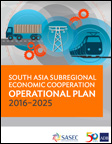 South Asia Subregional Economic Cooperation Operational Plan 2016-2025The SASEC Operational Plan 2016–2025 embodies the strategic objectives and operational priorities of the SASEC Program for the next decade. It expands the SASEC Program's focus beyond intraregional cooperation to developing links with Southeast and East Asia, thus widening the scope of transport, trade facilitation, and energy cooperation. Economic and industrial corridor development, which will arise from improved connectivity, has been introduced as a priority initiative. SASEC 2025 is supported by a list of potential projects to be implemented in the subregion during 2016-2025, that will advance the SASEC goals of multi-modal connectivity, energy security and the growth of regional energy markets, and increased intra- and inter-regional trade. An
update to the operational plan was
published in 2020. Author: Asian Development Bank Year: 2016 Download Tags: SASEC, ADB, Trade Facilitation, Economic Corridor, Transport, Myanmar The Little Data Book 2016The Little Data Book 2016 offers a quick reference of World Development Indicators 2016, presenting the latest available data for World Bank member countries and other economies in 214 tables. Regional and income group aggregates are also covered in the 12 summary tables, including South Asia. The book includes selected indicators used to monitor progress toward the Sustainable Development Goals. Author: World Bank Year: 2016 Download Tags: Sustainability, South Asia, Economic Growth 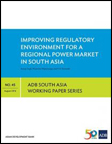 Improving Regulatory Environment for a Regional Power Market in South AsiaCountries in South Asia continue to experience poor access to energy, energy shortages, and concerns for energy security. Bilateral energy trading, with its limited scope, leaves untapped the vast economic, reliability, and environmental benefits of energy cooperation in the region. Improving access to modern energy sources through regional cooperation contributes toward economic growth, and better and more sustainable living conditions in South Asia. Regional energy cooperation supports the development of regional primary energy sources to generate electricity, cross-border transmission infrastructure, and a regional framework that will coordinate energy resource development and trade of electricity across the region. However, this will only be possible with appropriate policies and harmonized legal and regulatory frameworks in all necessary systems. Experience across the world indicates that such legal and regulatory changes can be accomplished successfully. Author: Anoop Singh, Priyantha Wijayatunga, and P. N. Fernando Year: 2016 Download Tags: Energy, Regional Cooperation, South Asia, ADB RCI 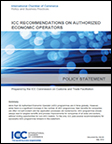 ICC Recommendations on Authorized Economic OperatorsThe World Customs Organization (WCO) developed the WCO Framework of Standards to Secure and Facilitate Global Trade (SAFE), of which the Authorized Economic Operator (AEO) program is an integral part, referring to manufacturers, importers, exporters, brokers, carriers, consolidators, intermediaries, ports, airports, terminal operators, integrated operators, warehouses, distributors, and others that have been approved by or on behalf of a national Customs administration as complying with WCO or equivalent supply chain security standards. AEO accreditation provides several benefits, including immediate release procedures self-assessment, and relief from guarantee/bond requirements. With AEO programs globally on the rise, the International Chamber of Commerce has put together several recommendations for successful AEO programs that lead to tangible benefits and process improvements for companies of all sizes and sectors, without limiting opportunities for non-AEO traders. Author: ICC Commission on Customs and Trade Facilitation Year: 2016 Download Tags: Customs, Trade Facilitation, WCO 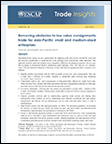 Removing Obstacles to Low Value Consignments (Trade Insights: Issue No. 18)Diffusion of digital technology and digitalization of products and services are allowing developing country small and medium-sized enterprises (SMEs)—which generate the majority of employment, especially in landlocked developing countries such as Nepal—to become globally competitive and participate in international trade. However, several barriers continue to hinder developing country SMEs to maximize benefits of cross-border digital trade. This publication recommends critical actions, including raising de-minimis thresholds; reducing Customs document requirements; developing low-cost and efficient transportation, delivery services, telecommunications and broadband networks; and establishing a legal framework that enhances conduct of online transactions. Additionally, neighbors in the region must coordinate and work together to build the required infrastructure, and to allow for mutual recognition or harmonization of systems, procedures, enforcement mechanisms and laws affecting digital trade. Author: Pascale Bourquin and Adam Heal Year: 2016 Download Tags: Small and Medium Enterprise, Nepal, ICT, Customs, Trade Facilitation SARSO News Volume 2, Issue 2The South Asian Regional Standards Organization (SARSO) newsletter features updates on SARSO events and activities. This issue highlights initiatives by SARSO to harmonize standards and improve conformity assessment in the region through workshops, and also meetings of its sectoral technical committees. It also discusses the Cooperation Agreement signed by SARSO and the International Organization for Standardization, to help facilitate the flow of goods and services, and participation of SARSO in a meeting organized by the private sector on 'Promoting Trade in Bangladesh-Bhutan-India-Nepal' region. Author: South Asian Regional Standards Organization Year: 2016 Download Tags: Standards, Trade Facilitation, SAARC, BBIN, South Asia  Regional Organizations Cooperation Mechanism for Trade Facilitation (ROC-TF) Newsletter: Issue X, August 2016This issue highlights the framework agreement on cross-border paperless trade facilitation adopted by the United Nations Regional Commission for Asia-Pacific, which will facilitate the exchange of electronic trade data and documents between participating United Nations Economic and Social Commission for Asia and the Pacific (UNESCAP) member states, and the 2016 Global Facilitation Partnership for Transportation and Trade forum. The latterencourages the private sector to mobilize expertise in support of trade facilitation reforms to develop effective trade facilitation solutions for small and medium-sized enterprises. The Newsletter also features SASEC-supported initiatives, including the launch of the new Maldives Customs Service training module on Customs valuation, as well as data collection for establishing the Trade and Transport Facilitation Monitoring baseline in Bhutan. The ROC-TF newsletter is a biannual publication featuring updates, publications and forthcoming activities of regional and international organizations working on trade facilitation in the Asia-Pacific region, including the Asian Development Bank, the World Customs Organization, and UNESCAP. Author: United Nations Economic and Social Commission for Asia and the Pacific Year: 2016 Download Tags: Trade Facilitation, ICT, Maldives, Customs, SASEC, Customs Valuation, Bhutan 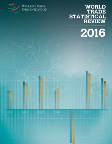 World Trade Statistical Review 2016The World Trade Statistical Review is the World Trade Organization's latest flagship publication offering a detailed analysis of the latest developments on global trade in goods and services—including developments in trade policy and participation of developing economies and least developed countries—examined through analytical chapters, complemented by over 50 tables. The publication reports that in 2015, developing Asia represented 67% of developing economies’ exports. In merchandise trade, India ranked 9th among the world's top exporter of agricultural products, and continues to be one of the top 3 textile exporters, which accounts for nearly 2/3s of world exports. A 25% decline in LDC exports was reported, due to the negative impact of the drop in fuel prices and mining products. LDC participation in global exports of commercial services also remained negligible at 0.8%. In trade policy making, the publication reported that WTO members introduced 132 measures to facilitate trade, yet applied 154 new trade-restrictive measures during the period between mid-October 2015 and mid-May 2016. Author: World Trade Organization Year: 2016 Download Tags: Trade, Export, India, Least Developed Countries 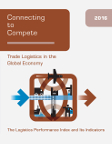 Connecting to CompeteConnecting to Compete scores and benchmarks countries’ performance on logistics, which is determined by various factors including infrastructure, regulations, policies, geography, and political economy. In the 2016 Logistics Performance Index (LPI), which measures the efficiency of international supply chains, the “logistics gap” between more and less developed countries remain evident. Among SASEC member countries, India is a top performing lower-middle-income economy, improving its rank from 54 in 2014 to 35 in 2016. Bangladesh is ranked 87, Maldives is ranked 104, Nepal is ranked 124, and Bhutan is ranked 135. The publication remarks that coastal countries score better than landlocked countries—a pattern clearly evident in South Asia—and notes that lack of integration in the region keeps the good logistics performance of India from improving the rankings of its neighbors. For countries at the bottom of the rankings, border management reforms continue to be a serious concern, as paperwork and long delays constrain trade efficiency. Author: Jean-François Arvis, Daniel Saslavsky, Lauri Ojala, Ben Shepherd, Christina Busch, Anasuya Raj, and Tapio Naula Year: 2016 Download Tags: Logistics, Business Efficiency, Trade Facilitation 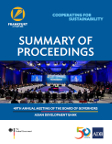 Summary of Proceedings of the 49th Annual Meeting of the Board of GovernorsThis publication provides a summary of the proceedings of the 49th Annual Meeting of the Asian Development Bank (ADB) Board of Governors, held in Frankfurt, Germany from 2-5 May 2016. It also includes statements from the Governors of ADB member countries, including SASEC countries. In his address, Mr. Abul Maal Muhith, Governor, Bangladesh, called for further acceleration of ADB's regional cooperation and integration strategy, which could play a critical role in accelerating economic growth, reducing poverty and economic disparity, and raising productivity and employment and environmental sustainability in Bangladesh, and lauded ADB's support in the signing of the landmark Bangladesh-Bhutan-India-Nepal Motor Vehicle Agreement (BBIN MVA). Mr. Arun Jaitley, Governor, India, highlighted India's strong and renewed commitment to regional cooperation in South Asia, which was demonstrated with the signing of the BBIN MVA and ongoing negotiations for the India-Myanmar-Thailand Highway. He also emphasized partnership between ADB and India in the development of the East Coast Economic Corridor, with initial focus on the ‘Vizag Chennai Industrial Corridor’, which will play a major role in connecting India to global production networks and value chains in the ASEAN region. Author: Asian Development Bank Year: 2016 Download Tags: ADB, Bangladesh, India, Regional Cooperation, Poverty Reduction Asian Development Outlook 2016 Supplement: Asia's Growth Prospects Undimmed by Brexit VoteRecent global developments have prompted revisions to developing Asia's 2016 and 2017 growth outlook, as published in March in Asian Development Outlook 2016 (ADO 2016). Uncertainty following the British vote to leave the European Union chilled already tepid recovery in the euro area. While developments have affected developing Asia’s currency and stock markets, its impact on the real economy in the short term is expected to be small. This Supplement expects the region to expand by 5.6% in 2016 and 5.7% in 2017. India has shrugged off global headwinds and is expected to grow by 7.4% in 2016 and 7.8% next year. South Asia as a whole will be the region’s fastest growing subregion. Author: Asian Development Bank Year: 2016 Download Tags: ADB, South Asia, Development The Little Green Data Book 2016The Sustainable Development Goals (SDGs) put environmental concerns on par with economic and social ones. The environment cuts across all the SDGs and is directly reflected in at least seven goals. The 2016 Little Green Data Book provides 50 indicators for 200 countries. Several indicators have the potential to measure progress on the SDGs as well as highlight important trends in the environment more broadly. The indicators are part of the larger World Development Indicators compiled annually by the World Bank from many different data sources. Author: World Bank Group Year: 2016 Download Tags: Energy, Environment, South Asia, WB Cleantech Start-ups Can Solve Climate ChangeThe Asian Development Bank (ADB), through its Climate Technology Finance Center, seeks to accelerate clean technology entrepreneurship and investment in Asia by supporting programs that aim to produce investable clean technology, risk capital for clean technology, technological knowledge, and a stronger clean technology ecosystem. This brochure gives a brief background on how ADB works with start-ups across Asia to promote more efficient management of energy and natural resources. Author: Asian Development Bank Year: 2016 Download Tags: ICT, Energy, Environment, India ASEAN-India Air Connectivity ReportAir connectivity plays an important component in India’s connectivity agenda with the Association of Southeast Asian Nations (ASEAN). This ASEAN-India Air Connectivity Report addresses issues and challenges concerning air connectivity between India and ASEAN, including constraints and bottlenecks hindering growth of air cargo that would help unlock trade potential. With India embarking on “Make in India” and “Skill India” policies, stronger air connectivity has become all the more important in the context of India’s drive for economic integration with its neighbors in the east. Author: ASEAN-India Centre and Research and Information Centre for Developing Countries Year: 2016 Download Tags: Transport, ASEAN, India, Manufacturing 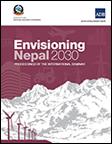 Envisioning Nepal 2030Nepal's National Planning Commission has undertaken the initiative to develop Nepal’s long term Development Strategy 2030 by engaging with international development experts, development partners, policy makers, and representatives of civil society organizations in the international seminar 'Envisioning Nepal 2030'. With the aim of serving as a guideline for Nepal’s graduation from Least Developed Country status by 2022, achieve the Sustainable Development Goals in the post-Millennium Development Goals era, and become a middle-income country by 2030, the seminar identified challenges and opportunities, and discussed how a fast-paced and sustainable inclusive growth could be achieved. In his opening remarks, Asian Development Bank Vice President Wencai Zhang, underscored the importance for Nepal to strategically position itself within a broader regional cooperation to transform itself from a landlocked into a landlinked country. Author: Nepal National Planning Commission Year: 2016 Download Tags: Nepal, Hydropower, Energy, Regional Cooperation Nepal Investment Guide 2016Nepal Investment Guide 2016 was published to provide information about investment opportunities in Nepal and the process of doing business. It identifies potential sectors for investment; relevant government agencies for foreign businesses; existing laws on labor, taxation, and imports and exports; special economic zones; and comparative benefits to investors. Author: Nepal Office of the Investment Board Year: 2016 Download Tags: Nepal, Import, Export, Investment Thirty Years of SAARC: Society, Culture and DevelopmentThis book traces economic and political issues through SAARC’s 30-year journey. The collection provides a well-researched assessment of SAARC, looks at policy directives for the future, and examines constraints to cooperation in South Asia. The publication argues that countries need to consider the benefits of economic cooperation if they wish to play an increased role in globalization. Author: Rajiv Kumar and Omita Goyal, editors Year: 2016 Download Tags: SAARC, Regional Cooperation, Development Towards a Sustainable Future: Energy Connectivity in Asia and the PacificDespite the benefits of energy connectivity, energy trade in Asia and the Pacific has remained far below its potential. This publication takes a detailed and engaging look at how smart region-wide energy connectivity could greatly improve energy supply and address the environmental impacts of energy. It maps existing energy connectivity in the region, examines ongoing initiatives, and suggests regional action plans that could lead Asia and the rest of the world to a sustainable future. Author: United Nations Economic and Social Commission for Asia and the Pacific Year: 2016 Download Tags: Asia-Pacific, Energy, Environment, Sustainability, Connectivity, UNESCAP Facilitating Trade between India and Sri LankaIndia and Sri Lanka have duty-free access to each other’s markets through the India-Sri Lanka Free Trade Agreement. Yet in recent years, traders from both countries have rarely utilized the agreement. This study aims to identify ways to improve importing and exporting under the agreement. It examines key issues and how to address them through the education of traders and Customs officials on goods eligible for concessions, facilitating testing and certification, streamlining Customs procedures, and establishing help desks. The study also offers recommendations in the areas of trade facilitation that may be incorporated in future negotiated agreements. Author: Suwendrani Jayaratne and Janaka Wijayasiri Year: 2016 Download Tags: Sri Lanka, India, Exports, Trade, Customs ADB 2015 Development Effectiveness ReviewThe Asian Development Bank (ADB) is committed to implementing reforms to reach its goals to be a bigger, faster, and stronger development institution. The 2015 Development Effectiveness Review is the annual performance report of the ADB. It tracks development progress in Asia and the Pacific and monitors ADB's effectiveness. The report also takes a look at rapid gains made by ADB developing member countries and examines the challenges that lie ahead. Planned reforms laid out in the book include those that tackle sustainability issues internally and in developing member countries. Author: Asian Development Bank Year: 2016 Download Tags: Development, Asia-Pacific, Poverty Reduction, ADB  Hydropower @ CrossroadsIndia has significant hydropower potential and can meet a demand of around 85 gigawatts, at 60% load factor. Increasing the country’s hydropower capacity could reduce generation costs and benefit both communities and industry. Hydropower also has the advantage of contributing very little to carbon emissions. However, only 41 gigawatts of hydropower capacity has been installed, accounting for only 28% of the total potential. Hydropower can play a crucial role in India’s sustainable development and energy needs given that it meets the criteria of sustainability, availability, reliability, and affordability. This publication provides recommendations that could be of use to policymakers and other interested parties. The book lays out the status of hydroelectric power in India and analyzes opportunities to increasing capacity. It provides recommendations with regard to market development, safeguard issues, financing, land acquisition, technical challenges, hydropower planning, and enabling infrastructure. Author: The Associated Chambers of Commerce of India and PricewaterhouseCoopers Year: 2016 Download Tags: Hydropower, Energy, India 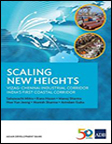 Scaling New Heights: Vizag-Chennai Industrial Corridor, India’s First Coastal CorridorThis book provides policymakers with a guide to understanding India’s economic corridor development strategy by examining its first coastal economic corridor, the East Coast Economic Corridor. It lays out the plan for its first phase, the Vizag–Chennai Industrial Corridor, which can help unify the country's domestic market, integrate its economy with Asia's global value chains, and support the 'Make in India' initiative to spur manufacturing through construction of world-class infrastructure supported by a major transport network, connecting urban clusters complemented by vibrant industrial zones, and encouraging a favorable and competitive environment for businesses to thrive, and facilitating efficient movement of goods and people. As a policy instrument and development strategy, economic corridors can help fast-track inclusive and sustainable economic growth, stimulate rapid industrialization and increase productivity, promote investments, and expand regional connectivity. Author: Sabyasachi Mitra, Rana Hasan, Manoj Sharma, Hoe Yun Jeong, Manish Sharma, and Arindam Guha Year: 2016 Download Tags: Economic Corridor, India, Trade Facilitation, Transport, Employment, Economic Corridor Development, ADB RCI 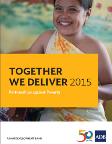 Together We Deliver 2015: Partnerships against PovertyThis book gathers 14 stories from across Asia and the Pacific that highlight successful projects demonstrating development impact, best practices, and innovation. It includes stories from Bangladesh, India, Nepal, and Sri Lanka that illustrate how the Asian Development Bank (ADB) and its partners, with their combined expertise, problem-solving abilities, and finances lift people’s living standards and solve a variety of pressing development problems. In India, Mumbai’s new Chhatrapati Shivaji International Airport is a shining example of how public–private partnerships can help solve the country's infrastructure deficit, increasing efficiency in cargo and passenger handling and saving on energy costs. In Bangladesh, partnership between ADB and nongovernment organizations is bringing health care to the urban poor. In Nepal, a Skills for Employment project is helping those caught in poverty improve their job prospects. In Sri Lanka, ADB and its development partners helped provide a fresh start through electricity, education, health services, and water sanitation.
Author: Asian Development Bank Year: 2016 Download Tags: Public Private Partnerships, Transport, Water Sanitation, Employment, Poverty Reduction ADB Annual Report 2015The Asian Development Bank's (ADB) 2015 Annual Report provides a complete picture of ADB’s performance in the reporting year. In 2015, South Asia became the fastest-growing regional economy in Asia and the Pacific, and ADB's assistance to the region approached $3.80 billion in combined loans and grants for 22 projects and $37.26 million in grants for technical assistance. Through the South Asia Subregional Economic Cooperation (SASEC) Program, ADB also continued to drive tighter integration in the region, enhancing cooperation and boosting connectivity with initiatives including helping finalize the Bangladesh-Bhutan-India-Nepal and India-Myanmar-Thailand Motor Vehicle Agreements, Bangladesh-India power grid upgradation, preparation of high-priority transport projects in Bangladesh, and analytical studies for India's East Coast Economic Corridor. Author: Asian Development Bank Year: 2016 Download Tags: ADB, SASEC, BBIN, Energy, Transport 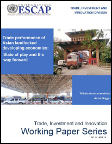 Trade Performance of Asian Landlocked Developing Economies: State of Play and the Way ForwardMany landlocked countries remain among the world's poorest nations, despite huge political, economic and technological gains over the last two centuries. Their lack of access to coast and sea ports burden them with higher trade costs, constraining their socio-economic development prospects. This paper examines the trade performance of Asian land-locked developing countries (LLDCs), including their export performance and export diversification, and attempts to identify factors affecting their performance, such as cost of trade and trade facilitation measures, which inhibit their integration into global and regional economies. Among LLDCs in South Asia, Bhutan incurs some of the highest trade costs and Nepal faces high cost in transport services. The paper finds persistent challenges to the growth of Asian LLDCs--trade barriers and trade restrictions, lack of infrastructure and poor trade facilitation performance-- and recommends reforms that could mitigate these continuing economic challenges. Author: Witada Anukoonwattaka and Aman Saggu Year: 2016 Download Tags: Landlocked Developing Countries, Exports, Trade, UNESCAP 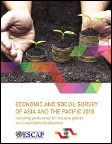 Economic and Social Survey of Asia and the Pacific 2016The 2016 edition of UNESCAP’s Economic and Social Survey of Asia and the Pacific encourages the region to rethink its development strategy. As 2016 marks the beginning of the 2030 Agenda for Sustainable development, the period is also characterized by an outlook clouded by uncertainty, with growth expected to plateau at about 5% in 2016 and 2017. Exports bound for developed economies continue to move sluggishly and domestic demand remain moderate. Thus, to bolster economic growth, the Survey recommends adopting a development model that raises domestic and regional demand. Along with active labor market policies and greater social protection, regional economic cooperation and integration--in areas covering capital markets, intraregional trade, infrastructure development, and energy and information and communications technology (ICT) connectivity--can be an important avenue for boosting domestic and regional demand. Author: United Nations Economic and Social Commission for Asia and the Pacific Year: 2016 Download Tags: Economic Growth, Regional Cooperation, ICT, Energy Asian Development Outlook 2016: Asia’s Potential GrowthThe Asian Development Outlook 2016 forecasts 5.7% growth for developing Asia in 2016 and 2017. It projects that South Asia will post the most rapid growth in developing Asia, with growth in the subregion accelerating to 7% in 2015, and will accelerate further to 7.3% in 2017 after a slight dip to 6.9% in 2016. India's growth is expected to undergo a slight slowdown to 7.4% in 2016 as exports decline and both public and private investment slows, but rebound to 7.8% in 2017 as the business environment improves, and exports and investment recover. Bangladesh will also see continued moderate growth, resulting from sustained progress toward macroeconomic and structural reform. Author: Asian Development Bank Year: 2016 Download Tags: Asia, India, Bangladesh, Economic Growth, Development, ADB 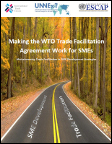 Making the WTO Trade Facilitation Agreement Work for SMEsSmall and Medium Enterprises (SMEs) comprise 95% of enterprises worldwide and provides at least two thirds of private sector employment. However, when it comes to international trade, SMEs experience limited capacity in dealing with the complex administrative and regulatory procedures associated with moving and selling goods across borders. This book fills a gap by providing a reference for articles of the World Trade Organization (WTO) Trade Facilitation Agreement (TFA) that are particularly beneficial to SMEs, and identifies examples of SME-specific programs, measures and interventions that can support the implementation of such provisions. It proposes mainstreaming relevant elements of the WTO TFA in existing SME policies and initiatives, to ensure that it contributes toward internationalization of SMEs.
Author: UNESCAP, UNNExT, and ITC Year: 2016 Download Tags: Small and Medium Enterprise, Trade Facilitation, Trade, UNESCAP, Small and Medium Enterprises, India, Nepal Information and Communication Technologies for Trade and Transport FacilitationInformation and Communication Technologies (ICT) provides efficiencies that can deliver many advantages for trade and transport facilitation (TTF) including Single Windows, automated business processes, digitalization of procedures, simpler interaction and transmission of data, and faster decision-making abilities. This paper looks at the business needs of TTF and explains the requirements of an architectural model to support TTF, with policy makers in mind. It highlights the need to integrate and modernize ICT systems and architecture so that ICT can respond to the needs of trade and transport facilitation. Author: UNESCAP and UNNExT Year: 2016 Download Tags: ICT, Trade Facilitation, Transport Facilitation, Single Window, UNESCAP Innovation Networks and the New Asian RegionalismAsian development and the strengthening of regional cooperation and integration (RCI) worldwide will experience the effects of growing structural reform issues, such as slowing productivity growth, increasing economic inequalities and systemic vulnerabilities. Hence, future RCI policies will need to complement domestic policy reform. This book examines factors that drive the regional economic integration of nations, and explains how beneficial integration can generate broad-based, equitable wealth in Asia. Author: Hans-Peter Brunner Year: 2016 Download Tags: Regional Integration, Regional Cooperation, Economic Integration 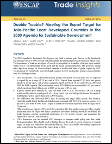 Double Trouble? Meeting the Export Target for Asia-Pacific Least Developed Countries in the 2030 Agenda for Sustainable Development (Trade Insights: Issue No. 15)This paper evaluates the prospects of least developed countries (LDCs) in Asia-Pacific in meeting the target set for LDCs to double their share of global exports by 2020, in Goal 17 of the Sustainable Development Goals (SDG). The paper notes that most Asia-Pacific LDCs have reported strong GDP growth turnout in recent years and are expected to grow by an average of 5.8% in 2016; difficulties faced by individual LDCs vary – Nepal, as an example, would need expansion at the average rate of 19% per year; LDCs can use national SDG strategies and go for longer-term goals—beyond the goals of export expansion—such as aiming to reach targets on trade cost reductions and trade facilitation. Author: Adam Heal, Miso Kim, Juliette Perche, Rajan Sudesh Ratna, and Pakkaporn Visetsilpanon Year: 2016 Download Tags: Least Developed Countries, Exports, Trade Facilitation, Trade, UNESCAP 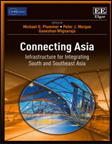 Connecting Asia: Infrastructure for Integrating South and Southeast AsiaThis book contains background papers prepared for the Asian Development Bank and the Asian Development Bank Institute joint study, 'Connecting South Asia and Southeast Asia.' It emphasizes the potential contribution to growth that greater connectivity—through better transport and energy infrastructure and improved soft infrastructure, including trade facilitation—between South Asia and Southeast Asia can foster. With benefits including greater participation in global supply chains for South Asia; lower trade costs; and increase in inter- and intraregional trade, the book underscores that, at a juncture where closer regional integration can secure sustainable and inclusive growth for economies in the two regions, specific policies should be examined and considered to enable both regions to maximize gains from greater integration. Author: Michael G. Plummer, Peter J. Morgan, Ganeshan Wignaraja, eds. Year: 2016 Download Tags: South Asia, Southeast Asia, Trade Facilitation, Transport, Energy, ADB, Economic Corridor, Bangladesh, India, Sri Lanka, ADB RCI 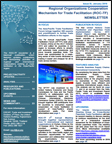 Regional Organizations Cooperation Mechanism for Trade Facilitation, Issue IX, January 2016This biannual publication features updates, publications and forthcoming activities of regional and international organizations working on trade facilitation in the Asia-Pacific region, including the Asian Development Bank (ADB), the World Customs Organization (WCO), and the United Nations Economic and Social Commission for Asia and the Pacific. It includes highlights of the Asia Pacific Trade Facilitation Forum 2015 and the Train-the-Trainer Workshops on Customs Valuation through Post Clearance Audit being jointly implemented by the WCO and ADB in the 6 SASEC member countries. This issue also features an analysis on achieving seamless supply chains through implementing comprehensive and pragmatic national trade facilitation reform programs. Author: UNESCAP Year: 2016 Download Tags: Trade Facilitation, Asia-Pacific, WCO, ADB, UNESCAP, Customs Valuation, Nepal, Bangladesh, Bhutan, India, Maldives, Sri Lanka 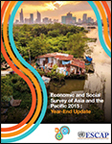 Economic and Social Survey of Asia and the Pacific 2015: Year-end UpdateThis year-end update revises economic growth in developing economies in Asia and the Pacific to 4.5% in 2015, from earlier projections of 4.9%, and updates the economic growth forecast for 2016 to 5%, from 5.2%. In most developing economies, including South and South West Asia, private consumption will lead to a slight pick-up in economic growth in 2016, amid gradual fiscal tightening and weak exports. With less robust growth compared to the years before and immediately after the global financial and economic crisis that started in 2008, the report highlights a need to tap into domestic and regional sources of demand—alternatives to dependence on external demand—including boosting investment in infrastructure, small and medium-sized enterprises, and the agricultural sector. Promotion of labor participation among the youth and the female population in South and South West Asia is also encouraged, since evidence has shown that improving their job opportunities matters for economic growth. Author: UNESCAP Year: 2016 Download Tags: Economic Growth, Gender, Infrastructure, UNESCAP Trade in Services: The Most Dynamic Segment of International TradeThe World Trade Organization (WTO) marks its 20th anniversary with a series of brochures to assist understanding of specific WTO agreements. This publication focuses on the WTO General Agreement on Trade in Services (GATS), which provides the legal ground rules for international trade in services, allowing WTO members the flexibility to open their markets to foreign competition to the extent of their choosing. GATS entered into force in 1995 and remains the only set of multilateral rules covering international trade in services. This brochures provides an overview of the different modes by which services are traded, commitments taken by WTO members, and developments enhancing GATS commitments and information on trade in services. Author: World Trade Organization Year: 2015 Download Tags: Services, Trade Facilitation, Economic Growth, WTO Technical Barriers to Trade: Reducing Trade Friction from Standards and RegulationsThe World Trade Organization (WTO) marks its 20th anniversary with a series of brochures to assist understanding of specific WTO agreements. This publication provides an overview of the WTO Agreement on Technical Barriers to Trade (TBT), which aims to ensure that technical regulations, standards, and conformity assessment procedures are non-discriminatory and do not create unnecessary obstacles to trade. It reviews how the TBT Committee, a unique multilateral forum for the discussion of standards and regulations affecting trade comprising WTO members, have created a predictable trading environment by enacting transparency provisions, and facilitated trade by encouraging WTO members to base their measures on international standards. Author: World Trade Organization Year: 2015 Download Tags: Technical Barriers to Trade, Trade, Trade Facilitation, WTO Sri Lanka Energy Sector Development Plan For A Knowledge-Based Economy, 2015-2025Sri Lanka has set an set an ambitious goal of 100% energy self-sufficiency by 2030. With annual total electricity demand estimated at 10,500 gigawatt hours—increasing annually by around 4-6%—and challenges including high cost of electricity, 100% dependence on imported oil for the transport sector, and need for large investments in infrastructure, this book unveils how the energy sector plans to achieve energy security in the next 10 years—envisioning a future where clean, reliable, affordable energy is made available 24/7 to the whole country. This sector development plan for a knowledge-based economy aims to provide a balance between the country's energy demand and supply, and its long-term perspective anchored on continuous economic growth, through renewable and indigenous sources of energy. Author: Sri Lanka Ministry of Power and Energy Year: 2015 Download Tags: Energy, Sri Lanka, Renewables 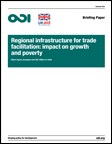 Regional Infrastructure for Trade Facilitation: Impact on Growth and Poverty Reduction - Policy SummaryThis research aims to provide evidence on the effects of regional infrastructure and associated trade cost reduction on growth and poverty reduction of economic actors, including households and firms, around the border. Data shows that investment in regional integration for trade facilitation (RITF) promotes economic activity, supports activity of informal traders, and facilitates integration into global value chains and international production networks. The report highlights that new hard infrastructure benefits economic actors more when complementary regulations that allow for efficient trade logistic services are also put in place. It recommends that policymakers account for the impact of RITF on reducing constraints to connectivity in their evaluations and policy decisions. Author: Marie-Agnes Jouanjean and Dirk Willem te Velde Year: 2015 Download Tags: Trade Facilitation, Global Value Chains, Poverty Reduction World Energy Outlook 2015Global energy is undergoing major changes. Renewables are increasingly contributing to the the world’s power generation capacity, and coverage of mandatory energy efficiency regulation worldwide has expanded to more than a quarter of global consumption. This World Energy Outlook 2015 provides insights to policy-makers, industry and other stakeholders on the state of the energy sector today, discussing which changes are transient or cyclical, the risks and opportunities that may lie ahead, and actions that can put the energy system on a more secure and sustainable footing. It also includes a special chapter discussing India’s energy outlook, and how development in India's energy sector over the coming decades will impact the country and the global energy system as a whole. Author: International Energy Agency Year: 2015 Download Tags: Energy, India, Renewables Sri Lanka: Building on SuccessOver the years, the Asian Development Bank (ADB) and its many partners in Sri Lanka have worked together to realize the goal of changing the country’s status from low to middle income. With Sri Lanka moving toward becoming an upper middle-income country in a few years, challenges lie on the road ahead. This publication provides an overview of recent ADB support toward Sri Lanka's development in diverse areas including transport, energy and education, and discusses how the Government of Sri Lanka and ADB will transition their partnership to push the country to the next level of prosperity. Author: Asian Development Bank Year: 2015 Download Tags: Sri Lanka, Transport, Ports, Development, Economic Growth Disentangling Transit Costs and Time in South AsiaLandlocked least developed countries are often hugely disadvantaged from a lack of effective transit options, which raise transportation costs and decrease their effective participation in international trade. This study examines trade barriers that impede the trade flow of Bhutan and Nepal through India's gateway ports of Haldia and Kolkata, under the overarching research theme of the impact of regional infrastructure for trade facilitation on growth and poverty reduction. It analyzes the impact of transit regulations and agreements on the cost of services required to transit goods between the ports and Bhutan or Nepal, to identify how the two landlocked countries are affected by the cost of transit services, which trade costs vary most significantly, and how firms are affected by the cost of transit services. Author: Prabir De, editor Year: 2015 Download Tags: Trade Facilitation, Transport Facilitation, Bhutan, Nepal Policy Brief: A Safe Public Transportation Environment for Women and GirlsEnsuring safe public transport for women enhances inclusive growth by encouraging their participation in the public sphere, including the workforce. A range of interventions dealing with the issue of sexual harassment—which negatively impacts women's movement in public spaces, affecting their productivity—in public transportation have been adopted by governments and civil society around the world, including media campaigns, targeted mobile applications, and women-only public vehicles. This report draws on rapid assessments of sexual harassment in public transportation conducted in three countries in Asia, with recommended actions to prevent and address sexual harassment in public transportation and its related spaces, such as train platforms and bus stops. Author: Asian Development Bank Year: 2015 Download Tags: Gender, Inclusive Growth, Transport 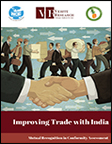 Improving Trade with India: Mutual Recognition in Conformity AssessmentThis study examines the current status of Sri Lankan exports to India, focusing on non-tariff barriers (NTBs) existing between India and Sri Lanka, including conformity assessment procedures applied in the two countries. Providing a comprehensive analysis of issues related to standards and regulations faced by processed food exporters from Sri Lanka to India, the study highlights how India's non-recognition of testing and certification conducted outside its borders forms a significant barrier, one that is critical to the performance of Sri Lanka's exports to India. It proposes that the most workable solution is to implement a Mutual Recognition Agreement, which will allow recognized, competent and accredited conforming assessment bodies from India and Sri Lanka to accept certificates of conformity, letting Sri Lankan exporters take advantage of duty concessions offered by the India-Sri Lanka Free Trade Agreement. Author: Verité Research Year: 2015 Download Tags: India, Sri Lanka, Trade, Harmonisation  Asian Economic Integration Report 2015: How Can Special Economic Zones Catalyze Economic Development?The 2015 Asian Economic Integration Report reviews regional economic cooperation and integration in Asia, providing updates on recent developments affecting trade policy, including the conclusion of Trans-Pacific Partnership, relatively large number of proposed FTAs--with India among the major proponents, and progress of trade facilitation in Asia through the World Trade Organization's Trade Facilitation Agreement. Trade facilitation in developing Asia has significantly advanced over the last several decades, with a total of 48,000 kilometers of regional transport corridors along major supply chains improved. From 1992 to 2014, developing Asia together with ADB and its partners have mobilized $38.4 billion for 186 regional transport and trade facilitation investment projects under three subregional programs—including the South Asia Subregional Economic Cooperation (SASEC) program. This also issue includes a special chapter highlighting how special economic zones can catalyze economic development, with the right business environment and policies in place. Author: Asian Development Bank Year: 2015 Download Tags: Special Economic Zones, Trade Facilitation, Transport 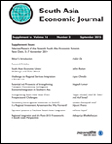 South Asia Economic Journal: Supplement Issue: Papers of the Seventh South Asia Economic SummitThis special issue of the South Asia Economic Journal contains papers presented at the 7th South Asia Economic Summit. With South Asia moving toward a South Asia Economic Union (SAEU), several major challenges remain, including reduction in the sensitive list, removal of Non-Tariff Barriers, effective and faster implementation of the South Asian Agreement on Trade in Services, effective regional investment cooperation, promotion of trade facilitation measures, promotion of regional value chains, cross-border energy cooperation. The articles in this volume tackle these critical issues to develop a way forward and generate ideas on policy priorities. A paper by Mr. Nagesh Kumar, UNESCAP-SSWA, on 'Potential and Prospects of Strengthening Transport Connectivity for Regional Economic Integration in Southern Asia' also discusses how two planned extended transport corridors can only facilitate trade and draw South Asia closer to its potential to become a hub of Asia–Europe trade. Author: Prabir De, editor Year: 2015 Download Tags: SAARC, South Asian Economic Union, Trade Facilitation, Transport 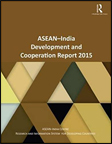 ASEAN-India Development and Cooperation Report 2015Re-engagement between India and ASEAN through increased cooperation across a range of issues, including trade and connectivity, is set to boost prosperity, competitiveness, growth and integration. With negotiations underway to establish a comprehensive free trade area through the Regional Comprehensive Economic Partnership, economic integration between India and Southeast and East Asia is set to scale new heights – further highlighting need for economic corridors with adequate cross-border infrastructure facilities that could facilitate increased production and services networks between ASEAN and Indian economies. This Report brings together experts and researchers who weigh in on ASEAN-India relations, analyzing the impact and implications of integration; assessing policy priorities, effectiveness, implementation imperatives and challenges; and discussing themes central to the economic sustainability of the region. Author: ASEAN–India Centre, Research and Information System for Developing Countries Year: 2015 Download Tags: ASEAN, India, Trade, Trade Facilitation Asian Development Outlook 2015 Supplement: Growth Holds Its Own in Developing AsiaThis Supplement maintains growth forecast for developing Asia at 5.8% in 2015 and 6.0% in 2016. In South Asia, economic outlook remains optimistic, with the region on track to meet Update projections of 6.9% in 2015 and 7.3% in 2016. India's economic expansion balances a slowdown in Bhutan—owing to weaker sales of hydropower—and the Maldives in 2015, and in Nepal in 2016—due to unfavorable weather and unforeseen delays in earthquake-related reconstruction. Growth projections for Bangladesh and Sri Lanka remain in line with those in the Asian Development Outlook Update. Author: Asian Development Bank Year: 2015 Download Tags: ADB, South Asia, Bangladesh, Bhutan, India, Maldives, Nepal, Sri Lanka 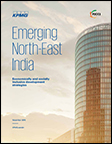 Emerging North-East India: Economically and Socially Inclusive Development StrategiesThis report highlights opportunities that can be explored in India's North East region, including tourism, energy, and infrastructure, to enable the North East to develop economically, while contributing to India's development as a whole. It takes stock of recent initiatives, including the 'Look East' Policy and the Bangladesh-Bhutan-India-Nepal (BBIN) subregional grouping, and identifies areas for improvement to propel inclusive growth. Harnessing the region's full potential would require upgrading the region's infrastructure. Significant investments are needed, since lack of connectivity and inadequate infrastructure present developmental bottlenecks, contributing to the slow pace of growth in the North East. The report presents policy recommendations and suggested actions, and a forecast for India for 2021-2022. Author: KPMG India and FICCI Year: 2015 Download Tags: India, BBIN, Connectivity, Transport, Trade Facilitation CPD Working Paper 110 – Trade and Transport Facilitation in Bangladesh: An Audit of the State of PlayThis publication provides a detailed picture of the status of specific measures for trade and transport facilitation in Bangladesh. It identifies measures already adopted, including strengthening of trade-related institutions, improvements in Customs processes and procedures, and reduction of non-trade barriers, highlighting areas for improvement and identifying existing gaps, to allow for proposals to meet these gaps. The audit undertaken aims to support policy-makers in Bangladesh in mobilizing the financial resources required to build a modern and efficient trade and transport facilitation system. Author: Mustafizur Rahman, Khaleda Akhter and Naimul Gani Saif Year: 2015 Download Tags: Trade Facilitation, Bangladesh, Customs Reducing Non-Tariff Barriers to Food Trade Between India and South Asia: Eliminating Phyto-Sanitary and Sanitary IssuesThis brief focuses on the impact of phyto-sanitary and sanitary measures as a significant non-tariff barrier to trade at India's overland trading posts and ports, from which it imports perishable goods from its neighbors in the SAARC region. Due to inadequate facilities to handle large, time-sensitive, and perishable consignments, India and its neighboring trade partners have experienced severe constraints on bilateral trade, which results to variability in time and cost of freight movement, and eventually affects price stability and availability of India's food stocks. Author: Hemant Shivakumar and Shiva C. Sharma Year: 2015 Download Tags: Sanitary and Phytosanitary Measures, India, SAARC, Trade, Non-Tariff Measures, Bangladesh Reforming Sri Lanka’s Trade and Investment Policies for Export GrowthThis Policy Insight examines four key areas of reform to increase Sri Lanka's competitiveness and promote external trade – trade tariff structure, trade and transport facilitation, promotion of foreign direct investment, and existing trade agreements with neighbors in South and Southeast Asia. It calls for a more transparent, simplified and rationalized tariff regime and adoption of measures to further strengthen trade and transport facilitation, including improvement of publication and administration of trade-related policies; increased usage of ICT for trade; and upgrading of trade-related infrastructure. Furthermore, it recommends pursuing beneficial trade agreements with neighbors, but with a more strategic approach in Sri Lanka's negotiations of trade agreements. Author: Institute of Policy Studies Sri Lanka Year: 2015 Download Tags: Sri Lanka, Trade, FDI 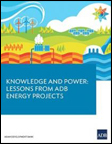 Knowledge and Power: Lessons from ADB Energy ProjectsThis publication highlights good practices and lessons learned from Asian Development Bank projects in energy, which comprised 26.5% of ADB's total lending commitments from 2008 to 2014. It discusses how the region's energy sources are utilized, providing updates on recent developments and challenges, highlighting the need for sustainable energy initiatives. Featured projects include the Green Power Development Project in Bhutan, which developed clean energy for regional use and promoted cross-border power trade. As the first infrastructure-focused public-private partnership in Bhutan, it also illustrated how projects can benefit with the active participation of the private sector, foreign parties, and commercial and public financial institutions. Also featured is the Bangladesh-India Electrical Grid Interconnection Project, which reduced Bangladesh's energy deficiency by enabling the country to affordably import 500 megawatts of electricity from India. This electrical link laid the groundwork for a regional energy market, an important step toward achieving a functioning regional electricity network in South Asia. Author: Asian Development Bank Year: 2015 Download Tags: Energy, Bangladesh, Bhutan, India, Regional Cooperation Doing Business 2016The World Bank's Doing Business 2016: Measuring Regulatory Quality and Efficiency reports that South Asia ranked second among regions, after Europe and Central Asia, in the largest share of economies implementing at least one reform to make doing business easier in the past year. 6 out of 8 economies in South Asia implemented a total of 9 reforms, including Bhutan, India - following the Government of India's ambitious program to increase ease of doing business launched in 2014 - and Sri Lanka. However, South Asia still lags behind in use of online systems in regulatory processes. The highest ranked economy in the region is Bhutan, with a global ranking of 71. Author: The World Bank Year: 2015 Download Tags: Business Efficiency, ICT, Bhutan, WB World Trade Report 2015The World Trade Report 2015 is the first major study to comprehensively examine the benefits and challenges of implementing the World Trade Organization's Trade Facilitation Agreement (TFA) since its adoption in 2014. It discusses the importance of implementation of the TFA, its economic impact, and the steps being taken by the WTO to enable countries to maximize its benefits. This report presents further evidence that speedy and extensive implementation of the TFA will lead to bigger gains, particularly for developing countries and least developed countries. Author: World Trade Organization Year: 2015 Download Tags: Trade, LDC, Trade Facilitation 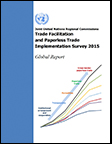 Joint UNRCs Trade Facilitation and Paperless Trade Implementation Survey 2015: Global ReportThis Report features results of the first UNRCs Joint Survey on Trade Facilitation and Paperless Trade Implementation, providing an overview of the current state of trade facilitation implementation in 119 economies across 8 regions worldwide. Though this Joint Survey finds that global average implementation rate of trade facilitation measures considered in the report stands at 52.9%, South Asia ranks below 40%. In the authorized operators and establishment and publication of average release times - categorized under the formalities measures - South Asia ranks below 10%. However, the region fares better in the institutional and cooperation measures, in particular with the recommendation to establish National Trade Facilitation Committees, with this measure most implemented in South Asia. The Report ranks India as the region's top performer in implementation of trade facilitation measures. Author: United Nations Regional Commission Year: 2015 Download Tags: Trade Facilitation, South Asia, Customs 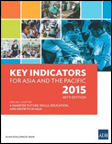 Key Indicators for Asia and the Pacific 2015The Key Indicators for Asia and the Pacific 2015 includes up-to-date available indicators for the 48 regional members of the Asian Development Bank, including numbers on energy, trade, transport, and tourism. Key trends noted in 2014 include the rising volume of intraregional exports globally, due to robust economic growth and expanding regional networks. For Asia and Pacific economies, primary source for merchandise imports was the region itself with a 49.7% share. In energy consumption, Asia and the Pacific now consumes more than 40% of the world's electricity, with the People's Republic of China and India accounting for nearly 70% of the region's output. This 46th edition of Key Indicators also includes a special chapter on skills, education, and growth in Asia, and emphasizes the need to focus on quality and ensure that the workforce has the skills to take the region through economic transition to prosperity. Author: Asian Development Bank Year: 2015 Download Tags: Economic Growth, Energy, Trade, Transport, India A Framework of Trade Policy for Bhutan: Compatible with the Gross National HappinessThis paper examines the compatibility between Bhutan's gross national happiness (GNH) index and trade policy, and attempts to contextualize Bhutan's trade policy issues - inclusive growth, trade facilitation, incidence of tariffs, and World Trade Organization accession. It explores trade and industry policy that is compatible with GNH guidelines, which aim to measure and improve people's holistic well-being: although it also includes factors that are seemingly unfavorable to an active trade policy. The report recommends benchmarking successful development strategies in other countries and creating an organization to pursue a more active trade policy to accomplish the urgent task of raising general living standards. Author: Inkyo Cheong, Taeho Bark, and Hoe Yun Jeong Year: 2015 Download Tags: Bhutan, WTO, Trade Policy, ADB Regional Transport Infrastructure: Mapping Projects to Bridge South Asia and Southeast AsiaThis Asian Development Bank (ADB) brief highlights the critical role of transport infrastructure in bridging South Asia and Southeast Asia. It maps details of economic corridors and highways, railroads, and seaports, and identifies priority transport investment projects needed to link the two subregions. While an investment of $986 million in road transport and $2.3 billion in sea ports may be needed to create proper connectivity between the two regions, the study's conservative estimate of potential benefit ranges from $89 billion to $358 billion over the next decade - demonstrating how investment in infrastructure can pay huge dividends in the medium- and longterm. Author: Peter Morgan, Mike Plummer, and Ganeshan Wignaraja Year: 2015 Download Tags: Transport, South Asia, Southeast Asia, ADB RCI Asian Development Outlook 2015 Update: Enabling Women, Energizing AsiaThis Update revises growth forecast for the Asia and the Pacific region down to 5.8% in 2015 and 6.0% in 2016, with delayed recovery in major industrial economies and slowing investment prospects in India and the People's Republic of China. Growth acceleration in South Asia has also been more modest than forecast - now projected at 6.9% in 2015, below the 7.2% March forecast, but up from 6.7% in 2014, and forecast to rise further to 7.3% in 2016. The need to energize growth in the region calls for avenues to unlock untapped resources, including narrowing gender gaps in the labor market. In Bangladesh, the increase in women's participation in the workforce has not only enhanced their bargaining power at home, but improved health and education options for the family. Author: Asian Development Bank Year: 2015 Download Tags: Asia-Pacific, Economic Growth, ADB Cross-Border Power Trading in South Asia: A Techno Economic RationaleSouth Asian countries have a wealth of diverse energy sources. These renewable resources, along with the varying electricity demand patterns among countries in South Asia, open up opportunities to share resources through electricity trading, which can be enabled by strengthening the electricity transmission system. This study examines the cost and benefit of six cross-border electricity transmission interconnections, and measures the economic and reliability benefits for participating countries in South Asia. Author: Priyantha Wijayatunga, D. Chattopadhyay and P. N. Fernando Year: 2015 Download Tags: Energy, SAARC, Regional Trade, ADB, ADB RCI Lessons for South Asia from the Industrial Cluster Development Experience of the Republic of KoreaGrowth of manufacturing is crucial for economic growth and poverty reduction. This report highlights the industrial cluster development policy of the Republic of Korea, including its success factors in terms of policy implementation, and the promotion of industrial cluster development, drawing lessons that could enhance industrial growth in South Asia. It discusses how the government encouraged increase in exports through relevant policies and adapted to more technology- and knowledge-intensive industries which required innovation-driven policies. The experience outlined in the report could benefit large-scale industrial promotion in South Asia, such as the Economic Corridor Program in India. Author: Jong-il Kim Year: 2015 Download Tags: South Asia, Industrialization, Economic Corridor, Trade, ADB, India, Bangladesh, Sri Lanka, ADB RCI Bangladesh-Bhutan-India-Nepal Motor Vehicles Agreement: Unlocking the Potential for Vibrant Regional Road Freight ConnectivityThe Bangladesh-Bhutan-India-Nepal Motor Vehicles Agreement (BBIN MVA) is expected to reduce trade transaction costs and be an effective tool to realize trade and investment potential in the subregion by generating new economic opportunities, particularly in the border areas. While it has put in place a good framework for facilitating transit and transport within BBIN, gaps remain in terms of interpretation and application of various procedures, and need for further policy harmonization among the contracting parties. This discussion paper analyzes operation issues and proposes solutions for cross-border movement of vehicles and Customs procedures. Author: Pritam Banerjee Year: 2015 Download Tags: BBIN, Trade Facilitation, Transport 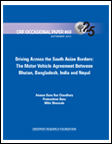 Driving Across the South Asian Borders: the Motor Vehicle Agreement between Bhutan, Bangladesh, India, and NepalThis paper discusses the benefits of strengthening physical connectivity in the Bangladesh-Bhutan-India-Nepal (BBIN) subregion through a Motor Vehicle Agreement (MVA). Through a framework that envisions transforming transport corridors into economic corridors and with its pipeline of 30 priority transport connectivity projects estimated at $8 billion, the MVA aims to increase intraregional trade in South Asia by almost 60%. This publication provides a concise background on the BBIN MVA, examining the circumstances leading to its signing, the role of the Asian Development Bank (ADB) and the ADB-supported SASEC Program initiative to enhance interconnectivity, challenges that require careful consideration, and its wider implications for the South Asian region. Author: Anasua Basu Ray Chaudhury, Pratnashree Basu, and Mihir Bhonsale Year: 2015 Download Tags: Transport, Trade Facilitation, BBIN World Trade Organization Annual Report 2015The World Trade Organization (WTO) Annual Report 2015 provides an overview of WTO activities in 2014 and early 2015. It presents a timeline of two decades of the WTO -- from its origins succeeding the General Agreement on Tariffs and Trade to its current role in the multilateral trading system. It presents a chapter on how WTO helps developing countries build trade capacity and allows them to implement trade agreements. WTO training courses are organized for officials from developing countries each year. Author: World Trade Organization Year: 2015 Download Tags: Trade, Trade Policy, WTO, Tariffs, Energy, Bangladesh, India, Nepal, Sri Lanka, Trade Facilitation, Transport, Asia, Agriculture 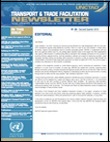 UNCTAD Transport and Trade Facilitation Newsletter No. 66 – Second Quarter 2015The Transport and Trade Facilitation Newsletter highlights trade facilitation support across countries and shares innovations from Cote d’Ivoire and Greece, including the new UNCTAD Technical Note on World Trade Organization (WTO) Trade Facilitation Agreement (TFA) ratification. It also features the meeting of the Global Facilitation Partnership for Transportation and Trade -- an event that brings together the private sector, WTO Member States and international organizations -- in a discussion to support TFA implementation. The Newsletter further shows United Nations Regional Commissions Global Survey on Trade Facilitation and Paperless Trade -- a response to the lack of comprehensive cross-country data and a guide to better understand and monitor trade facilitation implementation and paperless trade measures. Author: United Nations Conference on Trade and Development Year: 2015 Download Tags: Transport, Trade Facilitation, WTO, UNCTAD Building Firm-level Trade Competitiveness in Emerging EconomiesThis paper -- produced under the E15 Initiative and implemented jointly by the International Centre for Trade and Sustainable Development and World Economic Forum -- seeks to understand the framework of competitiveness and its implications for international trade. It discusses issues related to firm-level competitiveness, including the determinants; quality tools and models to address it, especially in developing economies and small and medium enterprises (SMEs); importance of diffusion and learning with a focus on SME growth; and specific policy interventions to improve firm-level competitiveness. Author: Sharmila Kantha Year: 2015 Download Tags: Firms, SME, Trade, Development, Sustainability, India, South Asia, Energy 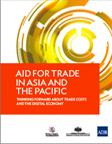 Aid for Trade in Asia and the Pacific: Thinking Forward About Trade Costs and the Digital EconomyAid for Trade (AfT) flows have increased each year since 2006 in Asia and the Pacific. While regional aggregate trade costs continue to fall, many subregions still struggle with trade costs that are substantially higher than the global average. This report highlights and explores how AfT contributed to these emerging trends in Asia and the Pacific and how to continue to address trade costs moving forward. Among the subregions, the Pacific (along with South Asia) has made the greatest improvements in the Logistics Performance Index from 2007-2014. Recent exporter surveys reveal a movement toward niche products and leveraging of e-commerce as a means to overcome cost and distance. Emerging digital technologies such as e-commerce further offers a new set of opportunities for economies in the region to grow through trade. Author: Asian Development Bank Year: 2015 Download Tags: Aid for Trade, Asia-Pacific, ICT, South Asia, Trade, Bangladesh, Bhutan, India, Sri Lanka, Agriculture, Energy, Transport  Maldives: Overcoming the Challenges of a Small Island State – Country Diagnostic StudyThe Maldives has propelled itself to middle-income status despite the geographic constraints and challenges of a small-island state. It has one of the lowest poverty rates in South Asia, although wide regional disparities in poverty rates and high-income inequality continue to be a concern. Growth – primarily driven by the tourism sector – has also been vulnerable to external shocks. As the Maldives moves toward a more sustainable and inclusive growth strategy, transport infrastructure is critical to help address the country’s connectivity issue and reduce the cost of doing business. This report identifies the critical constraints to inclusive growth in the Maldives and provides policy recommendations to sustain economic growth and hasten poverty reduction. Author: Asian Development Bank Year: 2015 Download Tags: Maldives, Small Island Developing States, Transport, Connectivity, Policy, Poverty Reduction, South Asia, Tourism SAARC: The Way AheadThis Observer Research Foundation Issue Brief examines the South Asia Association for Regional Cooperation as a regional grouping that is almost three decades old. It discusses trade arrangements such as the South Asian Preferential Trading Arrangement aimed towards a higher level of intraregional trade liberalization and economic cooperation, including the South Asia Free Trade Area for reduction of Customs duties on traded goods. The paper further studies areas of energy, connectivity, foreign direct investment, trade in services and subregional cooperation. The South Asia Subregional Economic Cooperation Program is offered as one of the steps in the direction of having a viable option for subregional cooperation. Author: Jayshree Sengupta Year: 2015 Download Tags: Regional Cooperation, SAARC, Trade, Connectivity, Energy, FDI, Investment, Free Trade Agreements, Services, South Asia UNRCs Trade Facilitation and Paperless Trade Implementation Survey 2015: Asia and the Pacific Report This report presents data on trade facilitation and paperless trade implementation from 44 economies across the Asia-Pacific region, covering 5 different subregions. It lays out key findings on implementation levels of general trade facilitation measures and ICT-based trade facilitation measures across the region, and provides empirical evidence for advancing trade facilitation. Findings suggest that there is still significant room for progress. In South Asia, regional average trade implementation comes a little above 40%. The report also noted that cross-border paperless trade facilitation is the least implemented of all groups of measures. Author: United Nations Economic and Social Commission for Asia and the Pacific Year: 2015 Download Tags: Trade Facilitation, Asia-Pacific, ICT 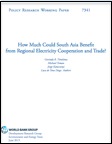 How Much Could South Asia Benefit from Regional Electricity Cooperation and Trade?This paper assesses the potential economic benefits of cross-border electricity cooperation and trade in South Asia from 2015 to 2040. It focuses on the possibilities of unlimited power flow across borders in response to regional demands and investment in generation and transmission to cost-effectively meet those demands. The study quantifies the potential economic benefits that South Asia could reap if the countries engage with full regional electricity trade and cooperation. Among South Asia Subregional Economic Cooperation countries, Bhutan and Nepal have the potential to cost-effectively supply electricity from hydroelectric resources in excess of their own demands; Bangladesh and India are likely to become more dependent on higher-cost coal as well as natural gas to generate electricity. The countries of the South Asia region also have non-coincident demand peaks across the year, implying gains from trade. Author: The World Bank Year: 2015 Download Tags: Energy, South Asia, Trade, Bangladesh, India, SASEC 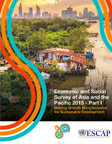 Economic and Social Survey of Asia and the Pacific 2015The 2015 edition of ESCAP’s Economic and Social Survey of Asia and the Pacific highlights inclusive growth as a prerequisite for meeting the Millennium Development Goals and critical for effective implementation of the sustainable development agenda post-2015. It also contains proposals to improve the pattern of public expenditures and increase access to financial services. Economic growth in South and South-West Asia increased in 2014, led by stronger macroeconomic performance in India, but remained far below its pre-crisis pace. While the near-term outlook is optimistic and conditional on continued domestic reform in large economies, limited intraregional trade within the sub-region could limit positive spillovers into relatively smaller economies. A key reform area is broadening the tax base and stemming of tax evasion to lower public borrowing and help address severe power shortages. Author: United Nations Economic and Social Commission for Asia and the Pacific Year: 2015 Download Tags: Asia-Pacific, Economic Growth, South Asia Asian Development Outlook 2015 Supplement: Growth Prospects Soften for Developing AsiaThis Supplement revises growth projections for developing Asia published in the Asian Development Outlook (ADO) 2015 in March, as slower-than-expected recovery in the United States and moderating growth in the People’s Republic of China weigh on the region’s prospects. Economic outlook for South Asia is stronger growth in the subregion as a whole in 2015 than forecast in ADO 2015, now bumped up slightly to 7.3% from 7.2%. The projection for 2016 remains the same at 7.6%. By individual countries, stronger growth is estimated for Bangladesh in FY2015, but slower growth is projected for the Maldives and earthquake-struck Nepal. Author: Asian Development Bank Year: 2015 Download Tags: Development, Economic Growth, South Asia Aid for Trade at a Glance 2015: Reducing Trade Costs for Inclusive, Sustainable Growth High trade costs inhibit trade integration in various developing countries, slowing growth and development prospects. This joint OECD/WTO publication emphasizes the Aid-for-Trade Initiative as an example of how to reduce trade costs and contribute to the emerging post-2015 development agenda. It calls for redoubling of efforts to tackle the issue of trade costs that continue to marginalize many of the world’s poorest and most fragile economies. The chapters highlight main achievements and challenges of the Aid-for-Trade Initiative. It further suggests a focus on reducing trade costs for an integrated approach in achieving inclusive and sustainable development outcomes. Author: World Trade Organization and Organisation for Economic Co-operation and Development Year: 2015 Download Tags: Aid for Trade, Trade Policy, WTO A Critical Disconnect: The Role of SAARC in Building the DRM Capacities of South Asian Countries This report evaluates the disaster risk management (DRM) efforts of the South Asian Association for Regional Cooperation (SAARC) in the last ten years as a regional organization, and assesses its impact in supporting the DRM national capacities of member states. Published after the April 2015 earthquake in Nepal, the publication underscores the critical role SAARC plays in building a common regional vision for DRM. It recommends focusing on priority activities that can assist member states in implementation of policies at a sub-national level; opening itself to support by external donors; and enhancing its training program through regional training of trainers by the SAARC Environment and Disaster Management Centre. Author: Stacey White Year: 2015 Download Tags: SAARC, Disaster Risk, South Asia WTO Dispute Settlement and Industrial PolicyThis paper explores the World Trade Organization's (WTO) dispute settlement mechanism in relation to the space it provides for Member countries’ industrial policies. It provides general conceptual reflections covering the role of WTO panels and the Appellate Body and the nature and categorization of WTO legal provisions applicable to trade in goods; and discusses how dispute settlement in WTO can affect or expand the policy space available to WTO Members in adopting industrial policy measures. This paper presents several examples that demonstrate the potential impact of WTO adjudicatory bodies on the policy space of WTO Members to implement and pursue industrial policy measures. Author: Jan Bohanes Year: 2015 Download Tags: WTO, Trade Facilitation, Policy Aid for Trade in Asia and the Pacific 2015This Asian Development Bank report explores the potential of the digital economy to improve the inclusiveness of Aid for Trade (AfT). It uses the review of AfT as a springboard to explore new ways of thinking and how to address issues such as high trade costs in some regions. In particular, it considers how to build on information and communications technology and infrastructure connectivity from established AfT spending. The report also highlights the experience of exporters to illustrate the unique challenges and opportunities for trade-driven growth in a region where high trade costs are structural. Author: Alisa Di Caprio and Kati Suominen Year: 2015 Download Tags: ICT, Infrastructure, Trade, ADB, Asia-Pacific, Exports, Economic Growth, Trade Facilitation Clean Energy and Access to Infrastructure: Implications for the Global Trade SystemThis paper focuses on how international trade rules could better accommodate renewable energy trade through fixed infrastructure. It explains the World Trade Organization disciplines relevant to trade in clean energy via fixed infrastructure, in particular General Agreement on Trade in Services disciplines on energy services and General Agreement on Tariffs and Trade transit rules. Finally, it suggests policy options to adopt existing rules to the challenges of integrating clean energy transported via fixed infrastructure. Author: International Centre for Trade and Sustainable Development Year: 2015 Download Tags: Energy, Trade, WTO, India, South Asia, Sustainability, Tariff Cross-Border Electricity Cooperation in South AsiaStrengthening cross-border electricity cooperation in South Asia can be part of the solution for providing adequate and reliable electricity. This World Bank Policy Research Working Paper reviews the status of cross-border electricity cooperation in South Asia, identifies key regional-level barriers to expand cross-border cooperation and trade in South Asia, and discusses the extent to which current domestic sector policies impede greater cross-border electricity cooperation. Finally, the findings offer policy recommendations on increased cross-border trade and cooperation. Author: Anoop Singh, Tooraj Jamasb, Rabindra Nepal, and Michael Toman Year: 2015 Download Tags: Energy, Regional Cooperation, Regional Trade, Bangladesh, Bhutan, India, Maldives, Nepal, South Asia, Sri Lanka, Trade, Trade Policy, WB Trade in Value Added: Concepts, Estimation and AnalysisThis Asia-Pacific Research and Training Network on Trade working paper aims to explain the concept of Trade in Value Added (TiVA), which could properly measure exports of an economy. It discusses how TiVA is measured and how it can help in a more comprehensive understanding of trade flows. It also explains global value chains and reviews current initiatives in constructing regional and international input-output tables, and estimates of TiVA involving Asia-Pacific economies. Author: Marko Javorsek and Ignacio Camacho Year: 2015 Download Tags: Asia-Pacific, Global Value Chains, Trade 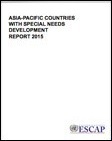 Asia-Pacific Countries with Special Needs Development Report 2015In the Asia-Pacific region, 36 out of the 58 economies are considered countries with special needs (CSN), which include least developed countries (LDC), landlocked developing countries, and small island developing States. This report highlights important areas that should be addressed as key priorities by CSNs such as economic diversification, external trade, South-South cooperation, and official development assistance including foreign direct investment. Bhutan and Nepal met the criteria for graduation from LDC status as of 2013. Other countries such as Bangladesh have a good chance of meeting the graduation criteria by 2018. Among the Small island developing States, Maldives is considered a success story in broadband internet connectivity. The results of this research show that Asia-Pacific CSNs must choose their paths to diversification carefully, depending on country circumstances. Author: United Nations Economic and Social Commission for Asia and the Pacific Year: 2015 Download Tags: Asia-Pacific, Least Developed Countries, Small Island Developing States, Bangladesh, Bhutan, Energy, FDI, Investment, Maldives, Nepal, Trade, Transport, UNESCAP Economic and Social Survey for Asia and the Pacific: Part 2 – Balancing the Three Dimensions of Sustainable Development: From Integration to Implementation This theme study outlines a conceptual framework, a set of strategies and policy options, and offers perspectives on institutional frameworks for integrating the three dimensions of sustainable development – economic growth, social progress and environmental protection. Regional cooperation is critical in maximizing opportunities for building synergies between the three dimensions. Initiatives at the regional level should consider establishing a regional road map, supporting regional economic integration initiatives, and strengthening regional platforms, including the United Nations and the multilateral system. Author: United Nations Economic and Social Commission for Asia and the Pacific Year: 2015 Download Tags: Asia-Pacific, Economic Integration, Regional Cooperation, Economic Growth, Environment, Sustainability, UNESCAP Outward FDI by Indian Manufacturing MNEs: Impacts and Implications This Asia-Pacific Research and Training Network on Trade Working Paper investigates the home country effects of outward foreign direct investment (OFDI) on domestic activity of Indian multinational enterprises (MNEs). The empirical evidence suggests that OFDI by Indian MNEs has a positive impact on export intensity and research and development. In order to derive desired complementary benefits of OFDI by manufacturing firms, policies may be directed to enhance the country’s international supply chain connectivity for greater participation in global value chain and production network. Author: Khanindra Ch. Das Year: 2015 Download Tags: India, FDI, Global Value Chains, Trade, Export, Development, Manufacturing, UNESCAP Trade and Non-Tariff Measures: Impacts in the Asia-Pacific Region This study brings together existing evidence on the occurrence and trade impacts of non-tariff measures (NTMs) in the Asia-Pacific region. It aims to contribute to an improved understanding on their trade impacts on developing countries. The report focuses on the consequences of NTMs for developing economies and South-South trade. The chapters include an overview of tariff and non-tariff measures, an evaluation of NTMs and trade, and an examination of Sanitary and Phytosanitary Measures and Technical Barriers to Trade. Finally, the study concludes by reviewing mechanisms for streamlining NTMs and promoting developing countries’ trade, particularly at the regional level. Author: United Nations Economic and Social Commission for Asia and the Pacific Year: 2015 Download Tags: Asia-Pacific, Tariff, Trade, Sanitary and Phytosanitary Measures, Technical Barriers to Trade, UNESCAP Together We Deliver 2014: From Knowledge and Partnerships to ResultsThis book includes stories from Bangladesh, India, and Nepal, introducing how ADB has changed people’s lives for the better. It illustrates the innovation and partnerships needed to meet the evolving challenges in Asia and the Pacific. In Bangladesh and India, two ADB projects introduced new approaches in urban governance and development that improved the living conditions of the poor in congested areas. In Nepal, women and other disadvantaged groups were included in the planning of a water and sanitation project that benefited 90,000 households. The 12 uplifting stories in this publication show how partnerships are essential for developing pragmatic solutions to problems, testing and refining approaches, and creating reliable models to scale up benefits for a wider base. Author: Asian Development Bank Year: 2015 Download Tags: Bangladesh, India, Nepal 2015 Annual Evaluation ReviewCountry assessments conducted by an independent evaluation team between CY2010-CY2014, and published in the the Asian Development Bank’s (ADB) 2015 Annual Evaluation Review, show relatively good performance of ADB operations in South Asia. Programs implemented in Bhutan and India, notably, reflected more developed institutional and organizational capacities in ADB sectors of engagement, alongside robust private sector involvement. Nepal and Sri Lanka programs, though affected by civil strife, were also rated successful. This report examines ADB operational performance in 2014, and includes evaluation recommendations. It aims to enhance ADB effectiveness by providing feedback on policies, strategies, operations, and special concerns in Asia and the Pacific. Author: Independent Evaluation Department Year: 2015 Download Tags: ADB, Evaluations, India, Bhutan 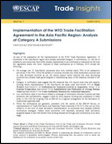 Implementation of the WTO Trade Facilitation Agreement in the Asia-Pacific Region: Analysis of Category A SubmissionsWorld Trade Organization (WTO) Trade Facilitation Agreement (TFA) provisions notified under Category A are those that WTO Member States have already implemented or have committed to implement by the time the Agreement enters into force or, in the case of the least-developed countries (LDCs), within a year of its entry into force. Provisions not included under this category are those which will require capacity building and technical assistance, or presumably take longer to implement. This trade insight paper analyzes Category A notifications of 15 economies in the Asia-Pacific region, contrasting the results with findings from an earlier ESCAP Survey on Implementation of Trade Facilitation and Paperless Trade (SITFAP) 2013/14 in order to examine some of the most challenging WTO TFA provisions, and gain insights on regional priorities for cooperation and capacity building. Author: Yann Duval and Pamela Bayona Year: 2015 Download Tags: Trade Facilitation, WTO, Least Developed Countries, UNESCAP Mega-regionals and the Regulation of Trade: Implications for Industrial PolicyThis report reviews key industrial policy issue areas being negotiated in mega-regional free-trade agreements—in particular, the Trans-Pacific Partnership—and evaluates how possible outcomes will impact the international trading system. Reviewing areas where the mega-regionals may impose systemic constraints, including border measures, technical barriers to trade, sanitary and phytosanitary measures, and e-commerce measures, the report discusses a possible future framework for industrial policy that integrates the additional policy constraints and changes introduced by these agreements. Author: Dan Ciuriak and Harsha V. Singh Year: 2015 Download Tags: Trade, Trade Facilitation, Free Trade Agreements Key Recommendations: South-Asia Consultation on the Post-2015 Development AgendaThe South Asian Association for Regional Cooperation, the United Nations Development Programme, the United Nations Economic and Social Commission for Asia and the Pacific, and the Asian Development Bank organized the South Asia Consultation on the Post-2015 Development Agenda in Nagarkot, Nepal on 26-28 August 2014. This Nagarkot Statement contains the eight guiding principles for future goals, key messages and recommendations on South Asia’s development priorities, financing for a post-2015 development agenda to support sustainable development, and technology access, including data, monitoring and accountability. Author: United Nations Economic and Social Commission for Asia and the Pacific Year: 2015 Download Tags: South Asia, Sustainability, ICT Connecting South Asia and South East Asia This book analyzes how closer regional connectivity and economic integration between South Asia and Southeast Asia can benefit both subregions. It aims to build a broad case for increased connectivity between the two regions and identify specific projects that have high potential to fulfill this objective. This joint study focuses on both “hard” infrastructure and associated “soft” infrastructure, including tariffs and non-tariff barriers, trade and transport facilitation, energy trading, and infrastructure investment and financing. It further provides a canvas for considering strategic cross-border infrastructure investments and policy reforms. Author: Asian Development Bank Institute and Asian Development Bank Year: 2015 Download Tags: South Asia, Southeast Asia, Connectivity, Economic Corridor, Transport, Trade Facilitation, Bangladesh, India, Sri Lanka Enabling Trade: Increasing the Potential of Trade Reforms This publication reviews specific elements of trade reform and proposes potential improvements that governments can make in collaboration with the private sector, using case examples to illustrate supply chain bottlenecks. It further examines how national governments and the private sector can optimize
ongoing trade reforms to reduce or eliminate these obstacles. Author: Bain and Company and the International Trade Centre Year: 2015 Download Tags: Trade, Private Sector, Trade Policy Asian Development Outlook 2015: Financing Asia’s Future GrowthThe Asian Development Outlook 2015 forecasts that the 6.3% rate of gross domestic product expansion achieved in 2014 will continue into 2015 and 2016. This is supported by a strengthening recovery in major industrial economies and soft global commodity prices. It also projects growth in South Asia to
accelerate to 7.2% in 2015, and 7.6% in 2016. Developing Asia needs a deep, robust financial sector to sustain growth, and policymakers are challenged to ensure inclusive financial sector development and financial stability to enhance growth and equity. Author: Asian Development Bank Year: 2015 Download Tags: Asia-Pacific, South Asia, Financial Sector Towards Trade Policy Analysis 2.0: From National Comparative Advantage to Firm-Level Trade DataThis paper argues for the need to upgrade current analytical tools for trade policy analysis and complement them with more detailed, firm-level data. Firm-level data allows a more refined assessment of future impact of trade policy initiatives, improves ex-post assessments, and enhances communication leading to a meaningful engagement with stakeholders, thus reducing public misperceptions about trade policy. A Trade Policy Analysis 2.0 could contribute to a better understanding of international trade for firm competitiveness, job creation, and consumer welfare. Author: Lucian Cernat Year: 2015 Download Tags: Trade Policy, Firms, Trade, ADB Policy Enablers for New Wind Energy MarketsThis publication focuses on the wind energy policies that can support sustained development of wind power in emerging wind energy markets. The policies are based on the work done by Quantum Leap in Wind Power Development in Asia and the Pacific (QLW). QLW is a $2 million, 3-year project funded by the Asian Development Bank, to facilitate wind power sector development in developing countries. The success and failures of wind energy policies in Mongolia, the Philippines, and Sri Lanka – including its impact and evolution – are analyzed in this report. Author: Pramod Jain and Bo An Year: 2015 Download Tags: Energy, Asia-Pacific, Sri Lanka, Sustainability, ADB 25 Years on the Ground: ADB-Nepal Partnership for Inclusive DevelopmentThis publication commemorates 25 years of Nepal Resident Mission’s opening and provides an overview of the Asian Development Bank’s (ADB) operation in Nepal over the years. It highlights ADB-assisted projects and Nepal’s association with the South Asia Subregional Economic Cooperation (SASEC) initiative, to further enhance the nation’s role in regional and world trade. These projects aim for regional energy cooperation (SASEC Power System Expansion Project), as well as subregional cooperation and connectivity in the transport sector (SASEC Road Connectivity Project and Subregional Transport Facilitation Project). Author: Asian Development Bank Year: 2015 Download Tags: Nepal, Transport, Energy, ADB RCI Nepali-language Version of Revised Kyoto ConventionThe Revised Kyoto Convention is a blueprint for Customs reform, and the Nepali-language version will assist Nepal’s Department of Customs to align its Customs Act and associated regulations with RKC standards, enhance efficiency and effectiveness of the Customs administration, and facilitate trade through more transparent Customs procedures. The standards of the RKC in the General Annex and Specific Annexes include duty collection, Customs control, information technology usage, and Customs clearance, among others. Author: World Customs Organization Year: 2015 Download Tags: Nepal, WCO, Customs Electricity Consumption, Output, and Trade in BhutanThis ADB South Asia Working Paper examines the relationship between electricity consumption, international trade, and economic growth using an augmented production function framework. The findings show that Bhutan is energy-dependent and can promote economic growth through future investment in hydropower. More specifically, the results show that a 1% increase in (i) electricity consumption generates 0.03%-0.05% increase in output, (ii) total trade results in 0.5% increase in output, (iii) trade openness results in 1% increase in output. Author: Hooi Hooi Lean and Russell Smyth Year: 2015 Download Tags: Energy, Trade, Bhutan, ADB, South Asia, Hydropower, ADB RCI 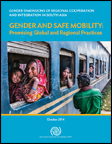 Gender Dimensions of Regional Cooperation in South Asia: Gender and Safe Mobility – Promising Global and Regional PracticesThis technical report analyzes global practices related to gender equality and safe migration, and their applicability to the context of South Asia. "Hard" aspects, such as physical infrastructure and equipment including border infrastructure, passenger holding facilities and surveillance cameras, and "soft" aspects, such as regional, bilateral and/or country-specific policies, programs, mechanisms and institutional linkages of safe mobility, are presented. The report also presents national policies and procedures that promote safe mobility. Given the lessons drawn from the reviewed policies and practices, it highlights the need for stronger evidence-based approaches in understanding the complex experience of women migrant workers, and identifies the need for more regular peer exchange through periodic regional dialogues of key stakeholder groups. Author: International Organization for Migration Year: 2014 Download Tags: Gender, Migration, South Asia, Bangladesh, Bhutan, India, Nepal, Transport, Trade 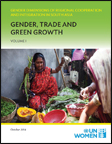 Gender Dimensions of Regional Cooperation in South Asia: Gender, Trade and Green Growth (Volumes I and II)This technical report presents an analysis of the interconnection between gender equality, regional trade and sustainable development in selected areas of four South Asian countries. In general, the report found women's contributions to total exports of all countries to be low, and in green exports to be lower. It identifies constraints and challenges, such as limited training in entrepreneurship, gender stereotypes related to green trade, existing gaps in policy framework, and weak access to technology, hindering women's participation in three green trade industries - agriculture and agro-processing, renewable energy, and ecotourism. The report looks at possible entry points for women, and recommended a list of actions to tap these identified entry points, including the need for greater exchange and cross-fertilization of experience among associations of women entrepreneurs and women’s chambers of commerce in South Asia. Author: Shreyasi Jha, Ritu Dewan, Amee Misra, Saloni Singh, Navanita Sinha, Maheen Sultan and Sonam Tobgay Year: 2014 Download Tags: Gender, Trade, Sustainability, South Asia, Bangladesh, Bhutan, India, Nepal 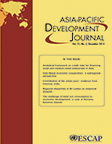 Asia-Pacific Development Journal Vol. 21, No. 2, December 2014The paper "Indo-Nepal Economic Cooperation: A Subregional Perspective" published in this issue of the Asia-Pacific Development Journal (APDJ) explores how subregional engagement among bordering regions can stimulate economic cooperation among countries in South Asia. It assesses the current status and potential of greater integration between India and Nepal, and develops a SWOT (strength-weakness-opportunity-threat) analysis reflecting on the need for a subregional approach to promotion of regional cooperation. APDJ, published twice a year by the Macroeconomic Policy and Development Division of UNESCAP, provides a platform for exchange of knowledge, experience, ideas, information and data on all aspects of economic and social development issues and concerns facing the region. Author: United Nations Economic and Social Commission for Asia and the Pacific Year: 2014 Download Tags: Economic Integration, India, Nepal, Trade, Bangladesh, Sri Lanka, Transport, Trade, Tourism Developing Economic Corridors in South Asia This book describes key conditions for transforming transport corridors into economic corridors and establishes the rationale for developing economic corridors, and the related benefits from production value chains along those corridors. It further emphasizes the significant potential of economic corridors in South Asia, particularly those being developed under the South Asia Subregional Economic Cooperation Program. The chapters highlight the impact of trade barriers on bilateral trade and present case studies on trade facilitation in South Asia. Countries in the subregion would benefit by working closely to exploit the full economic potential of economic corridors. Author: Asian Development Bank Year: 2014 Download Tags: Economic Corridor, South Asia, Trade Facilitation, Bangladesh, India, Sri Lanka, ADB, SASEC, Bilateral Trade, Transport World Tariff Profiles 2014This statistical yearbook devoted to market access for goods contains a comprehensive compilation of tariff parameters for each of the 160 World Trade Organization members, plus a number of other countries and customs territories where data is available. Each country profile presents information on tariffs
imposed by each economy on its imports, including an analysis of market access conditions in its major export markets. Statistics for all countries allow easy comparisons between countries and sectors, as well as between bound and applied tariffs. Author: World Trade Organization, International Trade Centre, and United Nations Conference on Trade and Development Year: 2014 Download Tags: WTO, Customs, Tariff, Bangladesh, India, Maldives, Nepal, Sri Lanka, Transport, Tariffs, Trade SME Competitiveness and Aid for Trade: Connecting Developing Country SMEs to Global Value ChainsThis joint ITC-WTO study discusses constraints faced by small and medium-sized enterprises (SMEs) in international trade, particularly by least developed countries. It reviews how Aid for Trade addresses these challenges through a sample of 23 Diagnostic Trade Integration Studies. Three bottlenecks emerge – quality of business environment, access to finance, and lack of institutional support to overcome trade-related challenges. This study also highlights actions taken by companies to integrate SMEs into their supply chains and concludes with an analysis of recent private sector program evaluations. Author: International Trade Centre and World Trade Organization Year: 2014 Download Tags: SME, Trade, Private Sector, Small and Medium Enterprises, Bhutan, India, Nepal, Sri Lanka, Sustainability Trans-Pacific Partnership versus Regional Comprehensive Economic Partnership: Control of Membership and Agenda Setting This ADB Working Paper argues that the formation of regional integration frameworks can be best understood as a dominant state’s attempt to create its own regional framework where it can exercise some exclusive influence. It explores the Trans-Pacific Partnership and the Regional Comprehensive Economic Partnership (RCEP). It also analyzes the strategies of key players such as ASEAN, Korea, India, Japan, USA and China. India is part of the RCEP negotiating process and sees increased presence in Southeast and East Asian markets, closer relations with ASEAN, and increased connectivity with North Asia and Oceana as benefits from involvement in RCEP. Author: Asian Development Bank Year: 2014 Download Tags: Regional Integration, India, Connectivity, ADB, Regional Cooperation, ASEAN National Trade Facilitation Bodies in the World This UNCTAD publication provides the first, in-depth quantitative analysis of 50 existing national trade facilitation bodies and a first-hand set of recommendations from experiences of participating stakeholders. It offers policy-oriented conclusions to assist countries about to set up or strengthen their national trade facilitation working groups. The study reveals that the biggest challenge for trade facilitation working groups is sustainability. Its determining elements include the administrative culture of each country, level of development, or type of body and geographical region. Author: United Nations Conference on Trade and Development Year: 2014 Download Tags: Trade Facilitation, Trade Policy, Sustainability, UNCTAD, Bangladesh, Bhutan, Nepal, Sri Lanka 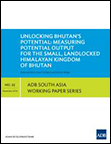 Unlocking Bhutan’s Potential: Measuring Potential Output for the Small, Landlocked Himalayan Kingdom of Bhutan The hydropower sector has driven Bhutan's economic growth in the past two decades with growth rates averaging 7.9%. Yet, the economy has not been invulnerable to market fluctuations and external shocks. This ADB South Asia Working Paper analyzes how Bhutan can create sustainable and inclusive growth, alongside the continuous expansion of its hydropower industry. It examines how certain policies can impact Bhutan's potential growth over 2013–2030. Results show that higher investment in education, health, and efforts to diversify its economic base—including enhancement of new industries with linkages to regional and global value chains—can further drive economic growth and improve the country's living standards. Author: Sabyasachi Mitra, Sarah Carrington, and Anthony Baluga Year: 2014 Download Tags: Bhutan, Energy, Economics, Hydropower, ADB, South Asia, Sustainability, Global Value Chains, Economic Growth A World Trade Organization for the 21st Century: The Asian PerspectiveThis Asian Development Bank Institute book examines key changes in the world trading system and explores policy implications for Asia. Through a compilation of essays from prominent international and Asian trade experts, this book presents interaction of market forces and trade regulation. Lessons from the Asian experience offer new approaches and economic policies to sustain growth, presenting the World Trade Organization as a forum to improve regional and global trade governance in the 21st century. Author: Richard E. Baldwin, Masahiro Kawai, Ganeshan Wignaraja (Eds.) Year: 2014 Download Tags: Trade, Trade Policy, WTO, Bangladesh, Bhutan, Energy, India, Maldives, Nepal, Sri Lanka, Transport Seaborne Trade between South Asia and Southeast Asia This Asian Development Bank Institute paper examines trade and the main ports around the Bay of Bengal to identify projects that will enable trade and contribute to improved maritime infrastructure. It also reviews the nature of trade and trade patterns, particularly through the Indian East Coast Corridor study. The paper develops further strategic options for seaport adjustment around the Bay of Bengal to support trade evolution, policy assessment, and other constraints. Author: David Wignall, Mark Wignall Year: 2014 Download Tags: Transport, Trade, Ports, ADB, India, Economic Corridor, Bangladesh, Energy, Myanmar, Sri Lanka Regional Transit Agreement in South Asia: An Empirical InvestigationThis discussion paper published by the South Asia Watch on Trade, Economics and Environment assesses the potential gains of a sub-regional transit arrangement and the removal of other border-trade barriers, particularly the eastern South Asia sub-region (Bangladesh, Bhutan, India and Nepal). It also discusses the link between transit and trade flows, provides profiles of intra-regional transit trade and current transit arrangements in South Asia, and identifies efficient regional transit corridors using linear programming or the Data Envelopment Analysis model. Author: Prabir De and Arvind Kumar Year: 2014 Download Tags: South Asia, Trade, Transport, Economics, Economic Corridor, SASEC, SAARC, UNESCAP, Customs, Harmonisation, Bangladesh, Bhutan, India, Nepal, Maldives, Sri Lanka Global Production Networks and Economic Corridors: Can They Be Drivers for South Asia’s Growth and Regional Integration?This Asian Development Bank South Asia Working Paper examines the role of regional and national economic corridors in facilitating access of South Asian countries to global production networks (GPNs), particularly East Asia and Southeast Asia. It also reviews the state of regional trade integration and examines the nature of engagement in South Asia, specifically India, with its dynamic and high growth GPNs. The paper further identifies key factors that constrain engagement of South Asian countries with East and Southeast Asia in GPN trade. Author: Kunal Sen Year: 2014 Download Tags: South Asia, Global Production Network, Economic Corridor, ADB, Regional Integration, India, Bangladesh, Sri Lanka 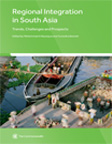 Regional Integration in South Asia: Trends, Challenges and ProspectsThis study presents an assessment of trade and economic cooperation among South Asian nations, explores emerging challenges, and highlights policy issues to foster regional integration. It provides perspectives on potential new areas of cooperation such as investment, regional supply chains, energy, and cross border transport networks. The four areas of focus are: potential gains from South Asian regional integration, key areas for cooperation resulting in effective regional integration, country perspectives of regional cooperation, and case studies on bilateral cooperation. This volume aims to further contribute to policy discourse on effective regional cooperation with perspectives from Bangladesh, India, Maldives, Nepal, Pakistan, and Sri Lanka.
Author: Mohammad A. Razzaque, Yurendra Basnett (Eds.) Year: 2014 Download Tags: South Asia, Regional Integration, Regional Cooperation, Bangladesh, India, Maldives, Nepal, Sri Lanka, Energy UNCTAD Transport Newsletter: Fourth Quarter 2014This United Nations Conference on Trade and Development (UNCTAD) newsletter focuses on the development dimension and benefits of the World Trade Organization Trade Facilitation Agreement. It includes sections on the national trade facilitation committees, project proposal for the implementation of trade facilitation measures contained in the agreement, and improvement in implementation of sanitary and phytosanitary measures to facilitate trade. It also includes UNCTAD’s contribution to trade facilitation in Landlocked Developing Countries and Small Island Developing States. Author: United Nations Conference on Trade and Development Year: 2014 Download Tags: Trade Facilitation, WTO, UNCTAD, Transport, Development, Sanitary and Phytosanitary Measures, Energy, India Statistical Yearbook for Asia and the Pacific 2014The Statistical Yearbook contains comparative statistics and facts about the 58 regional members and associate members of the Economic and Social Commission for Asia and the Pacific. It includes brief analyses of 32 key development features such as energy supply and use, international trade, and transport, among others. In energy, the region’s production structure is highly resource-intensive, although per capita energy use is low. The section on international trade recommends focusing on raising domestic value-added rather than increasing gross exports in Asia and the Pacific. Finally, investment in environmentally sustainable transport is encouraged. Author: United Nations Economic and Social Commission for Asia and the Pacific Year: 2014 Download Tags: Asia-Pacific, Energy, Trade, Transport, Bangladesh, Bhutan, India, Maldives, Nepal, Sri Lanka The Competitiveness of Global Port-CitiesThis book explores the inter-linkages between ports and urban development. It provides an internationally comparative benchmark study of port cities. Case-studies of selected port-cities provide detailed analysis of port performance, port impacts, policies, and governance. The least time-efficient ports are located in Africa and South Asia. Mumbai, India, for example – one of the selected port-city profiles – lacks port infrastructure and suffers from heavy regulation. Author: Organization for Economic Co-operation and Development Year: 2014 Download Tags: Transport, Ports, India NTMs in South Asia: Assessment and AnalysisThe study “NTMs in South Asia: Assessment and Analysis” analyzes how Non-tariff Measures (NTMs) give rise to non-tariff barriers, which are becoming increasingly crucial for advancing trade cooperation among member countries of the South Asian Association for Regional Cooperation, yet remain less-addressed. The study examines export potential and actual export of South Asian countries, and attempts to highlight gains from reduction in transaction costs in bilateral trade. It also notes that initiatives for trade facilitation reforms in South Asia at the regional level remain low in incentives and have yet to produce significant results. The study closes with several recommendations for reducing and eliminating NTMs. Author: Selim Raihan, Mostafa Abid Khan, and Shaquib Quoreshi Year: 2014 Download Tags: Trade Facilitation, Trade, SAARC, Bangladesh, Bhutan, India, Maldives, Nepal, South Asia, Sri Lanka 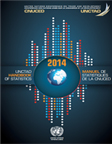 UNCTAD Handbook of Statistics 2014The UNCTAD Handbook of Statistics is a collection of statistics and indicators relevant to the analysis of international trade, investment and development. The 2014 edition shows the increasing convergence of trade balance between developing and developed economies continues. The report also includes regional trade data from South Asia that shows average annual growth rate of international trade improved from a previous deficit of -7.1% in 2012 to -0.1% in 2013. However, trade balance ran a deficit of -26.51% compared to the previous year's -25.94%. Trade indicators also report intra-trade in South Asian Association for Regional Cooperation region rose modestly from US$ 20,219 million to US$ 23,181 million between 2012 to 2013 and maintains intra-regional trade percentage at 5.8%. Author: United Nations Conference on Trade and Development Year: 2014 Download Tags: UNCTAD, Regional Trade, Development, Bangladesh, Bhutan, India, Maldives, Nepal, Sri Lanka, Transport  The Connectivity AgendaThis article appeared in the special issue of My Republica published on the occasion of the 18th SAARC Summit. Mr. Ronald Antonio Q. Butiong, Unit head of the South Asia Subregional Economic Cooperation (SASEC) Regional Cooperation and Operations Coordination Division of the Asian Development Bank (ADB), traces the blueprints of SASEC projects to the South Asian Association for Regional Cooperation (SAARC) Regional Multimodal Transport Study (2006) and SAARC Regional Energy Trade Study (2010); two studies supported by ADB and endorsed by SAARC member states. Highlighting the SASEC focus to promote economic cooperation in the subregion by developing cross-border connectivity and facilitating intra-regional trade in South Asia through its priority sectors—energy, transport, and trade facilitation—Mr. Butiong explains how ADB is providing assistance to sections of Bangladesh, Bhutan, India, and Nepal along SAARC corridors through SASEC. Featuring a brief discussion of key SASEC projects and technical assistance (since 2001, 33 projects implemented, worth over US$6 billion) alongside institution and capacity-building support, the article shows how the SASEC connectivity agenda is part of achieving SAARC development objectives. Author: Ronald Antonio Q. Butiong Year: 2014 Download Tags: SAARC, Energy, Transport, Trade Facilitation 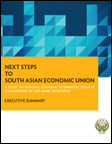 Next Steps to South Asian Economic UnionThis executive summary focuses on Phase II of the study on Regional Economic Integration, commissioned by the South Asian Association for Regional Cooperation (SAARC) Secretariat with the technical and financial assistance of the Asian Development Bank, and outlines a roadmap toward a South Asian Economic Union (SAEU). It presents an overview of intra-regional trade in South Asia—with India accounting for 65% of the region's combined total exports, and Sri Lanka 24% of total intra-regional imports—and discusses specific priority steps, using a phased and planned approach that quantifies potential gains from priority sectors identified in Phase I, needed to achieve regional economic integration. Thus, while non-tariff barriers, infrastructure constraints and other factors continue to challenge regional cooperation and integration in South Asia, reference by SAARC leaders toward an SAEU indicates a willingness to consider bold action. Author: Asian Development Bank Year: 2014 Download Tags: SAARC, South Asian Economic Union, Economic Integration, Bangladesh, Bhutan, India, Maldives, Nepal, Sri Lanka, Regional Integration Bridging Transport, ICT, and Energy Infrastructure Gaps for Seamless Regional ConnectivityThis publication is a contribution by the United Nations Economic and Social Commission for Asia and the Pacific to deliberations at the Second United Nations Conference on Landlocked Developing Countries (LLDCs) in Vienna, Austria, 3-5 November 2014. It shows regional connectivity as an unfinished agenda and bridging infrastructure gaps as a complex challenge for LLDCs. While physical infrastructure is a priority, this report argues that deeper regional integration – through regionally cohesive and terrestrial networks – is key to effectively linking Asian LLDCs to the region’s infrastructure networks. Author: United Nations Economic and Social Commission for Asia and the Pacific Year: 2014 Download Tags: Transport, ICT, Energy, UNESCAP, SASEC, Connectivity, Infrastructure, Bangladesh, India, Nepal, Sri Lanka, Trade, Trade Facilitation, Policy, Trade Policy Review of Maritime Transport 2014The Review of Maritime Transport is an annual UNCTAD flagship publication since 1968. It provides analysis of structural and cyclical changes affecting seaborne trade, ports and shipping, freight markets, and transport and regulatory frameworks. It further presents statistics, data, and insights on ownership of the world fleet, with South Asia dominating the market for ship recycling. This year’s special chapter focuses on the challenges faced by the world’s Small Island Developing States (SIDS) and reviews shipping-related challenges resulting from SIDS size, remoteness, and exposure to natural hazards, including impacts of climate change. Author: United Nations Conference on Trade and Development Year: 2014 Download Tags: Transport, Ports, Small Island Developing States, UNCTAD, Trade, South Asia, Bangladesh, India, Maldives, Sri Lanka Doing Business 2015: Going Beyond EfficiencyThe World Bank Group’s Doing Business Report 2015 is the 12th in its annual series of investigations into regulations that enhance business activity. Its indicators analyze economic outcomes and identify reforms to promote better regulatory frameworks for development, job creation, and growth. For the first time this year, the Doing Business report extends its coverage beyond the second largest city to include economies with a population of more than 100 million such as Chittagong in Bangladesh, and Delhi in India. The data provides insights into the variability of business regulations within economies. Author: The World Bank Year: 2014 Download Tags: Asia-Pacific, Bangladesh, India, Ease of Doing Business, Bangladesh, WB Asian Economic Integration Monitor: November 2014This AEIM review of recent economic performance highlights the need for Asia to rebalance its sources of growth toward domestic and regional demand. It also shows a resilient Asia with rising GDP growth in South Asia. This issue includes a Special Chapter: Regional Financial Integration and Crisis in Asia and Europe – A Comparative Analysis. It presents Asia’s future path of integration as different from that in Europe. Asia will continue to strengthen efforts to harmonize rules and regulations in the financial sector and further unilateral trade and investment, while Europe is more likely to strengthen regional institutions to ensure recovery and better the monetary union. Author: Asian Development Bank Year: 2014 Download Tags: Asia-Pacific, Economic Integration, Europe, ASEAN, Bangladesh, Bhutan, India, Maldives, Nepal, Regional Integration, Sri Lanka, Trade Facilitation, Transport 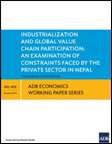 Industrialization and Global Value Chain Participation: An Examination of Constraints Faced by the Private Sector in NepalThis paper examines the constraints behind and beyond Nepal's borders that hinder its full participation in global value chains (GVC). Basing the analysis on recent and relevant publications, key economic data, and interviews with policymakers and stakeholders, the authors explain how weak and uncertain industrial policy has led to de-industrialization. They also looked at the effects of inadequate infrastructure, energy shortage, and inefficient transit. Failures in coordination, shallow regional integration and non-tariff barriers also bar further growth of Nepal's industrial development and GVC participation. The authors recommend necessary domestic reforms for behind-the-border constraints, and subregional partnerships—facilitated through the South Asia Subregional Economic Cooperation program—for beyond-the-border challenges. Author: Yurendra Basnett and Posh Raj Pandey Year: 2014 Download Tags: Infrastructure, Private Sector, Nepal, Global Value Chains, Industrialization, Infrastructure, Energy, Transport, Regional Integration, SASEC SASEC Website BrochureThis promotional brochure for the SASEC website features the web portal as a one-stop shop for information on SASEC activities, events, projects, and knowledge materials. The SASEC website seeks to build a dynamic discussion platform and repository of data on regional cooperation. Author: Asian Development Bank Year: 2014 Download Tags: SASEC, Knowledge Product, ICT, ADB, Bangladesh, Bhutan, India, Maldives, Nepal, South Asia, Transport, Trade Facilitation, Energy SASEC BrochureThis promotional brochure is a concise introduction to the South Asia Subregional Economic Cooperation (SASEC) Program, highlighting the main areas of regional cooperation and activity. It includes facts and figures about SASEC projects in transport, trade facilitation, energy, and ICT. Author: Asian Development Bank Year: 2014 Download Tags: SASEC, Trade Facilitation, Regional Cooperation, ICT, ADB, Bangladesh, Bhutan, India, Nepal, Maldives, Sri Lanka, Energy, Transport, Connectivity, Myanmar 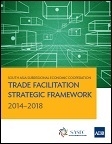 SASEC Trade Facilitation Strategic Framework 2014-2018The South Asia Subregional Economic Cooperation (SASEC) Trade Facilitation Strategic Framework 2014-2018 builds on the momentum of member countries over recent years in forging ahead with many significant improvements to facilitate, and ultimately increase, trade in the subregion and with the rest of the world. It supports the mission of the SASEC Transport and Trade Facilitation Strategy “to promote the prosperity of the subregion by facilitating the efficient movement of trade across the borders”, and focuses on five priority areas: customs modernization and harmonization; standards and conformity assessment strengthening; cross-border facilities improvement; through-transport facilitation; and institution and capacity building. Author: Asian Development Bank Year: 2014 Download Tags: SASEC, Trade Facilitation, Regional Cooperation, Transport, Trade, Customs, Standards, Harmonisation, Regional Integration, ADB, Bangladesh, Bhutan, India, Maldives, Nepal, Sri Lanka, South Asia, ADB RCI 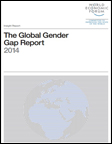 The Global Gender Gap Report 2014The Global Gender Gap Index benchmarks national gender gaps on economic, political, education and health criteria. According to this 2014 edition, the Asia and Pacific region has closed 66% of its overall gender gap. However, it continues to rank second from last on the Economic Participation and Opportunity subindex. According to the report, Bangladesh has achieved its highest overall score since 2006, with significant improvements on the Economic Participation and Opportunity, and the Educational Attainment and Health and Survival subindexes. However, it still ranks 127th on the Economic Participation and Opportunity subindex, a score still below the subindex average. Nepal ranks second highest in percentage change for improvements in the Educational Attainment, Health and Survival, and Political Empowerment subindexes, but ranks 122nd on the Economic Participation and Opportunity subindex. India is also below average on the Economic Participation and Opportunity subindex. Author: World Economic Forum Year: 2014 Download Tags: Gender, Economic Participation, Trade 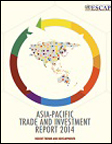 Asia-Pacific Trade and Investment Report 2014: Recent Trends and DevelopmentsThis Asia-Pacific Trade and Investment Report 2014 provides an analysis of recent regional trends and developments in: (a) intraregional trade in goods and services; (b) foreign direct investment (FDI);
(c) trade facilitation measures; (d) trade policy measures; and (e) preferential trade agreements. According to this report, South and South West Asia’s FDI inflow improved, registering a 6% increase, with India holding the largest FDI share. However, performance in key trade and investment indicators was weak in 2013, with merchandise exports decreasing by 0.2%, around 71% of exports going to destinations outside the Asia-Pacific region, and around 64% of merchandise being imported from extra-regional sources. This publication also provides a preliminary regional assessment of the implementation of trade facilitation measures included in the TFA. This section concludes by identifying areas that countries need to focus on in order to further advance trade facilitation in the region. Author: UNESCAP Year: 2014 Download Tags: FDI, Trade, Trade Facilitation World Trade Report 2014 – Trade and Development: Recent Trends and the Role of the WTOThis annual publication highlights the relationship between trade and development, including changes since the start of the millennium. It identifies four key trends that altered the way trade affects development outcomes – accelerated economic growth in developing countries, expansion of global value chains, increase in agricultural and natural resource prices, and global nature of macroeconomic shocks. This report also explores how these trends have reshaped the role of trade in facilitating development and how recent development gains allow developing countries to adapt and mitigate risks. Author: World Trade Organization Year: 2014 Download Tags: WTO, Global Value Chains, Trade, Economic Growth, Agriculture, Trade Facilitation, Development, Bangladesh, Bhutan, India, Maldives, Nepal, South Asia, Sri Lanka South Asia Economic Focus: The Export OpportunityThis bi-annual report presents the recent economic developments, outlook, and policy of the following South Asian countries – Afghanistan, Bangladesh, Bhutan, India, the Maldives, Nepal, Pakistan, and Sri Lanka. It highlights developing country growth as fairly robust. Meanwhile, India’s growth rate is slowly increasing and its inflation rate declining. South Asian economies solidified their external positions by easing pressures to finance current account deficits, yet face domestic challenges such as reducing fiscal risks, supporting higher levels of investment, and sustaining export growth. Author: The World Bank Year: 2014 Download Tags: South Asia, Trade, Economics, WB, Bangladesh, Bhutan, India, Maldives, Nepal, Sri Lanka 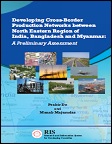 Developing Cross-Border Production Networks Between North Eastern Region of India, Bangladesh and Myanmar: A Preliminary AssessmentThis publication is an extension of an earlier study conducted by the Research and Information System for Developing Countries and presents opportunities in cross-border production networks between North Eastern Region (NER) of India, Bangladesh, and Myanmar. It also explores NER’s growth potential, including the role of trade facilitation in enhancing trade and production networks. Supply-side constraints in the region, as well as bottlenecks to cross-border production links, are further identified through extensive field surveys and structured questionnaires. Finally, this publication argues that logistical efficiency is crucial to production networks between India and Bangladesh, and NER states should be engaged in closer economic integration. Author: Prabir De and Manab Majumdar Year: 2014 Download Tags: India, Bangladesh, Economic Integration, Regional Integration Asian Development Outlook 2014 Update: Asia in Global Value ChainsAs developing Asia continues along a stable growth path, India maintains a 5.5% growth forecast for 2014 and shows promise of a turnaround. Reforms are envisioned for 2015, including a forecast 0.3% upgrade to 6.3%. Bhutan recorded the largest current account deficit as a percentage of GDP, due to imports used in construction of several large hydropower projects that will expand its energy export capacity to India. Meanwhile, South Asia is expected to perform with greater momentum in 2015, with a growth forecast upgrade to 6.1% from 5.8%. Most of the improvements in the subregion are from India’s deficit and Bangladesh’s current account. Nepal also shows improved outlook for 2015. Author: Asian Development Bank Year: 2014 Download Tags: South Asia, Global Value Chains, India, Economics, Trade 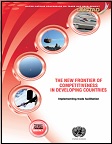 The New Frontier of Competitiveness in Developing Countries: Implementing Trade FacilitationThis report presents an overview of implementation challenges for realizing trade facilitation reforms. It consolidates results of 26 national trade facilitation implementation plans in 26 countries, comprising least developed countries, middle-income developing countries, landlocked countries, and small island economies in Africa, Asia, the Caribbean and Latin America. In the 26 countries surveyed, the level of implementation of trade facilitation measures in the World Trade Organization (WTO) is considerably lower in least developed countries (LDCs) than in developing countries. Since trade facilitation still remains a major challenge for developing countries and LDCs, an international legal regime with special and differential treatment will help developing WTO members achieve further progress. Author: United Nations Conference on Trade and Development Year: 2014 Download Tags: Trade Facilitation, Asia-Pacific, WTO, Bangladesh, Bhutan, Nepal Port Management Series Volume 1: Port Management Case StudiesThis publication presents summaries of the best three dissertations from the past cycle of the English-speaking network of the Train-for-Trade Port Training Program (2011-2013). This United Nations Conference on Trade and Development Train-For-Trade Port Training Programme supports port communities in developing countries achieve efficient and competitive port management. The findings of the Maldives study reveal the possibility of reducing port maintenance by 15% of total operating costs through adherence to a maintenance schedule, standardizing equipment in procurement policy, updating maintenance requirements and available equipment, and recording maintenance expenditure. Author: United Nations Conference on Trade and Development Year: 2014 Download Tags: Maldives, Transport, Ports Impact of Trade Facilitation on Foreign Direct InvestmentThis United Nations Economic and Social Commission for Asia and the Pacific Trade and Investment Working Paper attempts to quantify the potential impact of trade facilitation on foreign direct investment (FDI) flows. The study uses bilateral FDI data from 2006 onward from both developing and developed countries, including South-South FDI flows, wherein contiguity (common border between source and host country) and geographic distance are found to be much more important factors. In applying an augmented FDI model framework to determine the effect of comprehensive international trade costs, the results show that both non-tariff and tariff costs are important determinants of FDI inflows. Author: Yann Duval and Chorthip Utoktham Year: 2014 Download Tags: FDI, Trade Facilitation, Bilateral Trade, UNESCAP, Investment, Tariff, Bangladesh, Maldives ASEAN, PRC, and India: The Great TransformationThis joint study by the Asian Development Bank and the Asian Development Bank Institute highlights the Association of Southeast Asian Nations, the People’s Republic of China, and India (collectively referred to as ACI economies) as drivers of the global economy. It explores links among ACI economies and how these may shape regional and global competition and cooperation. The study also notes that Asia’s leading economies can foster a positive outcome through a paradigm shift toward inclusive, green, and knowledge-led growth. Adoption of low-carbon, green growth strategies can help place ACI economies on a sustainable growth path. Furthermore, infrastructure and human capital investments can link ACI economies through region-wide free trade and investment agreements. Author: Asian Development Bank and Asian Development Bank Institute Year: 2014 Download Tags: India, Asia-Pacific, Regional Cooperation, ADB, ASEAN, Investment 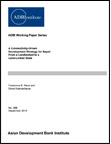 A Connectivity-Driven Development Strategy for Nepal: From a Landlocked to a Land-Linked StateTransforming Nepal from a landlocked into a land-linked state, the authors argue, could be key to unlocking the country's much-awaited growth. With its strategic location between India and the People's Republic of China, a connectivity-driven development strategy could energize Nepal's lackluster post-conflict economic performance. Further, Nepal implements a multi-track approach to promoting regional cooperation and integration in connectivity with its neighbors, reinforced through participation in South Asian Association for Regional Cooperation, Bay of Bengal Initiative for Multi-Sectoral Technical and Economic Cooperation, and South Asia Subregional Economic Cooperation. By identifying ten priority projects that could further boost Nepal's connectivity, the paper also discusses how strengthening Nepal's transport, energy, and trade links could benefit the region. However, the authors also warn against “internal threats” to Nepal's development—corruption and the country's difficult political situation. Author: Pradumna B. Rana and Binod Karmacharya Year: 2014 Download Tags: Nepal, Economic Corridor, Regional Trade, Connectivity, Development, Economic Growth, SASEC, India, Regional Cooperation, Regional Integration, SAARC, BIMSTEC, Transport, Energy, Trade Economic and Social Survey of Asia and the Pacific 2014This 2014 edition of UNESCAP's flagship publication emphasizes the importance of furthering regional connectivity in Asia-Pacific—a region which, despite significant reductions in poverty levels, is now witnessing rising income inequality, both within and between countries. It calls for driving the region's growth by exploiting the interdependence and synergies of five elements: trade and transport connectivity, ICT networks, energy connectivity, people-to-people networks, and promotion of knowledge-based economies, and advocates approaching connectivity as a regional public good. Author: UNESCAP Year: 2014 Download Tags: Economic Integration, Regional Cooperation, Poverty Reduction, Asia-Pacific, Connectivity, Energy, ICT, Bangladesh, Bhutan, India, Maldives, Sri Lanka, Trade, Transport, UNESCAP 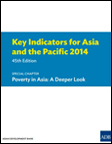 Key Indicators for Asia and the Pacific 2014This year's edition presents an in-depth inquiry on poverty in Asia, tackling whether the $1.25/day extreme poverty standard still accurately depicts minimum living standard of the poor in Asia and the Pacific. Using this broad measure, the poverty rate is projected to fall to 24.5% for South Asia by 2030, if recent economic growth trends continue. However, considering the current national poverty line average among today's less developed economies in the region, an Asia-specific extreme poverty line is more accurately estimated at $1.51/day, increasing Asia’s poverty rate in 2010 by 9.8%, and ��of a large economy like India by 15%. Hence, despite huge gains made, reducing poverty remains a pressing challenge in Asia and the Pacific. This book proposes several measures to counteract worsening poverty, including �close �regional cooperation which can reduce a country’s vulnerability, and urgent policy actions that promote economic growth and prioritize climate change adaptation and mitigation. Author: Asian Development Bank Year: 2014 Download Tags: Poverty Reduction, Disaster Risk, Regional Cooperation, Asia-Pacific, Bangladesh, Bhutan, Economics, Energy, India, Maldives, Milennium Development Goals, Nepal, Sri Lanka, Sustainability, Transport 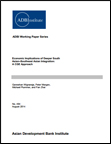 Economic Implications of Deeper South Asian–Southeast Asian Integration: A CGE ApproachHigh tariff and non-tariff barriers, and costly transport links and inefficient trade facilitation measures continue to hamper the growth of trade between South Asia and Southeast Asia. This paper explores whether potential gains from improved connectivity—via Myanmar as inter-regional bridge—justify a high level of investment. Using an advanced computable general equilibrium (CGE) model, reduction of inter-regional tariffs, decreasing of non-tariff barriers by 50%, and cutting down of trade costs between South Asia and Southeast Asia by 15% yields a prediction of 8.9% rise in welfare in South Asia and Southeast Asia, and an increase of 6.4% in gross domestic product by 2030. Author: Ganeshan Wignaraja, Peter Morgan, Michael Plummer, and Fan Zhai Year: 2014 Download Tags: Transport, Trade Facilitation, South Asia, Southeast Asia, Regional Integration, Tariff, Trade, Connectivity, Investment, Myanmar, GDP Assessing the Costs of Climate Change and Adaptation in South AsiaThis book discusses the economic costs and benefits of unilateral and regional actors on climate change adaptation in Bangladesh, Bhutan, India, the Maldives, Nepal, and Sri Lanka. It provides the total economic loss throughout the 21st century and estimates the funding required for adaptation measures to avert potential losses. Huge impacts are likely on vulnerable sectors in the region, with South Asia losing on average nearly 2% of its gross domestic product by 2050. Results of the study will aid climate change adaptation in the region, including initiatives for regional cooperation. Author: Mahfuz Ahmed and Suphachol Suphachalasai Year: 2014 Download Tags: Climate, South Asia, Regional Cooperation, Energy, Bangladesh, Bhutan, India, Maldives, Nepal, Sri Lanka 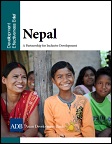 Nepal: Development Effectiveness Brief 2014Nepal has the potential to achieve more inclusive growth and can largely benefit from regional cooperation and integration with its developing neighbors. It is also benefiting from South Asia Subregional Economic Cooperation, a flagship ADB-supported program that promotes economic cooperation and integration in areas of trade facilitation (custom modernization and transport connectivity), power development, trade, and tourism development. This brief further explores ADB’s contribution to inclusive development and poverty reduction, energy, and transport. Exporting energy when surplus is available is one way of meeting seasonal demand by subregional cooperation and power trade. Transport infrastructure is also another key ingredient to equitable, inclusive growth that can address challenges such as lack of market access, inadequate roads, and poor connectivity. Author: Asian Development Bank Year: 2014 Download Tags: Nepal, Regional Cooperation, South Asia, ADB, Connectivity, Energy, Roads, SASEC, Trade, Transport Mega-regional Trade Agreements: Game-Changers or Costly Distractions for the World Trading System?This document explores the impact of regional trade agreements such as mega-regionals on countries that are not part of World Trade Organization negotiations. It focuses on trade-diverting effects of Trans-Pacific Partnership and Trans-Atlantic Trade and Investment Partnership such as the potential for multilateralization and discrimination. The report further explores potential impact of mega-regionals on Asia-Pacific, Sub-Saharan Africa, and Latin America. The latter sections highlight the opportunities and challenges in promoting coexistence of these future agreements with the multilateral trading system. Author: World Economic Forum Year: 2014 Download Tags: Asia-Pacific, Regional Trade, Trade Policy, India, WTO Future of Factory AsiaThis volume, co-published by the Asian Development Bank and the Korea Economic Research Institute, reflects one of the broad thematic sessions of the Seoul conference, Beyond Factory Asia. It assesses the challenges and sustainability of the Factory Asia model – supplying from the East and consuming in the West – and provides suggestions and strategies on effective management of these concerns. The volume further analyzes obstacles in the success of Factory Asia, its speed in expanding its own domestic and regional markets, and its progress in upgrading competitiveness in the manufacturing sector. The new Factory Asia must nurture new sources of growth in the region and focus on regional economic integration. Author: Choi Byung-il and Changyong Rhee (eds.) Year: 2014 Download Tags: Economic Integration, Asia-Pacific, Trade Policy, ADB, Asia, Manufacturing, Regional Integration, Bangladesh, Energy, Sri Lanka, Transport 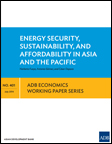 Energy Security, Sustainability, and Affordability in Asia and the PacificEnergy security, sustainability, and affordability from 2010 to 2035 for Asian Development Bank’s Asia and Pacific members are calculated in this working paper, including potential benefits of integrating energy systems regionally. Based on business-as-usual and alternative scenarios, outlook on SASEC member countries by 2035 include (i) dramatic improvement in Bhutan's energy efficiency, (ii) slight decrease in Bangladesh's energy intensity—although carbon dioxide will increase in its primary energy mix, as dependence on fossil fuels rise, and (iii) decrease in energy self-sufficiency of SASEC member countries by 2035, but improved energy affordability. Since renewable energy sources and importation of energy may be capital-intensive, requiring additional tariff support, regional cooperation can enhance affordability and energy security—with Bhutan and Nepal standing to benefit greatly from energy integration in South Asia. Author: Norberto Fueyo, Antonio Gómez, and César Dopazo Year: 2014 Download Tags: Energy, Bhutan, Nepal, Sustainability, Asia-Pacific, ADB, Regional Integration, SASEC, South Asia, Bangladesh, Sustainability, Renewables, Tariff, Regional Cooperation 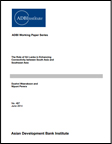 The Role of Sri Lanka in Enhancing Connectivity between South Asia and Southeast Asia As Sri Lanka rebuilds at the end of a 30-year conflict, its progress in improving physical infrastructure—including the Colombo port expansion and other programs for new expressways and road connectivity—has been significant. Yet, the country has seen a sharp decline in its overall exports-to-gross domestic product ratio. How Sri Lanka can benefit from greater connectivity with its neighbors in South Asia and Southeast Asia is discussed in this paper. Trade policies geared towards enhancing regional integration efforts could boost Sri Lanka's economy. Additionally, to lessen the challenges of financing and sustaining implementation of planned infrastructure development efforts, Sri Lanka could also implement a more stringent institutional and regulatory environment encouraging more private sector participation. Author: Dushni Weerakoon and Nipuni Perera Year: 2014 Download Tags: Trade Policy, Trade Facilitation, Sri Lanka, Connectivity, South Asia, Southeast Asia, ADB, Transport, Regional Integration Opportunity Cost of Natural Gas Subsidies in BangladeshThis paper examines the impact of optimal gas pricing policy using a general equilibrium model for the Bangladesh economy. It estimates the opportunity cost of underpricing or subsidizing gas in Bangladesh. It further explores the potential impacts of an increase in investment on social and physical infrastructure using the social accounting matrix multiplier model. The results reveal that Bangladesh is losing a significant development opportunity due to its gas subsidy. Calculations using a dynamic computable general equilibrium model suggest that withdrawal of the gas subsidy along with increased investments in physical and social infrastructure would lead to positive macroeconomic and sectoral effects in Bangladesh. Author: Herath Gunatilake and Selim Raihan Year: 2014 Download Tags: Bangladesh, Energy, ADB, Investment 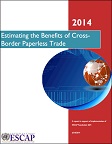 Estimating the Benefits of Cross-Border Paperless TradeCross-border paperless trade is trade that occurs on the basis of electronic communications and has been part of customs reform efforts in a variety of countries. Increased implementation of cross-border paperless trade is high on the trade facilitation agenda in Asia-Pacific. This report considers six measures to calculate estimates of possible economic benefits of cross-border paperless trade through counterfactual simulations using 2013 data and simple econometric models. Simulation results reveal that this new generation of trade facilitation can significantly reduce trade costs and boost intra- and extra-regional trade in the region. Partial implementation of these measures can lead to an export increase of $36 billion annually. Total direct cost savings across all trade is about $1 billion per annum for partial reform, and $7 billion for full implementation. Author: United Nations Economic and Social Commission for Asia and the Pacific Year: 2014 Download Tags: Trade Facilitation, Trade, Asia-Pacific, UNESCAP, Customs, Export, Bangladesh, Bhutan, India, Maldives, Nepal, Sri Lanka 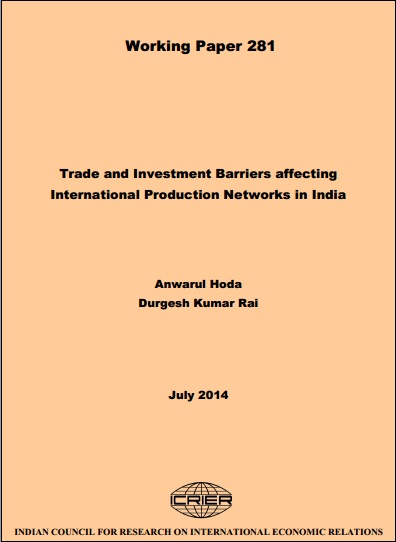 Trade and Investment Barriers Affecting International Production Networks in IndiaRecognizing India as an outlier in development of international production networks with the lowest participation among Asian countries, this study investigates the reason for India’s lackluster participation in production-sharing networks. Using desk work, field surveys, and interviews, an analysis is adopted with three comparator countries in the region that have been successful in production-sharing arrangements as well as industrial growth – China, Malaysia, and Thailand. It further describes foreign direct investment inflows into India, analyzes behind-the-border investment environment, and provides recommendations to improve investment climate and hasten the pace of manufacturing development in India. Author: Anwarul Hoda and Durgesh Kumar Rai Year: 2014 Download Tags: India, Trade, Production Networks, Investment, Thailand, Manufacturing, Customs, Economic Corridor, Energy, Trade Facilitation, Transport 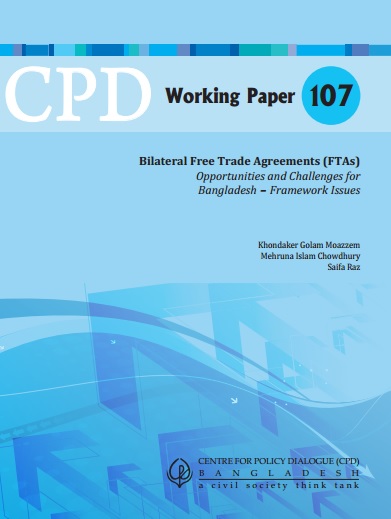 Bilateral Free Trade Agreements: Opportunities and Challenges for Bangladesh - Framework IssuesSlow progress of negotiations for multilateral trade under the World Trade Organization and the global economic crisis have led to a rise in Free Trade Agreements (FTAs) in developing countries, yet Bangladesh has remained ambivalent in setting its strategies regarding FTAs. Instead, it has opted to maintain exports through preferential market access with its partners among developed countries. This report cautions that with the increasing reduction of tariffs among developed countries, Bangladesh's preferential market access with these trading partners will soon lose its luster. On the other hand, exploring alternative markets by signing FTAs among least developed countries and developing countries in South Asia may be a better option for Bangladesh. This policy paper argues that Bangladesh needs to expand its export market by exploring bilateral FTAs with other trading partners, including its neighbors in the South Asia region. Author: Khondaker Golam Moazzem, Mehruna Islam Chowdhury, and Saifa Raz Year: 2014 Download Tags: Trade, Trade Policy, Bangladesh Green Power for Bhutan: Clean Energy Crosses Borders to Reach Poor HouseholdsConstructed under the ADB-financed Green Power Development Project, Bhutan's Dagachhu hydropower plant showcases how a public–private partnership for hydropower development successfully promotes cross-border energy trade, contributes to increased national energy security, and improves access to on- and off-grid energy for 9,000 rural households and public facilities. This report reviews the project's key features and discusses how an investment in renewable energy infrastructure is leading Bhutan and its neighboring countries toward greater inclusive growth. Author: Asian Development Bank Year: 2014 Download Tags: Energy, Infrastructure, Poverty Reduction, Bhutan, ADB RCI The Long and Winding Road: How WTO Members Finally Reached a Trade Facilitation Agreement The conclusion of the Agreement on Trade Facilitation at the Bali negotiations in December 2013 marked the end of a journey that lasted almost a decade. As the first multilateral trade agreement successfully negotiated by World Trade Organization (WTO) ministers, it broke new ground in the decentralized, bottom-up way the negotiations were structured; in the manner the capacities and resources of developing countries were addressed; and in how the Agreement has shifted the system’s focus beyond policy barriers toward process frictions. The negotiated outcome is likely to have an impact not just on Trade Facilitation, but on the WTO and the multilateral trading system as a whole. Author: Nora Neufeld Year: 2014 Download Tags: Trade Facilitation, Trade Policy, Regional Cooperation, WTO, India 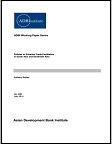 Policies to Enhance Trade Facilitation in South Asia and Southeast AsiaThis Asian Development Bank Institute publication identifies the state of play of trade facilitation and provides an overview of intra- and inter-regional trade in South and Southeast Asia. It highlights key challenges and bottlenecks to effective trade facilitation, ranging from the lack of expert human resources such as information technology specialists in small landlocked countries (Bhutan and Nepal), to the high border transaction costs and severe congestion faced at border crossing points, and the lack of effective dialogue on bilateral enhancement of trade facilitation. Regional initiatives such as the South Asia Subregional Economic Cooperation Program aim to address these challenges through customs modernization and harmonization, automation, and the use of international best practices in border procedures. Author: Anthony Bayley Year: 2014 Download Tags: South Asia, Trade Facilitation, Trade Policy, Southeast Asia, ADB, ICT, Bhutan, Nepal, SASEC, Customs 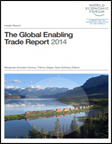 The Global Enabling Trade Report 2014The Global Enabling Trade Report offers a tool to monitor progress on implementing measures for the Trade Facilitation Agreement. Benchmarking the performance of 138 economies in four critical areas, including border administration, the Report takes off from the success of the Bali package by emphasizing measures that facilitate trade at a more practical level, with benefits that significantly outweigh the cost of necessary reforms and produces positive spillover effects on other indicators—market access, infrastructure, and operating environments. Also mentioned are insights on further boosting trade facilitation within the region, such as regional cooperation and sharing of good practices. The Report is intended as a motivator for change at a time of renewed momentum for trade facilitation where windows of opportunities for policymakers to push through trade-enabling measures are open. Author: Margareta Drzeniek Hanouz, Thierry Geiger, Sean Doherty (eds.) Year: 2014 Download Tags: Trade Facilitation, Bangladesh, India, Nepal, South Asia, Sri Lanka 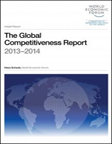 Global Competitiveness Report 2013-2014The World Economic Forum's Global Competitiveness Report offers a platform for dialogue among key stakeholders in government, business, and civil society on improving the living standards of the world’s citizens through insights on institutions, policies, and factors that drive or hinder growth and national competitiveness. Using the Global Competitiveness Index (GCI), twelve pillars are considered, including infrastructure, which, among factor-driven economies of Bangladesh, India, and Nepal, impacts the location of economic activity, reduces distance between regions, and enables production and faster flow of goods. Market size—essential for countries with small domestic markets—is another key index measured. The 2013-2014 report also includes an assessment of newly-covered Bhutan, and an analysis for the drop in India's GCI ranking. Author: Klaus Schwab Year: 2014 Download Tags: Economics, Poverty Reduction, Infrastructure, Bangladesh, Bhutan, Energy, India, Nepal, Sri Lanka, Transport Trade Facilitation and Paperless Trade ImplementationThis paper reports survey findings on progress in implementing various trade facilitation and paperless trade measures made by 29 countries in Asia and the Pacific, including six SASEC member countries. Factors considered include pre-arrival clearance, post-clearance audit, National Single Window, and authorized operator programmes. The survey reveals that while countries have prioritized automation and paperless trade at the regional level, there is an urgent need for regional arrangements that will facilitate cross-border exchange of trade-related electronic documents and information to enable smoother trade facilitation. Author: Tengfei Wang and Yann Duval Year: 2014 Download Tags: Trade Facilitation, Regional Cooperation, Trade, Asia-Pacific, SASEC, Single Window, UNESCAP, Customs, Bangladesh, Bhutan, India, Maldives, Nepal, Sri Lanka WCO News: WTO Trade Facilitation AgreementWCO News is a biannual newsletter of the World Customs Organization (WCO). This issue, released in June 2014, focuses on the World Trade Organization's (WTO) Agreement on Trade Facilitation. WCO's commitment to its implementation is highlighted and linkages between articles of the Agreement and WCO instruments and tools are explored. Also included is a feature on the benefits Authorized Economic Operator programmes bring supply chain companies. Author: World Customs Organization Year: 2014 Download Tags: Trade Facilitation, WCO, WTO, Bangladesh, Customs, India, Sri Lanka  The Merits of Regional Cooperation: The Case of South AsiaThis book makes the case for a re-strengthened South Asian Association for Regional Cooperation (SAARC), arguing that regional integration is a key factor for countries in South Asia to succeed economically and increase confidence among potential foreign investors. SAARC's inroads in improving border crossings, transport routes, and infrastructure are improving weak levels of trade within the region. However, these efforts are insufficient; they need to go hand-in-hand with further improving bilateral relations – and SAARC is in a good position to facilitate these negotiations. Spanning a wide range of subjects, including international relations, strategic affairs, environment, politics and economic issues, the publication aims to show the huge potential of South Asia as a region. Author: Siegfried O. Wolf, Paulo Casaca, Anne J. Flanagan, and Cátia Rodrigues Year: 2014 Download Tags: Regional Cooperation, ASEAN, Bangladesh, Europe, India, SAARC, South Asia 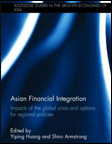 Asian Financial Integration: Impacts of the Global Crisis and Options for Regional PoliciesThe impact of the global financial crisis (GFC) reverberated deeply throughout the financial markets of Europe and the United States. In contrast, due to its relative independence from global financial markets at that time, Asia was sheltered from its painful blow. As the GFC fast-tracked the growth of Asian economies, thrusting them to the center and leading the global recovery, questions about Asia's financial future come up: how can Asian growth and development continue? This book reviews lessons learned from the GFC and looks at important Asian policy responses to the crisis, including capital account liberalization in India. It also attempts to provide a road map for the future, discussing how Asia can strengthen regional institutions and cooperate, while undertaking domestic reforms consistent with the regional and global agenda, and by proposing strategies for financial integration in the region. Author: Yiping Huang and Shiro Armstrong (eds.) Year: 2014 Download Tags: Regional Integration, Economic Integration, Asia, Europe, India Globalization in an Age of Crisis: Multilateral Economic Cooperation in the 21st CenturyIs globalization in retreat, ask editors of Globalization in an Age of Crisis. Hosting discussions on multilateralism in trade and macroeconomic issues, the book considers international policy making following the global economic crisis of 2008-2009 that saw countries prioritize policy initiatives advancing national interests over international economic cooperation. Critical junctures are considered, including the current WTO round and whether it can deliver on its promise to improve trading prospects of developing countries (chapter 3), and the compatibility of preferential trade agreements (PTAs) with multilateral trading systems (chapter 4). Empirical assessments measuring the 'successes' of existing PTAs are also included. Author: Robert C. Feenstra and Alan M. Taylor Year: 2014 Download Tags: Trade Policy, Trade, Economics, WTO 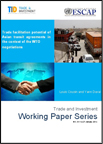 Trade Facilitation Potential of Asian Transit Agreements in the Context of the WTO NegotiationsFreedom of transit is an issue critical to landlocked developing countries whose lack of direct access to the sea has increased costs and lessened their competitiveness in international trade. To meet challenges arising from transit barriers, member states of the United Nations Economic and Social Commission for Asia and the Pacific recommend transit facilitation as part of an integrated approach to trade facilitation.
This working paper analyzes freedom of transit and transit facilitation in the context of trade and transport agreements in the Asia Pacific region, identifying good practices and weighing in on the extent to which existing agreements meet the provisions on transit facilitation stated in the draft text of the World Trade Organization Agreement on Trade Facilitation. Author: Louis Cousin and Yann Duval Year: 2014 Download Tags: Transport Facilitation, Trade Facilitation, WTO, Asia, UNESCAP, Bangladesh, Bhutan, India, Nepal Deepening India’s Shallow Export BasketIndia’s bilateral trade with the People’s Republic of China (PRC) grew to US$70 million in 2011 and growth trajectories suggest that bilateral trade will continue to expand. India exports low value-added products such as ores, cotton, and copper to the PRC; and imports high value-added and technology sophisticated products such as electrical machinery and equipment from the PRC. India suffers from lack of export diversification although manufactures are an increasing share of India’s bilateral export basket. The proposed PRC-India Free Trade Agreement (FTA) can deepen India’s export basket; and FTA-based reforms on pharmaceuticals, and information and technology services sector can significantly impact India’s bilateral trade composition. Author: Asian Development Bank Year: 2014 Download Tags: India, Trade, Trade Policy Unpacking the Bali Package: a Snapshot of Bali Ministerial Decisions of WTO MembersThe Bali Package represents a key turning point for the World Trade Organization. Covering trade facilitation, agriculture, and trade issues for developing and least-developed countries, it is set to increase trade activity on a global scale and lower the cost of doing international trade. This paper acts as a precursor to its implementation by identifying challenges countries may face, giving a brief history of each pillar, exploring the next possible steps for each ministerial decision, and examining the likely effects of this decision/agreement on various other stakeholders, particularly on consumers. Author: Archana Jatkar and Chenai Mukumba Year: 2014 Download Tags: Trade, Trade Facilitation, Trade Policy, WTO, Agriculture, Least Developed Countries, India Together We Deliver: 10 Stories from ADB-Supported Projects Together We Deliver showcases ten ADB projects across Asia and the Pacific that demonstrate clear development impacts, replicable best practices, and valuable use of innovation. Among those highlighted is SASEC's Green Power Development Project in Bhutan, which is boosting the national economy through clean energy exports to India and also funding social programs that bring electricity to more than 8,500 rural poor households. The book also features a rural road project in India that connects remote communities to schools, hospitals, and other facilities. Capturing a wide range of ADB's assistance, the book portrays how ADB is changing for better the lives of many in Asia and the Pacific region. Author: Asian Development Bank Year: 2014 Download Tags: Regional Cooperation, Bhutan, India, Development, Energy SAARC Biz: The Inevitability of South Asia SAARC Biz is a monthly publication of the SAARC Chamber of Commerce & Industry and features a report on the 'Inevitability of South Asia'. While the term 'South Asia' is commonly accepted, it argues that regionalism is far from being implemented on the ground. For instance, SAARC was accepted as a concept of cross-border regionalism but was hobbled due to budget constraints and restrictive mandates. Connectivity across national frontiers is needed to jump-start regionalism and improve lives in the most deprived parts of the Subcontinent. Author: SAARC Chamber of Commerce and Industry Year: 2014 Download Tags: South Asia, Regional Cooperation, SAARC, Industrialization, Regional Integration, Poverty Reduction, Gender, Least Developed Countries, Connectivity, Agriculture, Bangladesh, Youth, India, Environment, Investment, Tourism, Renewables Asian Development Outlook 2014: Fiscal Policy for Inclusive GrowthThe Asian Development Outlook, ADB’s flagship economic publication provides comprehensive macroeconomic analysis in Asia including growth projections by country and region. The Asian Development Outlook 2014 forecasts that developing Asia will grow 6.2% in 2014 and 6.4% in 2015. South Asia remains one of the slowest growing subregions—although growth is forecast to improve by 5.3% in 2014 and 5.8% in 2015. Author: Asian Development Bank Year: 2014 Download Tags: ADB, Bangladesh, Bhutan, Economic Corridor, Energy, India, Maldives, Nepal, Sri Lanka, Transport Simulating World Trade in the Decades Ahead: Driving Forces and Policy ImplicationsThis working paper considers economic prospects up to the year 2100, offering assumptions about key exogenous variables, providing a baseline for climate change policy evaluation, and discussing sectoral and trade issues. The paper combines an economic growth model with a multi-sectoral model to construct scenarios for around 150 countries up to a maximum time horizon of 2035, with forecasts on a number of key variables such as energy prices, demographics, etc. It suggests that trends toward increased regionalization may be reversed, with multilateral trade relationships gaining in importance. Author: Lionel Fontagné, Jean Fouré and Alexander Keck Year: 2014 Download Tags: Climate, Trade, Statistics, Trade Policy, Policy, Energy, Tariff, ASEAN, India, Environment 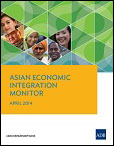 Asian Economic Integration Monitor - April 2014The Asian Economic Integration Monitor, a semiannual review of regional economic cooperation and integration in Asia covers regional economic updates, intraregional trade, financial integration and investment, and the importance of disaster risk financing instruments. The Theme Chapter: Insuring Against Asia’s Natural Catastrophes discusses market solutions and the role of government in developing disaster risk financing and strengthening financial resilience. The economic update section encourages strengthening regional cooperation in surveillance and financial safety nets, and deepening economic links. Inter-subregional trade between each subregion and the rest of Asia is rising, except in South Asia, while financial integration continues to deepen across the region. Author: Asian Development Bank Year: 2014 Download Tags: Regional Cooperation, Regional Integration, South Asia, Disaster Risk, Climate, Bangladesh, Bhutan, India, Maldives, Nepal, Sri Lanka, Transport 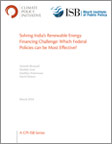 Solving India’s Renewable Energy Financing Challenge: Which Federal Policies can be Most Effective?As India works toward increasing the use of renewable energy across the country, unsubsidized renewable energy remains 52-129% more expensive than conventional energy and needs policy support. This joint publication by the Climate Policy Initiative and Indian School of Business weighs in on federal policies that can provide a solution to India's renewable energy challenge, and asks whether existing support policies are the most cost effective.
Various policies are assessed, in light of the different criteria federal policymakers consider. Existing federal policies are compared with a recommended class of debt-related federal policies using a suggested framework. The study concludes that long-term, debt-related policies are more cost-effective. The research also presents viable short-term policy options. Author: Gireesh Shrimali, Shobhit Goel, Sandhya Srinivasan, David Nelson Year: 2014 Download Tags: Energy, Climate, India Lose to Gain: Is Involuntary Resettlement a Development Opportunity?This book examines how displaced persons recover from physical and economic displacement in the South Asian context using resettlement case studies from India, Nepal, and Sri Lanka. Despite improvement in national policies and willingness to enforce good practices, the level of involuntary resettlement good practices in South Asia varies widely. There is need for greater commitment, legal reforms, and adequate resources to ensure that involuntary resettlement becomes a development opportunity for all project-affected persons. Author: Perera, Jayantha (ed.) Year: 2014 Download Tags: India, Nepal, South Asia, Resettlement, Bangladesh, Energy, Renewables, Sri Lanka, Transport Macroeconomic Update: NepalThis issue explores various dimensions of Nepal’s export competitiveness, and stresses the need to address crippling domestic supply-side constraints to boost exports. It suggests that the country needs to properly utilize technical assistance through various financing windows to address constraints such as inadequate infrastructure, political instability, labor disputes, deficiency in human resources and research and development, among others. Author: Asian Development Bank Year: 2014 Download Tags: Economics, Trade Policy, Nepal Asian Market Development and Integration: Challenges and OpportunitiesThis book, co-published by Asian Development Bank (ADB) and Korea Capital Market Institute (KCMI), in collaboration with the Peterson Institute for International Economics, examines the path of capital market development in Asia since the 2008 global crisis. It presents the analytical framework for addressing capital market integration at the regional level and its likely impacts. Author: Asian Development Bank (ADB) and Korea Capital Market Institute(KCMI), eds. Year: 2014 Download Tags: Economics, Trade Policy, Regional Integration, Bangladesh, Bhutan, India, Maldives, Nepal, Sri Lanka The Political Economy of Asian RegionalismThis book reviews the political economy of Asia's economic cooperation and integration and focuses on the innovations needed for current institutional reform in the region. It analyzes Asian regionalism after the global financial crisis including free trade agreements. The book also discusses the possible formation of a region-wide economic community. Author: Giovanni Capannelli, Masahiro Kawai Year: 2014 Download Tags: Economics, Regional Cooperation Who Shapes Climate Action in India? Insights from the Wind and Solar Energy SectorsThis report discusses climate change as a problem with domestic and international dimensions that intersect in complex ways. It focuses on the main players - including government, private sector, and civil society - by attempting to understand their influence in shaping climate change within India. Wind and solar sectors are highlighted as renewable energy is an important part of the energy mix and there has been remarkable activity in these sectors in recent years. The case studies describe key discourse and perceptions influencing renewable energy policy and the central questions shaping climate policy in India. Author: Ankur Chaudhary, Ankita Narain, Chetan Krishna and Ambuj Sagar Year: 2014 Download Tags: Climate, Energy, India Potential Growth in Emerging AsiaThis paper estimates potential growth for China, India, and five ASEAN countries during 1993-2013. It states that India has exhibited a slowdown in potential growth, reflecting a decline of total factor productivity growth. The paper also puts forward that demographic factors will be much more supportive in the future as the working-age population starts to decrease. Author: Rahul Anand, Kevin Cheng, Sidra Rehman, Longmei Zhang Year: 2014 Download Tags: Economics, India, ASEAN, Trade 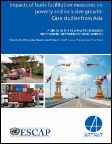 Impacts of Trade Facilitation Measures on Poverty and Inclusive Growth: Case Studies from Asia - A Study by the Asia-Pacific Research and Training Network on TradeThis book addresses the gap between trade facilitation and poverty reduction and contains a compilation of specific case studies that explores the linkages between trade facilitation measures and poverty. It also presents cross-country analysis that examines inequality in low- and middle-income countries. Other chapters discuss economic corridors and microfinance development as trade facilitation measures and examine access to trade facilitation by export-oriented micro, small, and medium-sized enterprises. It also explores barriers to international entrepreneurship for the vegetable business in Bangladesh. Finally, it offers a comprehensive evaluation of the effectiveness of Export Processing Zones (EPZs) on poverty reduction. Author: Ravi Ratnayake, Rajan Sudesh Ratna, Martina Francesca Ferracane and Yann Duval Year: 2013 Download Tags: Trade Facilitation, Bangladesh, Trade, Poverty Reduction, Economic Corridor, Small and medium enterprises, India, SAARC, Customs, Pakistan 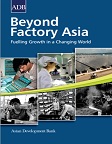 Beyond Factory Asia: Fuelling Growth in a Changing WorldThis paper assesses the challenges of Factory Asia – a model of regional networks connecting production centers in different Asian economies. It forms part of regional and global value chains and constitutes an important source of growth in the region. Regional cooperation is vital to the success of Factory Asia, which calls for greater South-South cooperation to leverage knowledge in domestic manufacturing, allowing countries such as India to leapfrog to higher value chains. For Bangladesh and Sri Lanka with small domestic markets, strategic options include carving out a niche in lower-value manufacturing. The paper further argues that policymakers should be wary of expanding or increasing the number of free trade agreements for the growth or spread of production networks. Author: Asian Development Bank Year: 2013 Download Tags: South Asia, Regional Cooperation, Trade Policy, Manufacturing, Exports, Small and medium enterprises, India, Agriculture, Bangladesh South Asia Energy Security: Challenges and OpportunitiesThe imbalance between the growing demand for energy in South Asia and the countries' uneven energy resources has led to weakened energy security in the region. Import dependence from outside the region has become a costly solution. As countries in South Asia move to expand their economies, fostering cross border energy trade and promoting energy investment opportunities could be a better alternative to resolving the energy deficit. However, energy cooperation within South Asia is challenged by major issues that could impede regional energy trade that is beneficial for all. Author: Bhupendra Kumar Singh Year: 2013 Download Tags: Energy, South Asia, Bangladesh, Bhutan, India, Nepal, Pakistan, Sri Lanka, Trade, Hydropower Reducing Poverty by Closing South Asia's Infrastructure GapThis report takes a critical look at inter-and intra-regional infrastructure of South Asia and explores inequality of access across space and time. It gives an approximate total cost of regional infrastructure needs and investment trends in the South Asia region, along with a proposed framework on ranking of infrastructure needs. The report also examines better usage of existing resources and policy options to help the poorest gain better access to infrastructure.
Finally, it recognizes the enormity of infrastructure deficiencies in South Asia and acknowledges that a good mix of infrastructure investment and supportive reform implementation will enable the region to close the infrastructure gap. Author: Luis Andrés, Dan Biller, and Matías Herrera Dappe Year: 2013 Download Tags: Transport, South Asia, Infrastructure, Energy, Roads, Railway, Water Supply, Bangladesh, Bhutan, Nepal, India, Sri Lanka, Maldives 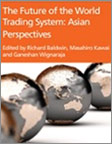 The Future of the World Trading System: Asian PerspectivesAccording to WTO Director-General Pascal Lamy, the problems facing Asian regionalism are a scaled-down version of the problems facing the world. Thus, solutions that address Asia’s noodle bowl would most likely work at the global level. This concise collection of short chapters is based on longer papers presented at the Geneva Conference on 11-12 March 2013, organized by the Asian Development Bank Institute and Centre for Trade and Economic Integration at the Graduate Institute of International and Development Studies, in collaboration with WTO. The chapters are written by leading Asian and international trade experts on key changes taking place in the world trading system and its policy implications for Asia. Author: Richard E. Baldwin, Masahiro Kawai, and Ganeshan Wignaraja, eds. Year: 2013 Download Tags: Regional Integration, Trade Policy, Trade, Global Value Chains, Global Production Network, Regional Trade, Trade Facilitation, India Connecting South Asia and Southeast Asia: Interim ReportThis joint ADB-ADBI study focuses on how improved physical connectivity (infrastructure) and associated institutional connectivity (software) can enhance more effective economic integration between the two subregions. The report reviews economic ties, identifies issues and constraints, and explores better connectivity and closer economic integration. It also examines major developments in South Asia-Southeast Asia trade and investment, economic cooperation, role of economic corridors, and regional cooperation initiatives. Author: ADB and ADBI Year: 2013 Download Tags: Infrastructure, Economic Integration, Regional Cooperation, Trade, Transport, Trade Facilitation, Economic Corridor, Energy 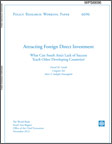 Attracting Foreign Direct Investment: What Can South Asia's Lack of Success Teach other Developing Countries?Despite South Asian nations experiencing increased foreign direct investment (FDI) flows over the past decade by gaining a large share of cross border investments, FDI inflows in South Asian countries still remain the lowest relative to gross domestic product (GDP) among developing country regions. This paper uses an empirical model that accounts for possible trends in convergence in the ratio of FDI to GDP between countries and cross-sectional data for 78 countries from 2000 to 2011. In examining the historical patterns of South Asia’s FDI and its connection with the policy environment, policymakers can identify constraints to FDI and boost potential for broad-based growth. Author: David M. Gould, Congyan Tan and Amir S. Sadeghi Emamgholi Year: 2013 Download Tags: South Asia, Trade Policy, FDI, GDP, Investment, Governance, Transparency, Economic Growth, Financial Sector, Regional Cooperation, Trade UNCTAD Handbook of Statistics 2013This UNCTAD Handbook of Statistics provides essential data for analyzing and measuring world trade, international financial flows, investment, and development. It documents the south-south trend led by developing Asia and reveals how exports among developing countries remain centered in the Asian region. The share of south-south trade in total world exports doubled over the last 20 years to over 25 per cent. Apart from The People's Republic of China and other major petroleum and gas exporters, India is among the countries that have most expanded their south-south trade during the last two decades. Author: United Nations Conference on Trade and Development Year: 2013 Download Tags: South Asia, Statistics, Trade, India Evaluating Aid for Trade on the Ground: Lessons from BangladeshThis paper assesses the effectiveness and impact of aid for trade (AfT) in Bangladesh in a series of eight country studies by the International Center for Trade and Sustainable Development. The study argues that the results for AfT are mixed for Bangladesh since it has addressed supply side constraints and contributed to enhancing export competitiveness. However, lack of efficient administrative mechanisms, limited human capacity, and political instability that lead to low absorption capacity limits the overall effectiveness and impact of AfT in Bangladesh. Author: Fahmida Khatun, Samina Hossain and Nepoleon Dewan Year: 2013 Download Tags: Bangladesh, Trade, Aid for Trade, Sustainability, Export, Development, Asia, Gender, LDC, Least Developed Countries The ASEAN Economic Community: A Work in ProgressThis publication explores the barriers and impediments to the realization of an ASEAN Economic Community (AEC), and to what extent its self-imposed deadline of 2015 for achievement of an AEC is more of a milestone of progress than a firm target. It examines whether the AEC is achievable, the obstacles faced in achieving it, and the measures required to help it become a reality. Author: Asian Development Bank Year: 2013 Download Tags: Regional Cooperation, Regional Integration, Trade Policy, ASEAN, Economic Integration, Regional Cooperation, ADB, Regional Integration, Services, Global Value Chains, Non-Tariff Measures, Asia-Pacific Trade Agreement, India, Trade Facilitation ADB Regional Cooperation Operations Business Plan (RCOBP) 2014-2016 for South AsiaADB's third Regional Cooperation Operations Business Plan (RCOBP) 2014-2016 for South Asia under its South Asia Regional Cooperation Strategy (RCS) 2011-2015 details a cumulative indicative lending program of $3.3 billion and maintains focus on improved regional connectivity, increased cross-border trade, and strengthened regional economic cooperation. Author: Asian Development Bank Year: 2013 Download Tags: Regional Cooperation, Regional Integration, Bangladesh, Bhutan, India, Maldives, Nepal, Sri Lanka, Trade Facilitation, Transport, Energy, SAARC Review of Developments in Transport in Asia and the Pacific 2013While transport has been an essential element in the rapid growth and economic development of Asia and the Pacific, the sector is now at a crossroads more than ever before. Rocketing demand for transport services is putting extreme pressure on existing infrastructure at a time when public budgets are constrained and awareness about the negative externalities of transport activities is growing. Author: United Nations Year: 2013 Download Tags: Transport, Infrastructure Deepening Economic Cooperation between India and Sri LankaThis book analyzes the performance and impact of the India-Sri Lanka free trade agreement over the past decade and suggests the way forward. India became an important source of imports for Sri Lanka immediately after the implementation of the free trade agreement. Author: Asian Development Bank Year: 2013 Download Tags: Regional Cooperation, Trade Policy, India, Sri Lanka, Trade, Economic Cooperation, India-Sri Lanka Free Trade Agreement, Free Trade Agreements, Services, Trade Facilitation, Exports, Import Who Profits from Trade Facilitation Initiatives?This Asia-Pacific Research and Training Network on Trade (ARTNeT) Working Paper uses firm-level data on developing countries to investigate whether large firms benefit from trade facilitation. The findings show that firms of all sizes export more in response to improved trade facilitation. Trade facilitation can be beneficial to countries, including those engaged as suppliers in value chains. Author: Bernard Hoekman and Ben Shepherd Year: 2013 Download Tags: Trade Facilitation, Trade Policy World Development Indicators 2013This 2013 World Development Indicators report compiles important statistics about global development organized around six themes- world view, people, environment, economy, states and markets, and global links. Relevant market changes, such as the rise in foreign direct investments or the decrease in official development assistance, are tracked. It also contains a hyperlinked index to comprehensive indicator data available online. Author: World Bank Year: 2013 Download Tags: Statistics, Development Financing Low-Carbon UrbanDevelopment in South Asia: A Post-2012 Context The cities of South Asia are growing at an unprecedented rate. Currently, the region
accounts for 5 of the world's 26 megacities (Delhi, Dhaka, Karachi, Kolkata, and
Mumbai),with Kolkata and Mumbai being the most dense. The urban population in
India is expected to increase by 20.8 percentage points between 2010 and 2050 compared
to 7.8 percentage points in Latin America and the Caribbean. These trends necessitate bold
efforts in project design and financing to steer this rapid urbanization onto an inclusive, green,
and low-carbon urban development path. Author: Asian Development Bank Year: 2013 Download Tags: Climate, Energy, India, South Asia, Kyoto Protocol, Bangladesh, Bhutan, Nepal, India, Maldives, Sri Lanka ARIC Information Pack: October 2013The ARIC Information Pack compiles news and events on regional cooperation & integration (RCI) that corresponds to ADB's four RCI pillars: cross-border infrastructure, trade and investment, money and finance, and regional public goods. A special feature on the implications of the US recovery to Asian exports also appears in this issue. Author: Asian Development Bank Year: 2013 Download Tags: Regional Cooperation, Regional Integration, ADB, SASEC Bhutan Critical Development ConstraintsBhutan 2020: A Vision for Peace, Prosperity and Happiness embodies the development philosophy
of His Majesty King Jigme Singye Wangchuck and sets out directions that will enable Bhutan to
execute this philosophy while at the same time retaining its commitment to its distinctive model
of harmonious and balanced development. Author: Asian Development Bank / Australian Government / Japan International Cooperation Agency Year: 2013 Download Tags: Bhutan, Development Aid for Trade: An Investment Benefit Road Map for South AsiaAid for Trade (AfT) came to prominence just over a decade ago at the launch of the
World Trade Organization's Doha Round. With its focus on helping least developed
countries and economies escape the poverty trap, it aims to strengthen their
capabilities to meet market demand and to reduce supply-side constraints such as a lack of
trade infrastructure. Author: Asian Development Bank Year: 2013 Download Tags: Trade Policy, Poverty Reduction, Infrastructure, India, Bangladesh, Bhutan, Maldives, Sri Lanka, Nepal, Trade Facilitation, Transport, Global Value Chains, Exports Energy Outlook for Asia and the Pacific: October 2013The Energy Outlook for Asia and the Pacific aims to support ADB energy sector operations
by providing stakeholders with an energy outlook for the region up to the year 2035.
It attempts to identify policy, social, infrastructure, and technology issues that must be
addressed to meet future energy need of ADB members in Asia and the Pacific. Author: Asian Development Bank Year: 2013 Download Tags: Energy, Infrastructure, Renewables, Hydropower, Transport, Bangladesh, Bhutan, India, Nepal, Maldives, Sri Lanka Climate Action South Asia: Information Update No. 3 (The Economics of Climate Change in South Asia: Adaptation and Impact Assessment)Analyses show that the cost of early action on climate change in South Asia is lower than
the cost of damage brought about by climate change impacts. In physical terms, the region
will face water shortage and agricultural food production losses, which are vital to achieving
poverty reduction and other Millennium Development Goals (MDGs). Author: Asian Development Bank Year: 2013 Download Tags: Economics, Climate, Agriculture, Climate Change, Environment, South Asia, Milennium Development Goals, Sustainability, Bangladesh, Bhutan, India, Nepal, Maldives, Poverty Reduction, Hydropower, Energy Climate Action South Asia: Information Update No. 2 (Economics of Reducing Greenhouse Gas Emissions in South Asia: Options and Costs)The study Economics of Reducing Greenhouse Gas Emissions: Options and Costs in Bangladesh, Bhutan, the Maldives, Nepal, and Sri Lanka reveals excellent opportunities in low-carbon green growth by pursuing resource- and energyefficient technologies that would lower emissions of greenhouse gases at low cost or even cost saving (benefits). Author: Asian Development Bank Year: 2013 Download Tags: Economics, Climate, Climate Change, Economics, South Asia, Bangladesh, Bhutan, Maldives, Sri Lanka, Energy, Environment, Sustainability, ADB, Nepal, Development, Hydropower 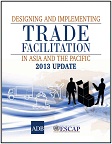 Designing and Implementing Trade Facilitation in Asia and the PacificThis reference book was published to support the implementation of trade facilitation measures and reforms in Asia and the Pacific. It includes operational guidance on assessing the status of trade facilitation, the measures and reforms needed, how to design trade facilitation initiatives, and how to implement them at national and regional levels. The book is intended to assist policy makers, practitioners, and economists by bridging the gap between theory and practice. The revised 2013 version includes updated statistical figures and data, information on actual trade facilitation policies and practices, and the most recent research on trade facilitation. Author: Asian Development Bank / United Nations Economic and Social Commission for Asia and the Pacific Year: 2013 Download Tags: Trade Facilitation, Regional Cooperation, Regional Integration, Trade Policy, Economic Corridor, Sanitary and Phytosanitary Measures, Technical Barriers to Trade, Revised Kyoto Convention, Customs, Customs Valuation, Bangladesh, Bhutan, India, Nepal, Maldives, Sri Lanka, Services Asia-Pacific Trade Facilitation Forum: Survey on Trade Facilitation and Paperless TradeConducted jointly by the Asian Development Bank and the United Nations Economic and Social Commission for Asia and the Pacific, this survey provides a status snapshot of trade facilitation in place across 26 countries of the region, including progress towards establishment of national trade facilitation committees, implementation of risk management measures, development of national single windows, and steps taken to move toward paperless trade. It further examines specific issues and challenges in these areas of South East Asian countries, and provides recommendations for improvement. Author: ADB and UNESCAP Year: 2012 Download Tags: Trade Facilitation, Paperless Trade, Bangladesh, Bhutan, India, Nepal, Maldives, Sri Lanka, Customs, Transport Facilitation, Myanmar, National Single Window Unlocking Bangladesh-India Trade: Emerging Potential and the Way ForwardThis working paper breaks down the importance of trade cooperation between Bangladesh and India by taking a closer look at the impacts of Bangladesh's increased market access to India, and their improved border connectivity. Employing data from national government resources and multilateral development organizations including the International Monetary Fund, World Bank, and World Trade Organization, the study provides an estimate of the trade potential of Bangladesh and India, and calculates the implications on costs of trade facilitation, among others. It also discusses ongoing challenges in bilateral relations and provides recommendations that will enable larger gains for the two contiguous countries. Author: Prabir De, Selim Raihan, and Sanjay Kathuria Year: 2012 Download Tags: Trade, Trade Facilitation, Regional Cooperation, Bangladesh, India, WB, WTO, Bilateral Trade Climate Action South Asia: Information Update No. 1 (Development in an Era of Accentuated Climate Risks)To steer South Asian economies toward green, low-carbon, and climate-resilient development and for these to take hold in South Asia, the countries need (i) better understanding and greater public awareness of the implications of climate change, (ii) climate risks screening and decision-support tools for identifying actions and managing results, (iii) improved governance and institutional capacities to take necessary actions to manage climate change impacts, (iv) funding sources for such actions, and (v) projects and programs demonstrating positive results that can be scaled up. Author: Asian Development Bank Year: 2012 Download Tags: Economics, Climate, Climate Change, Environment, Sustainability, South Asia, Development, Economic Growth, ADB Regional Integration and Economic Development in South AsiaSouth Asian leaders have made it a priority to tackle key regional issues such as poverty, environment degradation, trade and investment barriers and food insecurity, among others. This book considers the leadership of the South Asian Association for Regional Cooperation (SAARC) and the interaction with civil society in the process of South Asian regional cooperation and integration, and discusses how the emerging urgency in the provision of regional public goods provides an excellent opportunity to add to the successes in South Asian regional integration. Author: Sultan Hafeez / Rahman Sridhar Khatri / Hans-Peter Brunner Year: 2012 Download Tags: Economic Corridor, Regional Cooperation, Regional Integration, SAARC, SAFTA, Bangladesh, Bhutan, India, Maldives, Nepal, Sri Lanka Sector Roadmaps with Result FrameworksSector roadmaps with result frameworks for transport, energy, and trade facilitation. Author: Asian Development Bank Year: 2011 Download Tags: Trade Facilitation, Energy, Transport, Bangladesh, Bhutan, India, Maldives, Nepal, Sri Lanka Regional Cooperation and Integration Through Cross-Border Insfrastructure Development in South AsiaThis paper aims to identify the links between cross-border infrastructure development and poverty reduction. With South Asia being home to around 40% of the world's poor, there is a great need to boost intraregional trade through greater cooperation and integration. Regional integration promises to increase the region's capacity to connect with global production networks and participate in the global economy with greater efficiency. Author: P.V. Srinivasan Year: 2011 Download Tags: Regional Cooperation, Regional Integration, South Asia, Bangladesh, Bhutan, India, Maldives, Nepal, Sri Lanka, Poverty Reduction South Asia- Intra Regional Cooperation: The Way ForwardThis study aims to showcase the benefits of regional integration and recommends strategies for overcoming the many hurdles. Author: Shahid Kardar Year: 2011 Download Tags: Policy, Economic Cooperation, Regional Integration, Development, SAARC, Non-Tariff Measures, Trade Facilitation, SAFTA, India, Bangladesh, Bhutan, Maldives, Nepal, Sri Lanka, BIMSTEC, Myanmar, SASEC, Energy 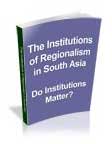 The Institutions of Regionalism in South Asia - Do Institutions Matter?This paper assesses the contribution of key institutions of regional cooperation and integration (RCI) in South Asia, and suggests ways in which the Asian Development Bank and other development partners can strengthen their support. It attempts to enhance understanding on the interplay between politics and RCI, including how good bilateral political relations or improvements have advanced RCI. With the overall political environment growing increasingly open to RCI, the paper suggests the time has come for the South Asian Association for Regional Cooperation (SAARC) to consider strengthening the capacity of the SAARC Secretariat to meet the growing challenges and work load of managing the anticipated increase in RCI. Author: Prabhu Ghate Year: 2011 Download Tags: Regional Cooperation, Regional Integration, Development, SAARC, Trade, Services, Trade Facilitation, Energy, Free Trade Agreements, SAFTA, Bangladesh, Bhutan, India, Maldives, Nepal, Sri Lanka, Transport Energy Trade in South Asia: Opportunities and ChallengesThe South Asia Regional Energy Study was completed as an important component of the regional technical assistance project Preparing the Energy Sector Dialogue and South Asian Association for Regional Cooperation Energy Center Capacity Development. It involved examining regional energy trade opportunities among all the member states of the South Asian Association for Regional Cooperation. The study provides interventions to improve regional energy cooperation in different timescales, including specific infrastructure projects which can be implemented during these periods. Author: Sultan Hafeez Rahman / Priyantha D. C. Wijayatunga / Herath Gunatilake / P. N. Fernando Year: 2011 Download Tags: Energy, Regional Cooperation, Regional Integration, SAARC, Trade, Bangladesh, Bhutan, India, Nepal, Maldives, Sri Lanka Gas Hydrates Resource Potential of South AsiaThe amount of natural gas worldwide is estimated to be greater than the entire world’s conventional natural gas resources, which makes gas hydrates a potential energy resource for the future. This document reviews the status of technology regarding exploration and exploitation of gas hydrates, as well as research initiatives by India and other countries of the South Asian Association for Regional Cooperation (SAARC). It also suggests a mechanism for technology transfer and promotion of research and development in the SAARC region. Author: SAARC Energy Centre Year: 2010 Download Tags: Energy, South Asia, SAARC The Provision of Regional Public Goods in South AsiaThis report reviews the provision of high priority regional public goods (RPGs) selected
for the South Asia subregion, and proposes areas of cooperation for improving the provisioning of RPGs in South Asia. It highlights the issues in cross border management of infrastructure projects and best practices in the provisioning of RPGs relevant for South Asia, evaluates ADB’s contributions to providing RPGs in the subregion, and concludes with recommendations on ADB’s South Asia Regional Department’s role in the provision of RPGs in the subregion. Author: Khaja Moinuddin Year: 2010 Download Tags: Energy, Agriculture, Disaster Risk, Governance, Poverty Reduction, Bangladesh, Bhutan, India, Maldives, Nepal, Sri Lanka, Trade Facilitation, Transport Binding Contraints to Regional Cooperation and Integration in South AsiaThis paper examines the benefits of regional cooperation and integration, focusing on the cost of neglecting to address the binding constraints to regional cooperation and integration. Component papers in this volume analyze the current state of play, and identifies the binding constraints to achieving more efficient transport corridors, regional energy trade and trade facilitation in the region. Author: Gilberto M. Llanto Year: 2010 Download Tags: Regional Cooperation, Economic Integration, Trade Facilitation, Energy, Bangladesh, Bhutan, India, Maldives, Nepal, Sri Lanka, Transport Infrastructure for a Seamless AsiaThe study reviews regional infrastructure being enhanced through regional cooperation in Asia and examines major issues and challenges. It suggests a framework for pan-Asian infrastructure cooperation, anchored on a long-term vision of creating a seamless Asia that will not only enhance the region's competitiveness and extend its global reach, but also help reduce poverty and promote greater environmental sustainability. Author: Asian Development Bank / Asian Development Bank Institute Year: 2009 Download Tags: Regional Cooperation, Regional Integration, Transport, Trade Facilitation, Connectivity, India, Bangladesh, Bhutan, Nepal, Maldives, Sri Lanka, Asian Highway, Trans-Asian Railway Network, Energy, Myanmar Pan-Asian IntegrationIn today's globalized world where the economic fates of nations are inevitably linked, weathering the present economic storm for Asia will increasingly depend on harnessing regional dynamics particularly on the trade front. Pan-Asian Integration: Linking East and South Asia is a rich volume of perspectives from leading thematic experts on regional patterns of trade and investment, trade-related infrastructure, trade facilitation, among others. Author: Asian Development Bank Year: 2009 Download Tags: Regional Cooperation, Regional Integration, Trade Policy, Transport, Trade Facilitation, Economics, India, Free Trade Agreements 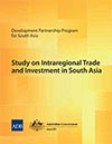 Study on Intraregional Trade and Investment in South AsiaThis study broadens and deepens intraregional cooperation and integration in trade and investment among South Asian countries. It showcases the benefits of regional integration and presents an array of policy recommendations to maximize and realize such gains. Three parallel initiatives are needed: first, reduce nontariff barriers to deepen the South Asian Free Trade Area (SAFTA); second, expand SAFTA's scope to include investments and services; and third, focus on key industries to succinctly demonstrate the process and benefits of reforms. These translate into six component studies: (i) the Role of Trade Facilitation in South Asian Economic Integration; (ii) Country Investment Studies for Bangladesh, India, Nepal, and Sri Lanka; and (iii) Textile and Clothing Industry. The study invigorates the debate and focus on South Asian integration as a means to further growth and reduce poverty. Author: Asian Development Bank / Australian Government Year: 2009 Download Tags: Trade Policy, Trade Facilitation, Regional Cooperation, Regional Integration, Bangladesh, India, Nepal, Sri Lanka, SAFTA Quantification of Benefits from Economic Cooperation in South AsiaThe study examines the implication of the South Asian Free Trade Agreement (SAFTA) on South Asian countries and on the region as a whole, employing both a quantitative and qualitative assessment on the outcomes of SAFTA. The research aims to provide support in the formulation of concrete policy measures for trade to ensure greater gains for the region, while at the same time mitigating potential negative impacts. Economic and social assessments through analytical tools and rational causal chain analysis further enrich the study. Author: Asian Development Bank / United Nations Conference on Trade and Development Year: 2008 Download Tags: Economic Corridor, Regional Cooperation, Regional Integration, SAFTA, Free Trade Agreements, Trade Facilitation, Transport, Services, SAARC, Bangladesh, Bhutan, India, Maldives, Nepal, Sri Lanka Emerging Asian Regionalism-A Partnership for Shared ProsperityThe study summarizes important issues related to Asian regionalism. Viewing regional cooperation as a necessary tool for coping with the consequences of interdependence, the book discusses several pressing issues, such as integrating production, improving financial cooperation, and managing macroeconomic interdependence to create a stable architecture for an Asia-wide cooperation. Author: Asian Development Bank Year: 2008 Download Tags: Economic Corridor, Regional Cooperation, Regional Integration, Asia, ASEAN, SAARC, Bangladesh, Bhutan, India, Nepal, Maldives, Sri Lanka SASEC ICT Development Master PlanThis report represents the first comprehensive multilateral ICT development plan. Its primary objective is to create a framework that will support the already existing ICT plans of Bangladesh, Bhutan, India, and Nepal and help these SASEC countries collaborate more effectively with each other. Author: Asian Development Bank Year: 2006 Download Tags: ICT, Regional Cooperation, Regional Integration, SASEC, Bangladesh, Bhutan, India, Nepal Cross- Border Private Sector Cooperation in ICT Among SASEC CountriesThis study explores the issue of cross-border cooperation in ICT among private sectors in Bangladesh, Bhutan, India, and Nepal. It discusses the ICT policy frameworks of the four SASEC countries, and gives an update on improvements in their ICT infrastructure and the state of their ICT infrastructure linkages. It further provides a set of recommendations for the way forward. Author: Asian Development Bank Year: 2004 Download Tags: ICT, Regional Cooperation Management Development and Institution Building in SASEC CountriesThe study identifies challenges in management development in the four SASEC countries by comparing institutional development in Bhutan, Nepal, and Bangladesh universities with the experience of the Indian Institutes of Management (IIMs). It discusses long-term strategies and alternatives to strengthen the management development capacity in the region and support private sector needs. Author: Sushil Khanna Year: 2004 Download Tags: Development, India |



